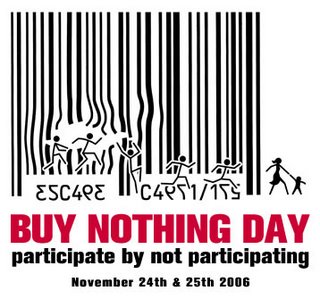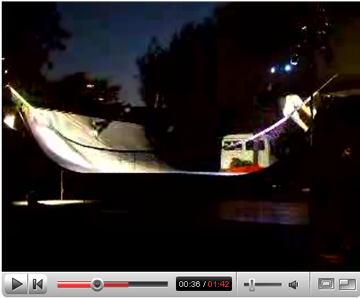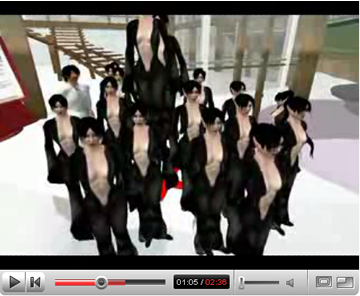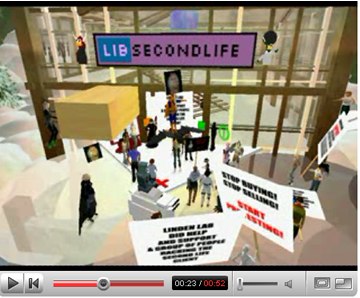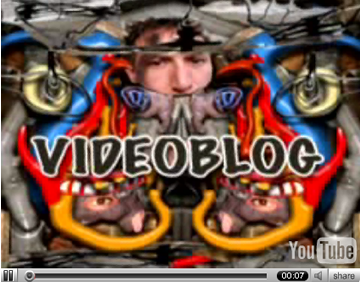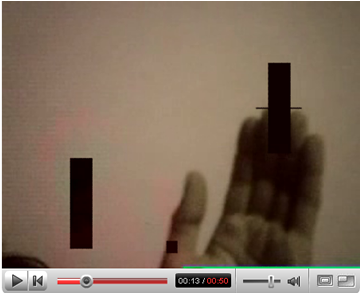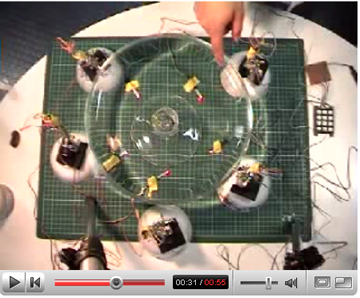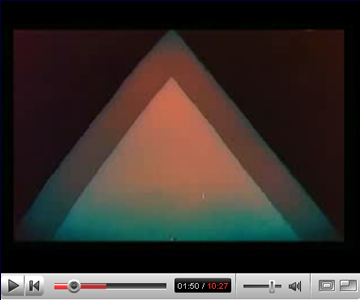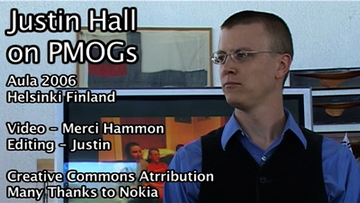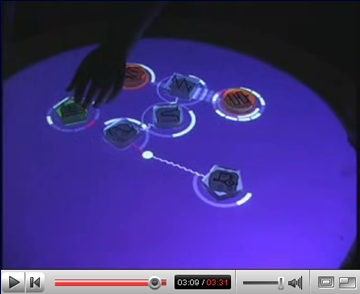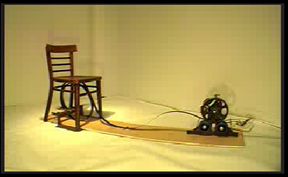« October 2006 | Main | December 2006 »
November 28, 2006
Upgrade! International: DIY Oklahoma City
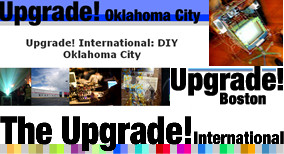
Upgrade! Boston
Upgrade! International: DIY Oklahoma City :: November 30-December 3, 2006 :: International Upgrade! organizations and their artists will converge in Oklahoma City to present art and ideas to each other and the community in the second annual international symposium. Included in the event will be workshops on art and technology, audio/video performances and presentations, and exhibitions of works by international and regional artists representing this year’s theme: DIY (Do-It-Yourself). Upgrade! Boston will contribute the following:
DIY or Die: An Upgrade! New York, Turbulence, and Rhizome Net Art Exhibition :: In celebration of their respective ten-year anniversaries, Turbulence and Rhizome collaborated with Upgrade! New York to present an exhibition of works that they commissioned or presented over the course of their histories. The term D.I.Y. (or do-it-yourself) expresses an independent ethos, one that encourages cultural producers to create and distribute work outside mainstream or commercial systems and often in direct confrontation with them.
In this case, D.I.Y refers not only to works in the show, many of which create alternate models for collaborative artmaking, community building, and media distribution, but to the organizations themselves whose missions--to commission and present digital art work--had no tradition or cultural niche to call upon. Historically, net artists have included audiences in their work; many created calls to action that compel their audiences to intervene and contribute their own ideas, stories and histories. From re-purposed commercial software to homegrown digital knitting applications and works that offer alternative constructions of identity and nationality, D.I.Y. OR DIE presents a cross-section of Internet-based art that, much like punk and grassroots activism has the urgency and invention required to change existing standards of art practice.

Imaging Oklahoma City by John (Craig) Freeman :: Participants will go out into the streets to produce the material for "Imaging Oklahoma City." "Imaging Place," is a place-based, virtual reality art project that takes the form of a user navigated, interactive computer program combining panoramic photography, digital video, and three-dimensional technologies to investigate and document situations where the forces of globalization are impacting the lives of individuals in local communities.
Artist and educator John (Craig) Freeman's work has been exhibited internationally including at the Kaliningrad Branch of the National Center for Contemporary Arts, Russia; and Ciberart Bilbao, Spain. In 1992 he was awarded an Individual Artist Fellowship from the National Endowment for the Arts. Lucy Lippard cites Freeman's work in "The Lure of the Local".

networked_performance: participatory art by Helen Thorington :: The networked_performance blog chronicles network-enabled practice, discloses a wide range of perspectives, and uncovers commonalities. Artists are utilizing technologies that are inexpensive, mobile and wirelessly networked. Thorington will review works - from telematic and locative events to wearables, and responsive objects and environments - and show how they use objects and events from everyday life to create work that is characteristically hybrid, performative and relational.
Helen Thorington is a writer, sound composer, and radio producer whose radio documentary, dramatic work, and sound/music compositions have been aired nationally and internationally. Thorington has created compositions for film, installation and dance. She performed with the Bill T. Jones/Arnie Zane Dance Company at The Kitchen, New York City in 2003. Her articles on networked musical performances are published in the December 2005 and February/April 2006 issues of Contemporary Music Review.
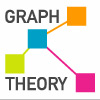
Participation, Technology, and Musical Performance by Jason Freeman :: Jason Freeman breaks down conventional barriers between composers, performers, and listeners, using new technology and unconventional notation to turn audiences and musicians into compositional collaborators. He will discuss "Glimmer", "N.A.G.", and "Graph Theory" which connects composition, listening, and concert performance by coupling an acoustic work for solo violin/cello to an interactive web site. There will be a ten minute performance of "Graph Theory."
Jason Freeman received his D.M.A. in composition from Columbia University. His music has been performed by the American Composers Orchestra, Speculum Musicae, the So Percussion Group, the Nieuw Ensemble, Le Nouvel Ensemble Moderne, and Evan Ziporyn; and his interactive installations and software art have been exhibited at the Lincoln Center Festival, and the Transmediale Festival.
A Day in the Life with Burak Arikan
A DAY IN THE LIFE is a platform for simultaneous global performances and a base for international collaborations. Urban spaces in MUNICH, OKLAHOMA CITY, BOSTON and ISTANBUL will be connected with each other via a streaming video server. The full performance will only be complete when all four locations are viewed simultaneously. A DAY IN THE LIFE was conceived by Horst Konietzny and Tamiko Thiel of Upgrade! Munich.
BURAK ARIKAN is contributing Upgrade! Stock Market, in which participating Upgrade nodes (Boston, Istanbul, Munich and Oklahoma City) will become traded companies. Each Upgrade node will have 100 shares. Sensors mounted at the entrance to the gallery will register how many people are in the room at any one time and send this information to a central server. Each node will gain or lose value depending on the number of people in its local space.
Burak Arikan is an artist and designer creating systems that evolve with the interactions of people and machines. He shows the instances of these systems through diverse media including prints, animation, software, electronics, and physical materials. His work has recently been shown at Ars Electronica, and the Venice Biennale. Arikan recently completed his master's degree at the MIT Media Laboratory in the Physical Language Workshop (PLW) led by John Maeda.
Upgrade! International: DIY Oklahoma City
John (Craig) Freeman
A Day in the Life
DIY or DIE
Helen Thorington
Jason Freeman
DIY Recipe [PDF] [catalogue entry for Upgrade! Boston]
Posted by jo at 01:10 PM | Comments (0)
November 27, 2006
See you next week!
Upgrade! International Oklahoma City
Posted by jo at 08:46 PM | Comments (0)
Upgrade! International: A Day in the Life
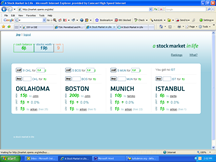
Stock Market
Upgrade! A Day in Life events take place in four cities simultaneously. Urban spaces in Oklahoma City, Boston, Munich, and Istanbul will be connected with each other via a streaming video server for the duration of the event. For each location, sensors mounted in the entrance register how many people are in the room at any one time and send this information to the Stock Market central server. The number of visitors define the fair value for each place.
The stock market uses this value generated by the immaterial labor of visitors. Each location has 100 shares and the shares gain or lose value depending on the speculations in the market and the number of people in the local rooms. You can contribute to the value either by just visiting the physical locations or by trading in the online stock market. Get your shares now!
The Upgrade! Stock Market is a project by Burak Arikan. Other Upgrade! Boston events >>
Posted by jo at 02:09 PM | Comments (0)
First Generation:
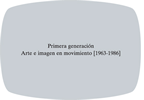
Art and the Moving Image, 1963-1986
First Generation: Art and the Moving Image, 1963-1986 :: November 7, 2006 - April 2, 2007 :: Museo Nacional Centro de Arte Reina Sofía, c/ Santa Isabel, 52, 28012 Madrid (Spain).
First Generation: Art and the Moving Image, 1963-1986 has the intention of presenting in a contextualized manner the historic core of the Museo Nacional Centro de Arte Reina Sofía's video collection. It has been built up in recent years with the goal of laying solid foundations upon which the collection could grow. Curated by Berta Sichel, director of the Museum's Audiovisual Department, the exhibition aims to reconstruct a history which has been neglected for a long time via the acquired works and with the support of a small yet significant group of works on loan to cover existing gaps. The exhibition has been organized around the different approaches and ideas of the artists who worked with video during the first 25 years of this medium. These include the inspiration of Fluxus, the critique of commercial television, the relationship between the medium and the viewer, feminism, performance and the legacy of minimalism and conceptual art.
Not a thematic exhibition, it does not try to follow a strict chronological order either. Rather, it is a vision of how and why a technology of recording, broadcasting and reproducing sound and images, which emerged in 1950 —and technically different than cinema— became an artistic medium. It is also a “study” of the influence technology and mass culture on the social and artistic changes of an era, at a time when cultural acceleration and the cross-pollination of ideas was beginning. In this sense, the year l963 is a landmark for the history of video. Wolf Vostell showed for the first time the installation 6 TV Dé-Coll/age at Smolin Gallery, New York City. Nam June Paik, then living in Germany, had his first exhibition at Galerie Parnass in Wuppertal. Music Electronic Television consisted of twelve altered TV sets, four adapted pianos in the same spirit of John Cage and, in the most genuine Fluxus Spirit, the head of a freshly-slaughtered ox hanging above the g allery's entrance.
1986 was not chosen randomly as the final year. In this timeframe a group of artists from the first generation had achieved international recognition and the young artists started to work in much larger media arts practices, using a wide range of hybrids which have opened a new chapter in the history of art and moving images. The mid 1980s also reflected a change in criticism, with theories of postmodernism and post colonialism raising questions of historiography and subjectivity. Consequently, the year this exhibition closes the term video art was already considered historic.
To tell this story, the exhibition diplays 32 video installations by the main artists belonging to this first generation: Eugènia Balcells, Dara Birnbaum, Jaime Davidovich, Juan Downey, VALIE EXPORT, Rafael França, David Hall, Gary Hill, Takahiko iimura, Joan Jonas, Shigeko Kubota, Thierry Kuntzel, David Lamelas, Mary Lucier, Antoni Muntadas, Nam June Paik, Ulrike Rosenbach, Carolee Schneemann, Ira Schneider, Bill Viola, Wolf Vostell, Roger Welch, Robert Whitman and Hannah Wilke; as well as 14 single-channel projections by: Marina Abramovic, Vito Acconci, Joseph Beuys, Peter Campus, Douglas Davis, Anna Bella Geiger, Joan Logue, Ana Mendieta, Marta Minujín, Bruce Nauman, Otto Piene and Joan Rabascall/Benet Rossell.
The exhibition closes as it opens: with works by Nam June Paik and Wolf Vostell. Mirage Stage (1986) by Paik, and a video recording of his performance with the cellist Charlotte Moorman, made by Otto Piene the same year; and New York Stuhl (l976) by Vostell that immerses us in a state of total amnesia about the origin of information.
A reference area consisting of 80 single-channel videos in a database complements the content of the show. This format allows visitors to make their own connections and discoveries, to interpret and reinterpret the history of the first generation of video artists, and to arrive at a new understanding of video work from its beginnings up to 1986.
For more information and photographic material please contact:
e-mail: prensa3.mncars@cars.mcu.es, tel: +34 91 774 1005, fax: +34 91 774 1009
Posted by jo at 08:25 AM | Comments (0)
UpStage
![]()
Open Walk-Thru and ADA Swaray
The last UpStage open walk-thru for 2006 will be combined with the last ADA Swaray for the year, and held on Wednesday December 6 at 9:00 pm NZ time. To join the online festivities, just point your browser here at party time (we have some surprises up our cyber-sleeves!). To find your local time, go here. If you'd like to log in and play, email me for a username.
Helen Varley Jamieson: helen[at]creative-catalyst.com
http://www.creative-catalyst.com
http://www.avatarbodycollision.org
http://www.writerfind.com/hjamieson.htm
Posted by jo at 08:20 AM | Comments (0)
November 25, 2006
Networking
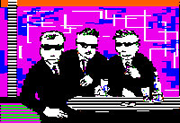
The Net as an Artwork
Networking: The Net as an Artwork represents a first tentative reconstruction of the history of artistic networking in Italy, through an analysis of the realities which during the past twenty years have given way to a creative, shared and aware use of technologies, from video to computers, contributing to the formation of Italian hacker communities.
Written by Tatiana Bazzichelli, with the preface of Derrick De Kerckhove and the epilogue of the videoartist Simonetta Fadda. Networking means to create nets of relations, by sharing experiences and ideas in order to communicate and experiment artistically and where the publisher and the reader, the artist and the public, act on the same level.
In Italy, thanks to the alternative use of Internet, during the past twenty years of experimentation a vast national network of people who share political, cultural and artistic views has been formed. Active in underground environments, these projects use diverse media (computers, video, television, radio and magazines) and deal with technological experimentation, or hacktivism, depending on the terminology used in Italy, where the political component is a central theme.
The Italian network proposes a form of critical information, diffused through independent and collective projects where the idea of freedom of expression is also a central theme.
The book describes the evolution of the italian hacktivism and net culture from the Eighties till today. At the same time, it builds a reflection on the new role of the artist and author who become networker, operating in collective nets, reconnecting to neoavant-garde artistic practices of the 1960’s (first and foremost Fluxus), but also Mail art, Neoism and Luther Blissett.
A path which began in BBS, alternative web platforms diffused in Italy half way through the 1980's even before Internet even existed, and then moved on to Hackmeetings, to Telestreet and networking art of different artists such as 0100101110101101.ORG, [epidemiC], Jaromil, Giacomo Verde, Giovanotti Mondani Meccanici, Correnti Magnetiche, Candida TV, Tommaso Tozzi, Federico Bucalossi, Massimo Contrasto, Mariano Equizzi, Pigreca, Molleindustria, Guerriglia Marketing, Sexyshock, Phag Off and many others. [download the book (PDF)] [via]
Posted by jo at 05:38 PM | Comments (0)
Futures of Entertainment
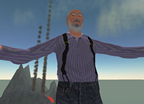
New Media, Fan Muscle will mold TV future
[Image: Henry Jenkins' Second Life avatar] How will we enjoy entertainment in the future? Via a high-definition plasma TV screen, computer, cellphone or iPod? Who will create entertainment? Will it be mega studios, independent producers or the whiz kid on his laptop--or a network of whiz kids? And who will watch the result when the audience is also the writer, critic and marketer?
Experts--from network executives, academics and game designers to gadfly media artists--peered into the "Futures of Entertainment" at a two-day conference, Nov. 17-18, sponsored by the MIT comparative media studies program and the Convergence Culture Consortium. The future they sketched reached way beyond the buzzword of "interactivity" to a time when the line blurs between media producer and media consumer.
"We now live in a networked society where we're seeing the ability of communities to rapidly pool information," said Henry Jenkins, director of the comparative media studies program and conference organizer. "This new environment both creates community opportunities and creates activities for this community."
His examples? Characters on "Veronica Mars" have MySpace.com profiles. Fans plot the resistance movement of "The Matrix" trilogy. Fans decipher maps flashed during "Lost" or use Google's map technology to track the fictional journey of Jack Bauer in "24." Dialogue of the movie "Snakes on a Plane" is changed to fit Internet expectations.
"It is an age when we all want to participate and we want to see ourselves participate," Jenkins said.
The death of must-see TV
In a session on "Television Futures," panelists questioned whether the producers of "old media" were prepared for this brave new media world.
"We're stuck in spin cycle," confessed Andy Hunter, a planning director at GSD&M, an Austin, Texas-based communications agency.
Forrester vice president Josh Bernoff outlined four cautionary principles: Don't assume that nothing is going to change; don't assume everything will change; don't assume it's about the ideas, not the biz; and don't assume business drives everything.
But he was clear that "there will still be TV 10 years from now."
A point of some contention was the effect of digital video recorders such as TiVo on television advertising and whether advertisers were deserting TV for the Internet. Currently, the Internet lacks the "metrics" of measurement that will tell advertisers their money is well spent, Morgan noted.
But the metrics of such institutions as the Nielsen ratings are also dated. Networks should consider the popularity of shows globally and the degree of ardor shown by fans, said Mark Warshaw, a writer/producer who helped build the CW's "Smallville" into one of the most popular TV properties online.
The DVR's time-shifting capacity may spell the end of "appointment TV" or "must-see TV" scheduling. "You're not able to thread people through the night like you used to," Morgan said.
Major media "gatekeepers" will remain, but those gatekeepers have an eye on the upstarts. "A lot of TV executives look at the web like a farm team," said Warshaw.
Consumer-created entertainment media is not that different from quilting bees and barn raising, noted panelist Caterina Fake, developer of Flickr, an online photo sharing application, and now Yahoo! tech development director, during a session on "User-Generated Content."
Companies should solicit customer participation; game players, for example, can come up with solutions that elude even game designers. "You can't be more clever than the Internet," said Rob Tercek, executive vice president of MForma Group, a mobile entertainment publisher. But he warns that companies must be prepared for "emergent behavior" among consumers and there's no predicting what that will be.
Take the creation of online community. When L'eggs tried to create a community of women for its pantyhose, the company did get a community--of eager males with a pantyhose fetish, Fake said. "You can never predict how an online community will evolve," she said.
From Wizard to Wiz to Wicked
A session on "Transmedia Properties" examined how narratives and characters flow across media platforms, opening new markets as well as expanding storytelling. It's not a new concept: Frank L. Baum's 1900 children's book "The Wizard of Oz" inspired the 1939 Judy Garland film, the 1975 musical and 1978 film "The Wiz," the 1995 novel "Wicked" and the 2003 Broadway musical of "Wicked."
"You have people building Troy on top of Troy on top of Troy," said Paul Levitz, president and publisher of DC Comics.
Creating transmedia property often means imagining a "world" as well as characters and a plot. Showing they "got" the concept, the creators of the hit TV series "Heroes" established a large web presence and online comic that expands the lives of the superhero characters, said Alex Chisholm, founder of (ICE)3 Studios, a media research and development consultancy. "They wanted it to be a universe," he said.
The growth of transmedia indicates "fan culture has become more mainstream," said Michael Lebowitz, CEO of Big Spaceship, a New York-based creative agency. Where once TV executives cancelled anything that made audiences scratch their heads, "complexity is now an accepted form of storytelling. It means we won--everyone in this room," Levitz said.
The conference also featured sessions on fan culture and virtual worlds. Bloggers' responses to the two-day event have been linked at www.convergenceculture.org.
A version of this article appeared in MIT Tech Talk on November 22, 2006 (download PDF). New media, fan muscle will mold TV future by Stephanie Schorow, News Office Correspondent, MIT News Office, November 22, 2006.
Posted by jo at 05:27 PM | Comments (0)
Forward the Online Revolution

We Still have the Power
"...We are inventing new forms of artistic and cultural expression, from machinima to mashups via video clips and blogs, and soon we will find ways to curate, present and sell them, as we do with every other form of artistic expression. Participative media, citizen journalism, blogging and social networking mark the point at which the social structures of the second half of the 20th century finally break down and vanish and new relationships emerge.
Companies like Dell feel the fury of their former consumers and try to reinvent themselves in the image of the participative community, even if they sometimes stumble. And every media outlet is turning to its former audience and trying to find ways to include and embrace people, hoping that they can turn participation into money when previously all they needed were passive viewers...
So how are we going to deal with the social, political and economic impact of the monster that we have unleashed since the two-way web came back into fashion? If we're going to move forward and do so in a way that will give us a modicum of network and social justice we have to recognise two fundamental principles. The first was expressed most clearly by Stanford law professor Lawrence Lessig when he pointed out that "code is law".
We write the code, the underlying software that creates the network and so, within the broad limits of physical and mathematical reality, we can do whatever we want with or to the network.
The second is even more fundamental.
In the big game of scissors, paper, stone that characterises the network's evolution, politics trumps engineering.
The limits on our capabilities, and the breadth of our vision, depend on politics (which includes religious and social concerns) far more than engineering.
This means that technical bodies like the Internet Engineering Task Force will always lose to the political groups like ICANN, the body that the US Government has appointed to look after things like domain names and IP addresses..." From Forward the online revolution by Bill Thompson, BBC News.
Posted by jo at 05:10 PM | Comments (0)
Nearness
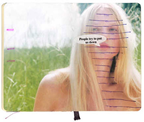
Information Artefacts
Katharina Birkenbach (aka Ponypink), an Amsterdam- and soon Berlin-based designer, has just launched a pretty fresh social networking website, it's called Nearness. Built on Mediamatic's anyMeta system, it allows you to feed it with various information about events, people, things, etc., all of which are equally treated as artefacts. This allows users to create rich interconnections between the individual entries, creating an ever more complex network of stuff.
I asked Katharina to briefly line out what the idea behind it is: "Nearness is an environment where people can store their information that is surrounding them in their daily life. It is not focused on one kind of media but is open for nearly any kind of information, doesn't matter how big or small, important or unimportant it is. Nearness can become an always present little companion, which is helping you to collect, to not forget, to organise the things you like. But organising not in the sense that you are somehow the administrator of a complex folder system, but by generating context for the data and embedding it in the data network. The context in which, for example, your favourite book is displayed is not only set up by the information you've entered, but all the users of Nearness. In this sense it can develop to some kind of stimulating treasure trove."
Trying to explain the potential of it, she also sent me a scan from her sketchbook which is pictured above, along with its history: a photo from i-D magazine, alluding to The Virgin Suicides. A sticker from Dazed and Confused which itself is a quote from The Who. Ten friends also made collages like this as part of something called Feed Me. So, Nearness in her vision could grow to become a tool for the same process. Something that today many creative people use notebooks for: collecting snippets of culture, ideas – in a way making mental collages but with the power of a networked system. [blogged by Sascha on we-make-money-not-art]
Posted by jo at 04:53 PM | Comments (0)
Upgrade! International
![]()
DIY in Oklahoma City
Upgrade! New York announces Upgrade! International: DIY Oklahoma City :: Nov 30-Dec 3 :: ARTISTS FROM AROUND THE WORLD CONVERGE IN downtown OKLAHOMA CITY :: Traveling across the globe from cities such as Berlin, Jerusalem, Istanbul, Seoul and Salvador, artists will come together in Oklahoma City to present art and ideas to each other and the community in the second annual meeting of Upgrade! International. The Upgrade! International: DIY Oklahoma City symposium, to be held November 30 – December 3, 2006, is an opportunity for local and international artists to exchange ideas about the developing field of new-media arts.
Open to the public, the four day symposium will feature exhibitions, workshops, presentations, lectures, screenings and performances by new-media artists. Topics such as Water Testing and Art, Making Art Interactive and Social Mapping as a Medium of Self-Expression will be explored in lectures and workshops. Interactive installations will offer participants a chance to explore an abstract universe, hear experimental audio works or experience the pulse of other participants through a created environment. A variety of short film and experimental video works will be screened at the Oklahoma City Museum of Art’s Noble Theatre as well as in a Do-It-Yourself Drive-In Theatre setting. "DIY or Die," a net art exhibition featuring 25 artists will open at IAO gallery. The exhibition celebrates the 10th anniversary of Rhizome and Turbulence, and was curated in collaboration with Upgrade! New York.
![]()
Three downtown locations will host the symposiums events and exhibitions, with participants moving between venues, giving them an opportunity to experience more of Oklahoma City. Untitled [ArtSpace] at 1 Northeast 3rd, Individual Artists of Oklahoma at 811 N. Broadway and The Oklahoma City Museum of Art’s Noble Theatre at 415 Couch Dr. will provide a diversity of spaces for the array of activities.
A global network of international artists, The Upgrade! is united by art, technology and a commitment to bridging cultural divides. The Upgrade! International: DIY Oklahoma City symposium is presented by Untitled [ArtSpace], Individual Artists of Oklahoma, Oklahoma Visual Arts Coalition, The University of Oklahoma School of Art, The University of Central Oklahoma School of Art, The Oklahoma City Museum of Art Film Program, Upgrade! International Oklahoma City and with additional support from Kirkpatrick Foundation, Allied Arts and Oklahoma Arts Council.
Upgrade! is an international network of gatherings concerning art + tech + community.
About our partner: Eyebeam supports the creation, presentation and analysis of new forms of innovative cultural production. Founded in 1997, Eyebeam is dedicated to exposing broad and diverse audiences to new technologies and media arts, while simultaneously establishing and demonstrating new media as a significant genre.
Posted by jo at 04:37 PM | Comments (0)
Second Life: The Official Guide
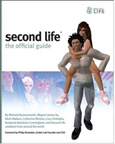
Second Life Gets a Paper Book
Second Life has been on Techmeme a lot lately. Most of this has been about the continuing inroads that larger companies like Dell and Reuters have made into the world. Some of it has been about strife within the world due to things like land price increases and copybot (a recently released program that can copy any artifact in world; BoingBoing has a good piece discussing the issues).
The latest splash is a physical book, entitled Second Life: The Official Guide, that is now available on Amazon. As the documentation for the world moves off the web it becomes more accessible and even *more* people will join.
"Second Life: The Official Guide is the perfect book for anyone interested in Linden Lab’s fascinating Second Life metaverse. It explores in detail every aspect of Second Life’s rich and multilayered virtual world, explains how it works, and offers a wealth of information and practical advice for all Second Life residents. The first part, “Getting a Second Life,” acquaints potential and new players with the Second Life world. It describes the metaverse’s geography as well as its society, explaining its written and unwritten rules. The second part, “Living a Second Life,” deals with the practical and economic aspects of Second Life: creating and customizing an avatar, building objects, scripting, and making money. The third part of the book, “Success in Second Life,” discusses ways to enjoy Second Life more. It includes profiles of successful Second Life residents, discusses fascinating in-world events, and examines how some are using Second Life for business, training, and other purposes. The book closes with a glossary as well as quick-reference and additional-resources appendices. The book's CD includes special animations, character templates, and textures created by Linden Lab exclusively for this book. The disc also guides new users through the installation and includes a code that grants a special object the first time they enter the metaverse." [blogged by Brad Forrest on O'Reilly Radar]
Posted by jo at 04:26 PM | Comments (0)
Second Life Copybot
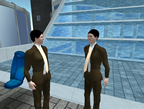
Investing Time and Money in Virtual Worlds
"In the last month something happened that shook the world to its core. It was the sudden appearance of the capability to instantly replicate three-dimensional objects, suddenly in the hands of the common people. Everyone’s intellectual property was up for grabs, and the very notion of manufacturing under attack. Small business owners who relied on handcrafting luxury goods found themselves completely vulnerable to perfect knockoffs...
Microtransactions for digital assets and virtual goods is a rising, potentially multibillion dollar industry. To succeed, entrepreneurs who are building networked systems based on user content (be they citizens of Second Life or the makers of virtual worlds themselves) must realize that anything displayable is copyable; the value lies instead in service and in server-side functionality. Content is like songs around a campfire: destined to be enjoyed for free. Those who build businesses around hosting campfires would be wise to focus on making the campfire experience great, rather than charging listeners by the song." From Investing time and money in virtual worlds: Caveat Emptor by Raph Koster, Venture Beat. [via]
Also:
"...[Linden Lab] plans to develop an infrastructure to enable Second Life residents and landowners to enforce IP-related covenants within certain areas, or as a prerequisite for joining certain groups. In effect, Second Life's inhabitants will self-police their world, according to rules and social norms they develop themselves." From Second Life Will Save Copyright by Jennifer Granick, Wired.
Posted by jo at 04:16 PM | Comments (0)
Interview by Simon Mills

Sean Cubitt
[...] Simon Mills: How do you think the plethora of so-called Web 2.0 applications (E.g. Myspace, Youtube, Bitorrent, Google) are changing the media landscape? These are all predominantly based on constantly evolving databases so exhibit a distinctly new media aesthetic. They also seem to aid a more democratic means of cultural production making publication and involvement cheap and easy. Are you sold on the idea of ‘network as platform’?
Sean Cubitt: Cheap and easy is always good. talk, as they say, is cheap. Thank God. It takes millions of people talking (and writing, which is nearly as cheap) to produce one poet; and it takes millions strumming away to produce one musician. Those of us who only talk and strum are nonetheless experts, in the sense that we know how hard it is to make words and sounds do what you want them to, and so we are the perfect audience for the poet and the muso. It will take a million mash-ups to make one work that will really make your jaw drop.
And yet I can’t help fretting that the NewsCorp purchase of MySpace, and the Google buy-out of YouTube, are exemplary moves towards the commercialisation of cultural democracy. A million content-producers raise the levels, and create the audience, but the coming Homer will be just another unpaid prosumer in the gardens of digital labour. The cynic in me sees digital gaming as training for the unpaid labour that was informally organised in the TV era. Already back then, as Dallas Smythe noted in the 1950s, all non-working, non-sleeping time was being colonised by another form of work, which he called the production of attention-value. When broadcasters sell audiences to advertisers, they obviously don’t enslave them body and soul. What is changing hands is the attention of viewers. And how are the viewers paid for their attention? I suppose you could answer that they receive some kind of gratification from the endless repetition of adverts and jingles, but it seems a paltry recompense when compared with the billion-dollar trade in eyeballs. The same has to be said of content-producing internet users, with bells on.
There is no longer any reason to believe the internet is intrinsically democratic, or intrinsically anything. The network is the network, in the same way air is air. Air is of course intensely democratic, but then we thought the same about water, and look how that has become a user-pays industry, and a weapon of ar. This doesn’t mean we should withdraw from drinking and washing; and it doesn’t mean we should refrain from struggling for a viable ecology. Ditto the internet: we can no longer live as if it did not exist. To abandon it to NewsCorp would be unthinkable. Historically, the net, the web, and almost every working application has been thrown together by creatives, whether for fun or profit. Almost nothing has been produced by corporations. Clearly corporate structures, however they benefit from network communications, are inadequate to the cultural innovations that users produce. And yet they have the inherited wealth that allows them to buy, one by one, every new tool and toy. I admire Wikimedia for holding out as long as they have, and longer. Linux likewise. These are the models: pirate enclaves, temporary autonomous zones. The reason we keep our smiles, as the greedy, incompetent commercial sector mops up our devotion to the internet gift economy, is that they manifest with every purchase their inability to originate, and in that admission, their incapacity for the global rule to which they lay claim.
Perhaps I’m wrong in thinking that democracy is commercialised in web 2.0 formats. Perhaps instead commercialism is being democratised. Certainly the nature of both is changing. Some of me is conservative enough to resent and regret the changes. The rehash of PR handouts by journalists, and the rehash of journalism by bloggers, isn’t the journalism I praise – the journalism represented by Robert Fisk at the London Independent. Some of me still believes that freedom of speech is important to democracy, and resents its loss in corporate media, and its confusion with mere opinion in the blogosphere. I have more than enough opinions of my own. What I need is journalism. This is the sound of an older democracy complaining about its own demise, and painting an already nostalgic and inaccurate picture of its actually smutty and corrupt past. Some basic media ethics need to be introduced at school level – driver’s ed for the web generation. A recent scandal here – a sexual assault posted on YouTube by working-class schoolboys – suggests the alternative. (Of course I do not want to argue that a veneer of irony makes this permissable to a different class of people – if I or anyone never saw Clockwork Orange again, the world would not be a worse place).
Nonetheless, the network is the only platform we’ve got, and we’d be idiots to give it up... From Sean Cubitt Interview by Simon Mills, Framed Journal.
Posted by jo at 04:01 PM | Comments (0)
V2_ presents
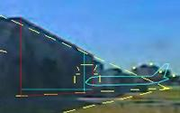
TANGENT_CONSPIRACY
V2_ presents TANGENT_CONSPIRACY :: Friday 1 December, 2006, 20:00 hrs :: Live stream: & IRC chat: irc.v2.nl/#tangents.
Long before a clandestine military-academic collaboration created the 1960's ARPANET the speculative mechanisms of conspiracy theories have fueled global events. The Internet and its growing Web 2.0 counterpart have moved beyond the realm of information exchange and redundancy to become the real-time fora of narrative construction. Fuelling and fanning all forms of popular speculation the net now creates its own post-modern mythologies of world domination, corporate control and government induced fear fetishism. If the net itself is not a conspirative construct designed to control and influence global intellectual expression then, rumour has it, it plays the central role in implying as much. Has the Internet now become a self-fulfilling prophecy of its own destructive speculation? V2_, in collaboration with the Media Design group of the Piet Zwart Institute, invites you to join Florian Cramer, Claudia Borges, Hans Bernhard and Alessandro Ludovico in an evening of net-based conspiracy built upon abrasive speculation, conjectural divination and devious web bots.
Alessandro Ludovico, editor in chief of Neural, has been eavesdropped upon electronically for most of his life due to his hacktivist cultural activities. Promoting cultural resistance to the pervasiveness of markets, he is an active supporter of ideas and practices that challenge the flatness of capitalism through self-organized cooperation and cultural production. Since 2005 he has been collaborating with Ubermorgen and Paolo Cirio in conceptually conspiring against the smartest marketing techniques of major online corporations.
Florian Cramer, course director of Piet Zwart Institute Media Design, had his education sentimentale as a member of the Neoist Cultural Conspiracy and is rumored to be involved in numerous anonymous collective efforts. His interest in plots, networks and signs brought him to study literature and investigate networks, speculative programming and cultural semiotics. Next to encouraging hacker approaches to information design, he currently researches the subliminal impact of obscenity on the human mind.
tatibrazil aka Maria Claudia de Azevedo Borges hails from São Paulo, Brazil where she graduated in Clinical Psychology. Her official life as an artist began in Rotterdam where, after 10 years of busying herself with oil paint, she was seduced by the Internet. As part of her practice exploring women's issues she trains and designs critical bots using female identity, language and narratives. Her methods are highly unorthodox, using the material of conversation and jargon as a means of information gathering. Currently, it is claimed, that she collaborates with the ethereal being known as Joy Evidence. http://www.d-tati.org/bot/
http://tati.sohosted.com/retrieveme/index.html
Hans Bernhard is a St. Moritz based artist whose true madness first surfaced when he started up the internet-underground cult etoy in 1994. In 1999 he and three other founding members of etoy bought the mother company etoy.holding while investing dot-com money in a Sofia based software firm (esof ltd). During the web site action Vote-Auction to buy and sell votes during the 2000 U.S. presidential elections Hans and lizvlx (UBERMORGEN.COM) were sued by 12 U.S. states, investigated by U.S. federal attorney Janet Reno, observed by the FBI, the CIA and the Austrian secret police and put under NSA surveillance. Afterwards he initiated NAZI~LINE (with Christoph Schlingensief), a neo-nazi re-integration project. Other projects currently getting him into serious trouble with German/Austrian secret services and corporate lawyers include GWEI (Google Will Eat Itself), the Injunction Generator and Amazon Noir. BERMORGEN.COM / etoy.holding http://ubermorgen.com
TANGENT_CONSPIRACY will also feature sisterO and The Algorithmic Oracle who will reveal your place in the manifold of time with their *Media Divination 2.0. *Bring an image or article of personal interest and be ready to disclose your date of birth ...
Andrea Fiore, The Algorithmic Oracle, is currently a second year student of Media Design at the Piet Zwart Institute. He holds a degree in communication sciences from the University of Rome with a thesis on software as cultural artifact and spends much of his time data mining, profiling, conjuring social software, and exploring digital archives and privacy issues.
Nancy Mauro-Flude's sisterO project involved an extended period of research in Colombia looking at new & old media at the Society of Ethnomedicine; this resulted in a series of transmission-based performances. Her work as a performing artist refers to the history of political cabaret, mesmerism and the experiential worlds carried in their wake. Currently a Master's candidate in Media Design, Piet Zwart Institute.
TANGENT_CONSPIRACY will also be streamed live via www.v2.nl. *We welcome and encourage external online participation to V2_'s moderated IRC channel: irc.v2.nl/#tangents. During the event we will be introducing V2_'s new chat bot, the incorrigible and witty CyB!
Posted by jo at 12:58 PM | Comments (0)
Internet Research 8.0: Let's Play!

Call for papers
Internet Research 8.0: Let's Play! :: International and Interdisciplinary Conference of the Association of Internet Researchers :: Vancouver, British Columbia, Canada :: Workshops: October 17, 2007 :: AoIR conference: October 18 20, 2007 :: CALL FOR PAPERS :: Deadline for submissions: February 1, 2007.
Let's Play The Internet better, internet/s - is at once part of the background hum of the developed world and an exotic realm of fantasy and play. It is an essential, mundane part of daily life, and simultaneously radical, revolutionary, profane, and fun. Internet/s invite us to play. We surf, blog, role play, and chat in the interest of work, learning, and play. Serious technologies and applications invite playing around as a way to learn how to use them. Playful applications take root in serious business, as online chat becomes a business communication tool.
Games find applications in education, business, and war. Playful blogging evolves into a social and political force to be reckoned with. We play with our identity online, shaping current and future roles offline. The play goes onS Our conference theme of play invites empirical research and theoretical reflection on how human beings "seriously play" with one another on, via and through internet/s, on local, regional, and global scales. We call for papers that explore the intersection of the serious and the playful, the sacred and the profane, the revolutionary and the mundane, and fantasy and the reality.
CALL FOR PAPERS
We call for papers, panel proposals, and presentations from any discipline, methodology, and community, and from conjunctions of multiple disciplines, methodologies and communities, that address the (playful) blurring of boundaries online. The following TOPICS are suggestions simply intended to spark initial reflection and creativity:
* Mundanity implies normalcy, and thereby, the efforts to understand and regulate online interactions in ways that are analogous to and consistent with offline practices and norms (e.g., privacy protection, norms for community interaction, efforts to regulate information flows involving pornography, hate speech, etc.). As internet/s become interwoven with ordinary life on multiple levels, in what ways do these alter ordinary life, and/or how do prevailing community and cultural practices reshape and 'tame' such internet/s and the interactions they facilitate?
* Global diffusion: how do internet/s, as they exponentially diffuse throughout the globe facilitate flows of information, capital, labor, immigration and play and what are the implications of these new flows for life offline?
* eLearning: how can such practices as distance learning and serious games utilize the liminal domain (the threshold world of dream and myth, in which important new skills, insights, and abilities are gained in the process of growing up) to go beyond traditional ways of learning? Are they necessarily better, or easier, to use or to learn from?
* Identity, community, and global communications: how will processes of identity play and development continue, and/or change as the role and place of the Internet in peoples lives shift in new ways including the expansion of mobile access to internet/s?
* E-health: what do new developments in sharing medical information online and expanding telemedicine technologies into new domains imply for traditional physician-centered medicine, patient privacy, etc.?
* Digital art: from downloading commercially-offered ringtones to facilitating cross-cultural / cross-disciplinary collaborations in the creation of art, internet/s expand familiar aesthetic experiences and open up new possibilities for aesthetic creativity: how are traditional understandings of aesthetic experience affected and how do new creative / aesthetic / playful possibilities affect human "users" of art?
* Games and gaming: the average gamer in North America is now a twenty-something whose lifestyle is more mainstream than adolescent. As games and gamers "grow up" and as games continue their diffusion into new demographic categories while they simultaneously continue to push the envelopes of Internet and computer technologies what can we discern of new possibilities for identity play, community building, and so forth?
Sessions at the conference will be established that specifically address the conference theme, and we welcome innovative, exciting, and unexpected takes on that theme. We also welcome submissions on topics that address social, cultural, political, economic, and/or aesthetic aspects of the Internet beyond the conference theme - e.g., in CSCW and other forms of online collaboration, distance learning, etc. In all cases, we welcome disciplinary and interdisciplinary submissions as well as international collaborations from both AoIR and non-AoIR members.
SUBMISSIONS
We seek proposals for several different kinds of contributions. We welcome proposals for traditional academic conference papers, but we also encourage proposals for creative or aesthetic presentations that are distinct from a traditional written paper.
We also welcome proposals for roundtable sessions that will focus on discussion and interaction among conference delegates, as well as organized panel proposals that present a coherent group of papers on a single theme.
* PAPERS (individual or multi-author) - submit abstract of 500-750 words
* CREATIVE OR AESTHETIC PRESENTATIONS - submit abstract of 500-750 words
* PANELS - submit a 500-750 word description of the panel theme, plus 250-500 word abstract for each paper or presentation
* ROUNDTABLE PROPOSALS - submit a statement indicating the nature of the roundtable discussion and interaction
Papers, presentations and panels will be selected from the submitted proposals on the basis of multiple blind peer review, coordinated and overseen by the Program Chair. Each individual is invited to submit a proposal for 1 paper or 1 presentation. A person may also propose a panel session, which may include a second paper that they are presenting OR submit a roundtable proposal. You may be listed as co-author on additional papers as long as you are not presenting them.
Detailed information about submission and review is available at the conference submission website http://conferences.aoir.org [available December 1, 2006]. All proposals must be submitted electronically through this site.
PUBLICATION OF PAPERS
Several publishing opportunities are expected to be available through journals, based on peer-review of full papers. The website will contain more details.
GRADUATE STUDENTS
Graduate students are strongly encouraged to submit proposals. Any student paper is eligible for consideration for the AoIR graduate student award. Students wishing to be a candidate for the Student Award must send a final paper by June 30, 2007.
PRE-CONFERENCE WORKSHOPS
Prior to the conference, there will be a limited number of pre-conference workshops which will provide participants with in-depth, hands-on and/or creative opportunities. We invite proposals for these pre-conference workshops. Local presenters are encouraged to propose workshops that will invite visiting researchers into their labs or studios or locales. Proposals should be no more than 1000 words, and should clearly outline the purpose, methodology, structure, costs, equipment and minimal attendance required, as well as explaining its relevance to the conference as a whole. Proposals will be accepted if they demonstrate that the workshop will add significantly to the overall program in terms of thematic depth, hands on experience, or local opportunities for scholarly or artistic connections. These proposals and all inquires regarding pre-conference proposals should be submitted as soon as possible to the Conference Chair and no later than March 31, 2007.
DEADLINES
* Submission site available: December 1, 2006
* Proposal submission deadline: February 1, 2007
* Presenter notification: March 31, 2007
* Final workshop submission deadline: March 31, 2007
* Submission for student award competition: June 30, 2007
* Submission for conference archive: July 31, 2007
SUBMISSION OF FULL PAPERS
Full papers and a conference registration by at least one of the paper authors must be in place by July 31, 2007 for papers to be presented.
Formatting: Please submit papers in PDF with simple formatting, using sans serif font and in-text referencing. If you can't submit in PDF, use DOC or RTF format.
Submission process: Submit full papers to aoir2007[at]gmail.com by July 31, 2007.
CONTACT INFORMATION
Program Chair: Dr. Mia Consalvo, Ohio University consalvo[at]ohio.edu
Conference Chair: Dr. Richard Smith, Simon Fraser University smith[at]sfu.ca
Vice-President of AoIR: Dr. Charles Ess, Drury University cmess[at]drury.edu
Association Website: http://www.aoir.org
Conference Website: http://conferences.aoir.org
Posted by jo at 12:46 PM | Comments (0)
After convergence, what connects?
![]()
Call for papers
After convergence, what connects? :: Call for papers :: fibreculture has established itself as Australasia's leading forum for discussion of internet theory, culture, and research. The Fibreculture Journal is a peer-reviewed journal that explores the issues and ideas of concern and interest to both the Fibreculture network and wider social formations.
Papers are invited for the 'After convergence' issue of the Fibreculture Journal, to be published early in 2008. Guest editors are Caroline Bassett (Sussex, UK), Maren Hartmann (Bremen, Germany) and Kate O'Riordan (Lancaster/Sussex, UK).
Everything that arises does not converge. A more variegated landscape emerges as processes of digitalization, crystallizations of an intrinsically technological-social, continue re-shaping cultures and re-working societies, not in their image, but into something new. It is increasingly obvious that there is no digital behemoth, no single form, no single function, no New World Order. Rather a series of reconfigurations, reformulations, new functions, new contents, new spaces, new grounds, new uses, have emerged and are emerging within global media networks.
In response to the (not unexpected) non-arrival of the unifying beast, which is to say in response to the perceived exhaustion of convergence (or the re-definition of its limits), new disciplinary islands are being declared with 'keep out' and 'invented here' signs all over their beaches. In other words there has been a balkanization of techno-cultural investigation. Thus gaming scholars define themselves against internet scholars, or film scholars, locatives stand distinct from screeners. Particular groups of sub-specialists claim particular modes of inquiry: ethnographers for everyday life, speculative theory for digital art, for instance. Indeed, entire vocabularies, originally invoked in a spirit of general experimentation, are now corralled, restricted and defended by particular groups. If these vocabularies often seize up in the process, refusing to say more than they were meant to say, and in particular refusing the unorthodox connections between the empirical and the speculative, the possible and the desirable, that gave them their energy in the first place, nobody seems to notice.
So, there is no behemoth. At the same time we insist that connections are produced and so a question we consider worth addressing is not what unites digital forms as one, but what connects them together as many. Further we want to explore how these connections are made. We are less interested in doing that through mainstreaming a particular critical approach (which is to say drawing different areas back under one critical umbrella, making that the connection), than we are in trying to think about exploring/defining/critiquing some of the shared characteristics of different digital media formations. We believe that despite the exhaustion of convergence metaphors, and the rise of disciplinary sub-divisions, these connections remain crucial.
Papers addressing but not limited to the following topics are welcome:
* Media/Medium Theory
* Difference between and specificity of New Media forms
* Issues, Limits, Problems of Convergence.
* Re-thinking the vocabulary of Affect/Emotion/Perception
* Histories of New Media Theory
* 'Technology and Cultural Form' revisited?
* Methodologies
Deadlines:
* 250 word abstracts: due February 28th 2007
* Completed Paper: due September 30th 2007
* Expected Publication: February 28th 2008.
There are guidelines for the format and submission of contributions at http://journal.fibreculture.org. These guidelines need to be followed in all cases. Contributions should be sent electronically, as word attachments, to:
Guest editors:
Caroline Bassett (c.bassett[at]sussex.ac.uk)
Maren Hartmann (maren.hartmann[at]uni-bremen)
Kate O'Riordan (k.oriordan[at]lancaster.ac.uk)
Posted by jo at 12:25 PM | Comments (0)
ELECTRA WITH EMMA HEDDITCH
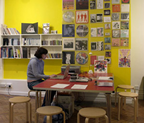
NOISE ARCHIVE AND 'WE'RE ALIVE, LET'S MEET!'
HER NOISE ARCHIVE AND 'WE'RE ALIVE, LET'S MEET!' in residence at LANDMARK, BERGEN KUNSTHALL :: ELECTRA WITH EMMA HEDDITCH :: 27 November - 1 December 2006, 12 - 1am daily (except Friday 12 – 8pm) ::
Landmark, Bergen Kunsthall, Rasmus Meyers Alle 5, 5015 Bergen :: Tel 00 47 55 55 93 10.
Electra opens up its extensive archive of sound based work by women and invites visitors to Landmark to take part in a range of events and to contribute to the archive.
Her Noise was an exhibition which took place at South London Gallery in 2005 with satellite events at Tate Modern and the Goethe-Institut, London, curated by Lina Dzuverovic and Anne Hide Neset of Electra. Her Noise gathered international artists who use sound to investigate social relations, inspire action or uncover hidden soundscapes. The exhibition included newly commissioned works by Kim Gordon & Jutta Koether, Hayley Newman, Kaffe Matthews, Christina Kubisch, Emma Hedditch and Marina Rosenfeld. A parallel ambition of the project was to investigate music and sound histories in relation to gender, and the curators set out to create a lasting resource in this area through building up an archive.
ABOUT THE HER NOISE ARCHIVE:The backbone of the Her Noise project is the Her Noise Archive, developed by Electra with artist Emma Hedditch, comprising the collected research materials, interview and performance footage recorded by the curators and a number of guests during the development of the project.
The archive contains books, fanzines, records, CDs, catalogues and other ephemera, as well as exclusive on camera interviews and concert footage with artists including Pauline Oliveros, Maryanne Amacher, Diamanda Galas, Else Marie Pade, Jutta Koether, Marina Rosenfeld, Thurston Moore, Jim O’Rourke, Kevin Blechdom, Kembra Pfahler, Kim Gordon, Lydia Lunch, Peaches and others.
HER NOISE ARCHIVE AT LANDMARK, BERGEN KUNSTHALL: The Her Noise Archive will take up residence at Landmark between 27 November and 1 December. Combining a research area, listening posts and a viewing space, the archive is open for audience to browse books, catalogues and magazines, listen to records or view videos.
In addition, London based artist Emma Hedditch will present ‘We’re Alive, Let’s Meet!’ - a series of ‘Get Togethers’ to exchange knowledge, discuss and contribute to the Her Noise Archive. These meetings will take the form of discussions and screenings with specially invited guests and visitors. All events are free and open to everyone.
‘WE’RE ALIVE, LET’S MEET!’ EVENTS:
Tuesday 28 November, 6 - 8pm: HER NOISE DOCUMENTARY; Duration: 90 minutes; Followed by discussion with Emma Hedditch, Lina Dzuverovic and Irene Revell (Electra) ::The video documents the development of the Her Noise project between 2001 and 2005 including interviews with a range of artists involved in the project including Diamanda Galas, Lydia Lunch, Kim Gordon, Jutta Koether, Peaches, Marina Rosenfeld, Kembra Pfahler, Chicks On Speed, Else Marie Pade, Kaffe Matthews, Emma Hedditch and the show’s curators. The documentary features excerpts from live performances from Erase Errata, Kevin Blechdom, Lydia Lunch and events during the exhibition at South London Gallery: Kim Gordon, Jutta Koether and Jenny Hoyston (Erase Errata), Christina Carter, Heather Leigh Murray, Ana Da Silva (The Raincoats), Spider And The Webs, Partyline, Marina Rosenfeld’s “Emotional Orchestra” at Tate Modern, and footage compiled for the “Men In Experimental Music” video made during the development of the Her Noise project by the curators and Kim Gordon.
Wednesday 29th November, 6pm - 8pm: HOW AND WHAT ARE WE DOCUMENTING? Introduced by Emma Hedditch :: A discussion of the politics of documentation – looking at history, representation and visibility. Participants are invited to bring their own materials to show and explain, or donate a copy to the Her Noise Archive.
Thursday 30th November, 6pm - 8pm: HERE? HAPPENING? :: An invitation for local organisations and artists to share their knowledge of women working within experimental sound and music. A discussion of local conditions in comparison to what is perceived to be happening elsewhere.
Friday 1st December 6pm - 8pm: CLOSING AND TEA PARTY :: A reflection and conclusion on the days of the Her Noise Archive at Landmark. Audience are invited to bring materials to be catalogued, play records, dance, show video clips, bring books, photocopy, socialize, drink tea and eat cake.
ABOUT EMMA HEDDITCH
Emma Hedditch (1972 Somerset, England) is a visual artist and writer living in London. Her productions include: “A Pattern” (since 2000), an ongoing collectively shot and edited video; “This Is What We Have Done, And This Is What We Are Doing” (2005), animated drawings by persons in the context of the London Lesbian and Gay Film Festival; “Video Home, Come On” (2004), a home-video viewing session and archive, with Electra and Electric Studios, Brixton; “A Political Feeling, I Hope So” (2004), Cubitt Gallery, London, a social situation exploring conditions of belonging. Ongoing research into Feminist thought and writing has informed much of her activity, as well as a desire to expose the economics of art production. She has been engaged in collaborative dialogue with The Copenhagen Free University since 2001, and has worked for Cinenova Women’s Film and Video distributor since 1999.
ABOUT ELECTRA
Electra is a London-based contemporary arts agency founded in 2003. Electra commissions and produces artworks across sound, moving image, performance and the visual arts, which it presents in the UK and internationally. Recent projects include a film/performance commission “Perfect Partner” by Kim Gordon, Tony Oursler and Phil Morrison (Barbican Centre), group exhibition “Her Noise” (South London Gallery), “Sound And The Twentieth Century Avant Garde” lecture series (Tate Modern and Stavanger, Norway), soundtrack consultancy on films by Daria Martin working with composers Zeena Parkins and Maja Ratkje respectively, “The Sounds Of Christmas” installation by Christian Marclay (Tate Modern), “Emotional Orchestra” and “Sheer Frost Orchestra” by Marina Rosenfeld (Tate Modern), “Once Seen” Programme for The British Council (Oslo and Tromso, Norway).
Electra gratefully acknowledges support from Arts Council England
This residence is a collaboration with British Council Norway
Posted by jo at 10:30 AM | Comments (0)
Wired News: Gannett to Crowdsource News
Gannett Newsrooms Rechristened "Information Centers"
Gannett, the publisher of USA Today as well as 90 other American daily newspapers, will begin crowdsourcing many of its newsgathering functions. Starting Friday, Gannett newsrooms were rechristened "information centers," and instead of being organized into separate metro, state or sports departments, staff will now work within one of seven desks with names like "data," "digital" and "community conversation." The initiative emphasizes four goals: Prioritize local news over national news; publish more user-generated content; become 24-7 news operations, in which the newspapers do less and the websites do much more; and finally, use crowdsourcing methods to put readers to work as watchdogs, whistle-blowers and researchers in large, investigative features. (via del.icio.us/network/yatta)
Posted by jo at 09:42 AM | Comments (0)
The Fruit Fly Farm
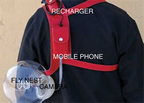
Wearable Sculpture
With The Fruit Fly Farm sculpture, Laura Beloff is investigating both technological society and organic (insect) society. The Fruit Fly Farm is built as a wearable object for people to adopt and carry around. It is a personal “pet” and wearable system with a public access via mobile phone. A camera phone, embedded in the sculpture, is observing the fly community. Anyone can access the phone camera by sending a sms to the piece. The camphone will then capture an image and send it back as an MMS. The photo along with the sms-messages (comments) will also be uploaded to a dedicated website.
The fly nest is located in the middle of the Ø20cm transparent acryl ball. The nest capsule contains rotten fruits and needs to be re-filled approximately once a week. Small holes allow the flies to fly in and out of the nest. Until November 30th 2006, you can send the sms to this number: +47 92096767 (Norway). In the same series of “wearable” future works which address the society and surrounding environment as the their theme: The Head. [blogged by Regine on we-make-money-not-art]
Posted by jo at 08:58 AM | Comments (0)
Buy Nothing Day
"Every November, for 24 hours, we remember that no one was born to shop. If you’ve never taken part in Buy Nothing Day, or if you’ve taken part in the past but haven’t really committed to doing it again, consider this: 2006 will go down as the year in which mainstream dialogue about global warming finally reached its critical mass. What better way to bring the Year of Global Warming to a close than to point in the direction of real alternatives to the unbridled consumption that has created this quagmire?"
Posted by jo at 08:44 AM | Comments (0)
November 24, 2006
THURSDAY CLUB: MARK D'INVERNO
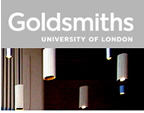
CELL –An Interdisciplinary Investigation
THURSDAY CLUB with MARK D'INVERNO :: Thursday November 30, 6-8pm in the Seminar Rooms, Ben Pimlott Building, Goldsmiths, University of London, New Corss, SE14 6NW :: FREE, ALL ARE WELCOME.
CELL –An Interdisciplinary Investigation Into Adult Stem Cell Behaviour :: The CELL project was an interdisciplinary collaboration over 4 years that included an artist, a stem cell researcher, a curator, an ALife programmer and a mathematician. It employed a range of approaches to investigate stem cell behaviour. This included agent-based models; simulations and visualisations to model stem cell organisation in silico as well as art installations, which reflected on how different disciplines use representations and data visualisation.
The impact on all members of the team was very significant and it motivated Mark d’Inverno along with the artist Jane Prophet to set up an interdisciplinary research cluster (funded jointly by both the science council and the arts council in the UK) to further investigate the potential of interdisciplinary collaborative research in general.
In this talk I will reflect on my experience of this process of interdisciplinary collaboration and attempt to lay down some ideas relating to the minimal conditions that need to be in place for it to flourish, as well as enumerate some of the major obstacles.
Mark d'Inverno is Professor of Computer Science since 2001. In 2006 he took up a Chair at Goldsmiths College, University of London, principally to continue his investigations into interdisciplinary work. He has been interested in formal, principled approaches to modeling both natural and artificial systems in a computational setting. The main strand to this research, focuses on the application of formal methods in providing models of intelligent agent and multi-agent systems. This work encompasses many aspects of agent cognition and agent society including action, perception, deliberation, communication, negotiation and social norms. In recent years, ideas from both formal modeling and agent-based design, have been applied in a more practical and interdisciplinary settings such as biological modeling, computer-generated music, art and design.
For more information on the Thursday Club check
http://www.goldsmiths.ac.uk/gds/events.php or email maria x: drp01mc[at]gold.ac.uk
Posted by jo at 03:42 PM | Comments (0)
Franck Ancel
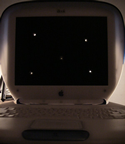
5G
5G :: While the sixth Guggenheim Museum was under construction in Mexico, in 2006, I captured data on the five existing Guggenheims. The traces of this very real course provide an echo of a possible virtual construction of a museum on a planetary scale, of which the Guggenheims are the symbol. The shift from a fluid architecture of the virtual to a reality of the constructed form takes shape in the final stage of my project in Paris, involving a 3D video animation created by Brian Bey, and a resin model, from 3D prototyping, in collaboration with the IDO company, that is based on the elements I brought together.
This 5G is composed of a photo, in conjunction with GPS coordinates showing the exact position of the images taken in front of the 5 Guggenheims in Berlin in June, Bilbao in July, New York and Las Vegas in August, and Venice in September. 5G thus defines itself as the outline for a performance-installation networking several sites on a global scale. A unique moment that is in symbiosis with the projected entity involving more than a hundred Guggenheims all over the world that is now being studied.
This project has already outlined the infinite scope for feasible artistic achievement in terms of the distribution and exchange of tomorrow's works of art, in the all-digital age. But it is also a tribute to the will of one woman, Peggy Guggenheim, that is directed towards artistic creation -- a woman who was cursed in the 20th century and is more than acknowledged today. For the transmutation of living forms involves an endless movement, and it is only this current epoch of ours that has established the bounds to be crossed.
Born in 1970, France, Franck Ancel lives in Paris. He has been exploring technology for more than fifteen years, tracing the development from the avant-gardes artists of the last century to the recent mutations of creation on a planetary scale. He has also organized and coordinated symposiums, expositions, and performances in cooperation with associations and institutions. The last one was a retrospective on Jacques Polieri, the creator of ”modern scenography,” at the BnF. Since the attacks of 9/11, Franck Ancel has set up an interactive triptych probing “architecture – image – technology” on 20th century heritage sites. In 2002, he put it in the Le Corbusier/Xenakis convent; in 2003 in a classified theater in Catalogne; and in 2004 on the screen of Montparnasse Tower in Paris. Franck Ancel challenges the viewer outside traditional frontiers, by projecting a setting of a network of information on screens. At the same time, he analyzes this technique on a more theoretical level in texts and talk. It encloses thus in 2005 a cycle of five communications for five continents with a world internet premiere from a plane flying from Shanghai to Munich. In 2006, he continues to open to the world with a digital capture in the world’s five Guggenheim museums and launches UFOs on this website remixarts.com
Posted by jo at 02:53 PM | Comments (0)
November 22, 2006
Celebrate our 10th Anniversary
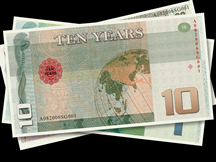
Support Turbulence
Dear Friends,
New Radio and Performing Arts, Inc. (NRPA) is 25 years old. Turbulence is celebrating its first DECADE, the only program to consistently commission net art for ten consecutive years. Despite the expansion of our projects, the acceleration of our support for net artists, and the valuable resources we provide in our networked_performance blog and New American Radio archive, NRPA has seen a decline in its operating support. Please help us support emerging artists and technologies, and preserve our valuable archives.
Our deepest thanks to Annie Abrahams, Kate Armstrong, Diane Bertolo, Andy Deck, Onomé Ekeh, Jason Freeman, Tal Halpern, Peter Horvath, David Jhave Johnston, kanarinka, Brooke A. Knight, Steven Lam, Patrick Lichty, Michael Takeo Magruder, Michael Mandiberg, microRevolt, Mouchette, MTAA, Andrea Polli, Preemptive Media, Gustavo Romano, Yoshi Sodeoka, Nathaniel Stern, Helen Thorington, and Jody Zellen for contributing books, DVDs, CDs, archival prints, T-Shirts and more.
Please indicate which piece you would like when making your contribution. If the piece you want is no longer available, please consider making a donation anyway. Use a credit card to donate via PayPal or, if you'd prefer to send us a check, please email us at turbulence at turbulence dot org for details: type "Donation" in the subject line.
Allow us until January 2007 to ship your art work; if you'd like it earlier, please let us know and we'll do our best to get it to you.
With Gratitude,
Helen Thorington and Jo-Anne Green
Co-Directors
Posted by jo at 08:30 PM | Comments (0)
First Generation in media …
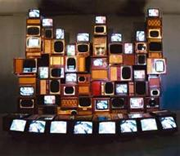
Art and the Moving Image, 1963-1986
First Generation: Art and the Moving Image, 1963-1986 is the title of a recently opened show at the Museo Nacional Centro de Arte Reina Sofía, Madrid. It assembles early video and video performance work mainly focusing from their own collection with emphasis on specific approaches to the medium during the first 25 years. It includes as main themes the inspiration of Fluxus, the critique of commercial television, the relationship between the medium and the viewer, feminism, performance and the legacy of minimalism and conceptual art.
First Generation does not aspire to be a thematic exhibition, nor does it try to follow a strict chronological order. Rather, it is a global vision of how and why a technology of recording, broadcasting and reproducing sound and images, which emerged in 1950 —and technically different than cinema— became an artistic medium;
a “study” of the influence technology and mass culture had on the social and artistic changes of an era, at a time when cultural acceleration and the cross-pollination of ideas was beginning. In this sense, 1968 marks a before and after in this history: for that was the year in which a portable, relatively affordable television set appeared on the market, opening this medium up to a vast new group of people.
Interesting in this context might be as well the link to the complete archive of the early media magazine Radical Software:
The historic video magazine Radical Software was started by Beryl Korot, Phyllis Gershuny, and Ira Schneider and first appeared in Spring of 1970, soon after low-cost portable video equipment became available to artists and other potential videomakers…. [blogged on mind the __GAP*?] [Related]
Posted by jo at 06:07 PM | Comments (0)
Radio Communities:

The Other Side of the Electronic Divide
Radio Communities: The Other Side of the Electronic Divide :: Wednesday, November 29, 2006 – 6:30 p.m. :: The Vera List Center For Art And Politics :: The New School, Theresa Lang Community and Student Center, 55 West 13th Street, 2nd floor, New York City :: Admission: $8, free for all students, as well as New School faculty, staff and alumni with valid ID.
Radio creates a broadly accessible dimension in which various communities can meet, exchange, discuss, and develop ideas on their own terms, often free of commercial and governmental constraints and regulations. It is thus transforming the way we think of notions of geography and public place. Since cyberspace and advanced technologies in media have not yet reached all of the developing world, broadcast radio is still the easiest medium for sharing knowledge across borders and in spite of the restraints of time and space—a quality that also informs artistic radio endeavors. As a non-visual medium, radio has also gained additional prominence and validity in politically charged situations, where a certain degree of anonymity is necessary. What political, cultural and humanitarian goals can be served by this medium exclusively? How does radio function as a tool for shared information? This panel discusses the ability of airwaves to keep the world connected near and far, and where other technology fails.
Posted by jo at 04:29 PM | Comments (0)
Cemetery 2.0
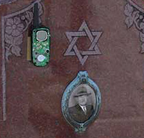
Physical/Virtual Memorial
Cemetery 2.0 is an interesting work wirelessly networking the grave of Hyman Victor (the great-grandfather of the artist) in Chicago with some online information about him and his life, photographs of his life, a copy of his entry into the largest genealogical database in the world, a link to the family tree of the Jewish People etc.
Cemetry 2.0 is very much a personal exploratory work for the artist [Elliott Malkin], getting to know his great-grandfather (and his family history) and it employs technology to that end. It documents his research but also creates a memory which can permeate and persist beyond any physical media (an actual photograph and it’s siting in say a family album), the memory of any single person (relatives), any physical location (the grave itself) and yet ensures that the grave, the physical memorial, is the place and link to the virtual memorial.
The work, while not using RFID technology, is a work of object hyperlinking. It employs radio frequencies and so shares many of the ideals and [dis]utopian visions we are currently seeing written about the coming, Internet of Things, the benefit of things becoming active in networks and the drawbacks of people being always on[line], always possibly to find and surveil. Comparable work to Cemetry 2.0 includes Semapedia, the object hyperlinking project based around wikipedia. However while this is an application of what is hoped will be a practical technology and raises questions (good and bad) depending on what (or who) is tagged and of course who on wikipedia documents it (amidst claims that wikipedia has accuracy issues and is monopolised), Cemetry 2.0 mangaes to sidestep many if not all of these concerns, in what is already a delicate subject, to truly create a sensitive and personalised new media.
Note: This work has very much the feel of Christian Boltanski’s work (interview on youtube - 1, 2, 3, 4, 5, 6) in the way it tackles memory and the ‘artifacts’ we associate with remembering.
Work reviewed at We Make Money Not Art. [bogged by Garrett on Networked Research] [Related]
Posted by jo at 04:16 PM | Comments (0)
Duncan Wilson
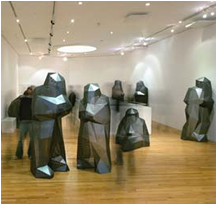
psp/rca
Six Students from Design Products, Industrial Design Engineering and Interaction Design at the Royal College of Art designed a landscape of concept furniture derived from the statue-like forms of people sitting, standing or leaning against walls engaged in playing the PlayStation Portable (PSP). Visitors to the exhibition are able to enter these forms and play on the console while exposed to an audio installation echoing player activity.
The cocoon-like nature of the furniture is related to the experience of playing games on the PSP. Initial inspiration came from observing group play at a barbecue: when still light in the early evening, a group of players put their coats over their heads to create shade and see the PSP's screen better. Despite not being able to see each other at all, they continued to happily taunt, insult and otherwise interact with each other as is the norm throughout the course of a game. More >> [via]
Posted by jo at 04:03 PM | Comments (0)
Cobi van Tonder's
Skatesonic
Skatesonic, uses the motions and sounds of skateboards and explores their inherent ambient rhythm to create music. In a way, each move translates to musical parameters and the rider ends up skating through a landscape of music (which s/he influences over time). Related post >>
Posted by jo at 03:54 PM | Comments (0)
New Media and Social Memory
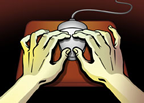
What is important to remember?
Symposium: New Media and Social Memory (Save the Date, details to follow.) :: Thursday, January 18, 2007, UC Berkeley Art Museum and Pacific Film Archive.
What is important to remember? This public symposium will explore how the canonical historical record is created and maintained in the digital age by "memory institutions" such as museums, libraries, and archives, and how digital media artists are influencing / hacking / critiquing this construction of social memory. These issues will be explored in concrete terms by focusing on the tangible case study of preserving digital art as emblematic of the larger social issues in preserving digital culture.
Works of digital and Internet art, performance, installation, Conceptual, and other variable-media art represent some of the most compelling and significant artistic creations of our time. These works constitute a history of alternative artistic practice, but because of their ephemeral, technical, or otherwise variable natures, they also present significant obstacles to accurate documentation, access, and preservation.
Without strategies for preservation, many of these vital works-and possibly whole genres such as early Internet art-will be lost to future generations. Long-term strategies must closely examine the nature of ephemeral art and identify core aspects of these works to preserve. New media gives us the challenge and the opportunity to revisit the question "what is important to remember?" on a long-term, public scale.
This event is part of a consortium project, Archiving the Avant Garde, funded by the National Endowment for the Arts. Contact: Richard Rinehart (Rinehart[at]berkeley.edu).
Posted by jo at 02:50 PM | Comments (0)
FUTURESONIC 2007

10-12 May, Manchester UK
FUTURESONIC 2007 :: 10-12 May, Manchester UK :: Futuresonic, the urban festival of electronic arts and music, is moving from July to May, back to the Spring date it occupied in 2004. See below for next year's highlights and special advance discounts on
delegate passes.
FUTUREVISUAL: In 2007 the centrepiece of Futuresonic Live will be a celebration of all things audiovisual and a homage to 40 years of multimedia events. 40 years ago there were the first multimedia events of the kind that we would understand today. While the rest of the world was celebrating the soft-centred Summer of Love, a fusion of artforms and a crossover between avant garde and popular was taking place. This was the moment when events like Futuresonic became possible...
To celebrate the 40th anniversary of these seminal events, Futuresonic Live goes back to the future - revisiting one of the inspirations of the first Futuresonic festival in 1996 - to look at the cutting edge of immersive sound and image today.
URBAN PLAY: Urban Play is the art and technology strand of the festival featuring exhibitions, workshops and interactive projects in the city streets. It was introduced in Futuresonic's 10th anniversary year, reflecting Futuresonic's focus since 2004 on artworks in urban space, and has since been mirrored in other events in the UK and Europe.
Thirty years after Brian Eno's MUSIC FOR AIRPORTS, Futuresonic 2007's Urban Play presents ART FOR SHOPPING CENTRES, an exhibition of interactive artworks in a major shopping centre.
Urban Play will also feature FREE-MEDIA activities in association with Mongrel, MediaShed and Access Space, including a UK first implementation of the free-media Video Toolkit developed by MediaShed and Eyebeam (more TBA).
EVNTS: A competition and showcase for the best new and ground breaking events from around the world.
EVNTS is a strand of the Futuresonic festival which enables artist groups and event organisers to participate in the festival. Since its introduction in 2005, EVNTS has grown into a community of people who each year return to give the festival an extra edge.
INVITATION FOR SUBMISSIONS: Futuresonic now invites anyone working in music or media arts to take part in EVNTS 2007, with the EVNT Competition offering financial support for a limited number of events.
For further details announced soon. Visit here for more info, or sign up to Futuresonic's subscriber list to receive regular updates.
SOCIAL TECHNOLOGIES SUMMIT: A major international conference exploring the creative and social potential of new technologies, bringing together leading figures to
explore "a whole new way of doing things in the air".
In 2007 a focus of the Social Technologies Summit is FREE-MEDIA. Free-media is about finding inspiration and resources in our built and natural environment that were previously dismissed as being without value or irrelevant. It doesn't cost much because it makes use of public domain Free and Open Source Software, and recycles freely available old equipment, waste materials and junk (FOSS). Free-media increases access to media technologies, especially to the people who need it most and can afford it the least, and lowers environmental impact of the media we produce and consume.
The 2007 Summit will also host a network meeting for ENVIRONMENT 2.0, a new initiative joining the dots between locative media and environmental calamity, being launched by Futuresonic to assess and offset the environmental footprint of future arts and culture.
And it will play host to THE MAP DESIGNERS, an event drawing together map hackers, artists, cartographers, DIY technologists, architects, game programmers, bloggers and semantic web philosophers.
Delegate Pass - Advance discount available. See Below.
GET INVOLVED!: Visit the website or subscribe to Futuresonic updates for upcoming calls for submissions, job offers and volunteering opportunities.
ADVANCE DELEGATE PASS DISCOUNT ... SAVE £20 :: Delegate Pass - £25 (Normally £45): The Delegate Pass gives you access to all Futuresonic seminars and talks, the Social Technologies Summit, and entrance to Futuresonic Live events over the festival weekend. You must reserve your discounted Delegate Pass before December 31st 2006 and make payment by January 31st 2007. To reserve email tickets2007[at]futuresonic.com stating your name, address and contact details. You will be sent purchasing information from the festival box office by January 8th 2007.
*Futuresonic 2007 may burn when exposed to oxygen.
Posted by jo at 02:13 PM | Comments (0)
Net Neutrality
Broadband and the Public Interest
The Comparative Media Studies graduate students have been discussing current policy debates around "net neutrality." The phrase, "net neutrality," is in broad circulation at the moment but I suspect many people out there are not familiar with the core terms of the debate or how it impacts them. Stephen J. Schultze, a first year CMS masters student, asked if he might share some of his perspectives on this issue...
"Telecommunications policy wasn't exactly a hot-button issue in the midterm elections, but the resulting power shift in Congress could affect the trajectory of the Internet for years to come. Most of us are fairly satisfied with our day-to-day Internet experience. Why involve the bureaucrats when things are working just fine?
The problem is that things aren't working just fine. When it comes to broadband, we are falling embarrassingly far behind much of the rest of the world. On the heels of the elections, FCC commissioner Michael Copps wrote an editorial in the Washington Post entitled "America's Internet Disconnect." He noted that according to one study of "digital opportunity," the US ranks 21st in the world, right behind Estonia. We rely on private companies operating according to their market interests to connect us, and these companies have become more consolidated and less competitive in the last several years. Unfortunately, our telecommunications policy has failed to address the market failure that has left millions of Americans with limited and expensive options for broadband access - or none at all..." Continue reading [posted by Henry Jenkins on Confessions of an Aca/Fan]
Posted by jo at 10:38 AM | Comments (0)
Amazon Noir
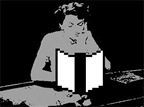
The Big Book Crime, Out of court settlement
Hot news from the Amazon Noir – The Big Book Crime project!.
The plot: The Bad Guys (The Amazon Noir Crew: Paolo Cirio, Alessandro Ludovico, Lizvlx and Hans Bernhard) stole copyrighted books from Amazon by using sophisticated robot-perversion-technology coded by Paolo Cirio. A media fight and a legal dispute escalated into an online showdown with the heist of over 3000 books at the center of the story.
The technology: The Amazon Noir Robots (Sucker01-12) tricked around with Amazon Search Inside the Book function until it gave away the complete volumes of copyright protected books. This was carried out by sending 5.000 - 10.000 requests per book. After this process the data was logically reassembled into pdf-format by the SIB-Book-Generator (see the diagram.)
Amazon Noir was scripted as an internet-movie. The whole digital action (media hack) was carried out in the global massmedia, within the art world and on a highly sophisticated technical level in the clandestine matrix of our global networks.
Amazon USA, U.K., Germany and France were vulnerable targets. During the attack they transformed part of the Search Inside the Book technology to defend the rights of the copyright holders - without actually solving the problem. Over 3000 Books were downloaded and distributed through p2p between April and October 2006.
The end? In July 2006 Amazon France and Amazon USA threatend to litigate. The matter was resolved out of court October 30th, 2006. Amazon (USA/France) bought the Amazon Noir software for an undisclosed sum - both parties signed a non-disclosure agreement.
Previous posts: The Big Book Crime and Interview with Ubermorgen. [blogged by Regine on we-make-money-not-art]
Posted by jo at 10:06 AM | Comments (0)
November 21, 2006
Martha Rosler:
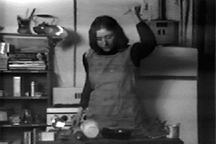
Art & Social Life; The Case of Video Art
"The wide-open field of early video may arguably be the typical condition of a medium at birth (compare the internet, on its way from being a utopian arena of activity to a gated compound locked down by corporate toll takers, if the latter get their way). Despite the competition of sites like Youtube, video as an art form has become, by definition, an expensive captive of the gallery and museum, the black box inside the white box."
unitednationsplaza is pleased to present a seminar and a video festival organized by Martha Rosler: Art & Social Life; The Case of Video Art. The program will begin with a public lecture by Marta Rosler on Sunday, December 10th at 6 pm.
The video festival will present a selection of early video works, dating from 1968 to present, from the personal archive of Martha Rosler, including numerous works rarely seen and largely excluded from the canonical history of video art, and others that form the backbone of early video histories as now written.
The video program will be free and open to the public daily from 2 - 6 pm at the screening room of the unitednationsplaza, starting Monday, December 11th through Friday, December 15. The schedule of screenings will be posted shortly at http://www.unitednationsplaza.org
The seminar, comprised of four evening sessions scheduled to take place from 7- 9PM, will start on Monday and continue through Thursday evening. The seminar is open to the public, however due to space limitations please register in advance with magdalena[at]unitednationsplaza.org
Martha Rosler: Art & Social Life; The Case of Video Art
December 10 - 15, 2006
The early history of autonomous video art is a pivot point in the internal culture wars of the art world. Starting in the late 1960s through the early 1970s, artists with quite diverse practices experimented with the new (but not yet widely available) portable video apparatuses.
Film had by mid-century superseded both architecture and music as the queen of the arts. But by the 1950s the broadcast television industry and its structures of celebrity were challenging the social status of high art. Television was a problem… and then the Portapak was invented. Video suggested varieties of freedom to artists restive about or dismissive of traditional studio practices. Video promised a sort of gesamtkunstwerk on the ruins of a high modernism that had demanded a strict separation between forms. Video offered not just the experience of time married to the illusion of space accompanied by sound; because of poor image quality, video also offered relative freedom even from the concerns of cinema / art film / movies. It provided the opportunity to sketch or to perform, to record a gesture or a narrative, to sing in the shower or dance in the studio, abetted by simple in-camera edits. Artists could, without commitment, break free of the studio if they chose, and, in the political ferment and upheavals of the era, while look around, report, raise a voice, show a face, register anger, offer an opinion, analyze social structures and events, tell a joke, join with friends, and yell back at the mind-melting products of broadcast television while nevertheless making use of its capacity for instantaneous, unrecorded transmission and endless flow or using a recorded format that was easily reproducible and could be widely disseminated. The international potentials of this form were immediately obvious to artists and even museum administrators, to judge by the range of international 'video opens' of the mid-1970s-
The wide-open field of early video may arguably be the typical condition of a medium at birth (compare the internet, on its way from being a utopian arena of activity to a gated compound locked down by corporate toll takers, if the latter get their way). Despite the competition of sites like Youtube, video as an art form has become, by definition, an expensive captive of the gallery and museum, the black box inside the white box. But the transformative impulses that drove utopian hopes in the earliest days have not completely evaporated. It is absolutely vital to revisit early video works and their context (including the texts of the era), to provide a deep slice into the moment of origin and see what may be refurbished and adapted for the present —beyond the stylish appropriations of the 70s “look.” In the face of the Society of the Spectacle, taking back / talking back to the media was a watchword of the era, offering the hope of social transformation through art, activism, and community interventions. This hope animates many today, in whatever form and medium it may be furthered.
Martha Rosler was born in Brooklyn, New York, where she now lives, after spending the 1970s in California. She works in video, photo-text, installation, sculpture, and performance, and writes on aspects of culture. She is a renowned teacher and has lectured widely, nationally and internationally. Rosler's work is centered on everyday life and the public sphere, often with an eye to women's experience. Recurrent concerns are the media and war as well as architecture and the built environment, from housing and homelessness to systems of transport. Her work has been seen in the Venice Biennale of 2003; the Liverpool Biennial and the Taipei Biennial (both 2004); as well as many major international survey shows, including Open Systems at the Tate Modern (2005). Her work has been included in the Documenta exhibition in Kassel, Germany, and several Whitney biennials, and she has had numerous solo exhibitions. She has been invited to participate in Skulptur Projekte 07 in Münster as well as in documenta xii. A retrospective of her work, ‚Positions in the Life World,’ toured Western Europe and was shown at two New York museums from 1998 to 2000. Rosler has published fourteen books of photography, art, and writing. Among them are Decoys and Disruptions: Selected Essays 1975–2001 (MIT Press, 2004, An October Book, in conjunction with the International Center of Photography), the photo books Passionate Signals (Cantz, 2005), In the Place of the Public: Airport Series (Cantz, 1997), and Rights of Passage (NYFA, 1995). Sur/Sous le Pave (Rennes, 2006), like the much earlier If You Lived Here (Free Press, 1991) addresses the urban landscape and focuses on housing, homelessness, and urban life. Rosler has been awarded the Spectrum International Prize in Photography for 2005, the Oskar-Kokoschka Prize (Austria’s highest fine arts award) in 2006, and an Anonymous Was a Woman Award for 2007. Her solo exhibition, London Garage Sale, was held at the Institute of Contemporary Arts in London in 2005. Her installation Kriegeschaüplatze (Theaters of War) was shown in Berlin (Christian Nagel) in 2006, and a selected retrospective of her work was shown at the University of Rennes.
unitednationsplaza is exhibition as school. Structured as a seminar/residency program in the city of Berlin, it involves collaboration with approximately 60 artists, writers, theorists and a wide range of audiences for a period of one year. In the tradition of Free Universities, most of its events are open to all those interested to take part. unitednationsplaza is organized by Anton Vidokle in collaboration with Liam Gillick, Boris Groys, Martha Rosler, Walid Raad, Jalal Toufic, Nikolaus Hirsch, Natascha Sadr Haghighian and Tirdad Zolghadr.
unitednationsplaza
Platz der Vereinten Nationen 14a
Berlin 10249 Germany
T. +49 (0)30 700 89 0 90
F. +49 (0)30 700 89 0 85
http://www.unitednationsplaza.org
Posted by jo at 05:09 PM | Comments (0)
The Kitchen presents
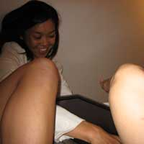
Dance without Bodies
Koosil-ja's Dance without Bodies :: The Kitchen :: Dec 6-9 (Wednesday-Saturday) 8pm :: Tickets $12.
Dance Without Bodies is a new, commissioned, dance and multi-media performance by Bessie award-winning choreographer Koosil-ja that questions the fundamental role of “presence” in performance and forges new relationships among dancers, technologies, and the audience. In this new work, two dancers move between the space of the stage and that of video projections, performing simultaneous yet spatially disconnected solos for an audience seated in two separate areas, situated back-to-back in the theater. Created through her “live processing” performance method, which she developed with dancer Melissa F. Guerrero and Geoff Matters (music, video, and software design), the performance is different each night, as the movement in the work is neither strictly set choreography nor pure improvisation. Rather, the dancers generate their solos nightly, in real-time, in response to the action depicted on three different videos, which are randomly combined each evening on clustered sets of monitors. The piece also includes lighting design by Jane Shaw, video design by Benton-C Bainbridge, and graphic design by Pascale Willi.
Box Office: 212-255-5793 ext. 11. Box Office Hours: Tue-Sat, 2-6pm
The Kitchen is located at 512 West 19th Street between 10th and 11th Avenues.
Subway: A, C, E to 14th Street; 1 to 18th Street; L to 8th Avenue.
Posted by jo at 04:57 PM | Comments (0)
Live Transmissions
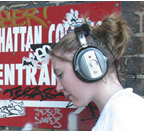
Implications of Paranoia in Sound Art
These days, a radio is a common transmitter of music and information. Historically, radios have had notorious alternative functions as instruments of surveillance. In this article, Anastasiya Osipova discusses how recent sound artists have incorporated the psychology of paranoia into their work, fitting for an environment where surveillance is constant and technology is fervently deployed to detect that which is hidden.
"Newly recruited member of the Resistance walks down the street. Anxiety circulates under his skin. Several uniformed men block his way. “What is inside your suitcase, sir?” “Radio.” They let him pass. He walks into what appears to be a shop, hands the radio transmitter to a portly woman who is standing firm on her high heels, cigarette held to her mouth. At that moment he feels that she, who he is seeing for the first time in life, is closer to him than any family member could possibly be.
Military and entertainment industries share equipment: magnetophones, vocoders, synthesizers, and other tools routinely used by musicians each originally had military functions, to say nothing of the radio, a notorious spy fetish. Leon Theremin, famous inventor of the electronic instrument bearing his name was, tellingly, also a secret agent. Together with technology, radio and sound-related arts have inherited a drive for detection often bordering on paranoia. The suspicion of invisible channels of information into which one is somehow implicated against one’s will—or of networks of communication from which one is excluded—is amplified. Recognizing the psychological power their medium can wield, radio artists are employing its technology in a manner analogous to how the armed forces would: to disclose the invisible and, when appropriate, to mobilize resistance against it." Continue reading Live Transmissions by Anastasiya Osipova, NYFA Current.
Posted by jo at 04:52 PM | Comments (0)
Spaces Speak, Are You Listening?
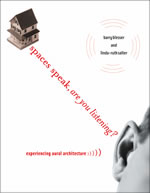
Experiencing Aural Architecture
Spaces Speak, Are You Listening? Experiencing Aural Architecture by Barry Blesser and Linda-Ruth Salter :: We experience spaces not only by seeing but also by listening. We can navigate a room in the dark, and "hear" the emptiness of a house without furniture. Our experience of music in a concert hall depends on whether we sit in the front row or under the balcony. The unique acoustics of religious spaces acquire symbolic meaning. Social relationships are strongly influenced by the way that space changes sound. In Spaces Speak, Are You Listening?, Barry Blesser and Linda-Ruth Salter examine auditory spatial awareness: experiencing space by attentive listening. Every environment has an aural architecture.
The audible attributes of physical space have always contributed to the fabric of human culture, as demonstrated by prehistoric multimedia cave paintings, classical Greek open-air theaters, Gothic cathedrals, acoustic geography of French villages, modern music reproduction, and virtual spaces in home theaters. Auditory spatial awareness is a prism that reveals a culture's attitudes toward hearing and space. Some listeners can learn to "see" objects with their ears, but even without training, we can all hear spatial geometry such as an open door or low ceiling.
Integrating contributions from a wide range of disciplines--including architecture, music, acoustics, evolution, anthropology, cognitive psychology, audio engineering, and many others--Spaces Speak, Are You Listening? establishes the concepts and language of aural architecture. These concepts provide an interdisciplinary guide for anyone interested in gaining a better understanding of how space enhances our well-being. Aural architecture is not the exclusive domain of specialists. Accidentally or intentionally, we all function as aural architects.
As a former Professor at MIT and a founder of digital audio, Barry Blesser has spent the last 40 years working at the junction of audio, acoustics, perception, and cognitive psychology.
Linda-Ruth Salter, Ph.D., is an independent scholar who has spent the last 25 years focusing on the interdisciplinary relationship of art, space, culture, and technology. [via iDC]
Posted by jo at 12:12 PM | Comments (0)
November 20, 2006
Margot Kaminski's interview with
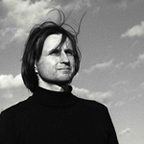
McKenzie Wark
"...how is anyone except the media conglomerates going to make a living when they have commodified culture to within an inch of its life? How are they even going to make a living off it? It’s never been done before in the history of the world.
On the networked book: this also is something that is not as new as it looks. Literature has always been networked. As the German media theorist Friedrich Kittler and his followers argue, there would be no novel without a postal system. The book as artifact and the book as vector, or relation between points, always go together.
What the networked book needs, however, is new tools, new conventions, new economies. That’s where GAM3R 7H30RY and experiments like it are interesting. It’s about reinventing the connective tissue between books, across space and time, and between different kinds of reader. It’s about making an end-run around monopolies of knowledge and culture. Creative Commons is a key part of that process. But so too are new media tools, and perhaps even more importantly, new cultural, social, and literary conventions. We need to relearn how to read and write." From McKenzie Wark: INTERVIEW bY Margot Kaminski, Creative Commons, OCTOBER 2006
Posted by jo at 02:51 PM | Comments (0)
Defining Lines:
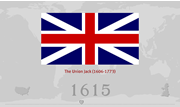
Breaking Down Borders
[image: National Velvet by David Crawford] Defining Lines: Breaking Down Borders :: This exhibition will attempt to present a comprehensive survey of the work of artists who are breaking down the borders or boundaries that define artistic practise in the 21st century. From the computer DESKTOP, to DOWNLOADABLE COMPUTER VIRUSES, OPEN SOURCE AND CODE CRACKING SOFTWARE, and E-BOOKS, to ALTERNATIVE NETWORK BROWSERS, OPERATING SYSTEMS and SHAREWARE/FREEWARE, DOMAIN NAME SERVERS, to GAMING PATCHES, LISTSERVS, ONLINE THEATER (in the form of activism, or ELECTRONIC PROTEST) -- what constitutes "ART" is being re-defined as EMERGING TECHNOLOGIES and mediums are giving artists the "TOOLS" and a new means of expression. In addition, our notions or definitions of the tangible, physical "BORDER" "TERRITORY" or "OWNERSHIP / PROPERTY" is being transformed in the virtual realm of cyberspace. The idea of territory becomes one of "INTELLECTUAL PROPERTY" and "COPYRIGHT / LEFT". Geopolitical, and topographical territories are being replaced with domain of the Corporations and Governmental Agencies (ICANN) who control the "space" of the World Wide Web. Borders existing on the network, tracing the idea of "open" borders vs. "closed" borders, similarly we look at "firewalls", "encryption", "carnivore"; in contrast to "open source", "General Public License" (and therefore the ideas of "authorship") "sharing of files", "data transfer". The "SERVER" or "HARD DRIVE" as the new territory where "HACKING" and "ART" exchange fertile ground in the realm of the digital NETWORK we know as the Internet. Artists and Activists have their say in the wide open territory of the WWW, creating a hybrid art form called "PRACTIVISM" (Paul Garrin). Hackers and Activists merge and become "HACKTIVISTS" (Electronic Disturbance Theater). A new form of electronic theater or digital performance art is developing, that of the Online Protest, or "VIRTUAL SIT-IN".
At the beginning of the 21st century, we see that the words of Joseph Beuys has its corollary in the electronic realm:
"...Social Sculpture--how we mold and shape the world in which we live: SCULPTURE AS AN EVOLUTIONARY PROCESS; EVERYONE IS AN ARTIST...All around us the fundamentals of life are crying out to be shaped, or created." -Joseph Beuys
ARTISTS:
0100101110101101.ORG
Mark Amerika
Betty Beaumont
C5 Corp
David Crawford
Douglas Davis
Andy Deck
Electronic Disturbance Theater(EDT)
Epidemic-C / 0100101110101101.ORG
Fakeshop
Peter Fend
Joy Garnett
Paul Garrin
Marina Grzinic & Aina Smid
Wenda Gu
Ingo Gunther
Fran Ilich
I/O/D
Irational.org
Jodi.org
Eduardo Kac
Yael Kanarek
Knowbotic Research
Tina LaPorta
Jenny Marketou
Jennifer + Kevin McCoy
MEZ (aka Mary-Anne Breeze)
Mark Napier
Netochka Nezvanova
Marko Peljhan
RTMark
Scanner (aka Robin Rimbaud)
Linus Torvalds + others
Stephen Vitiello
Ade Ward
Posted by jo at 02:19 PM | Comments (0)
Glowlab
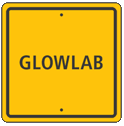
Issue 11
Welcome to Glowlab Issue 11! The projects in this issue examine the presence of surveillance within public space, and the ways in which ubiquitous technologies, such as electronic tags, global positioning systems, SMS messaging, and other locative media are informing the ways in which we interact within urban environments. These artists utilize these technologies to create mobile orchestras, jam turnstiles, observe the observers, and put the means and the media of production into the hands of ordinary citizens. This issue also includes independent curator Anuradha Vikram's review of Psychogeography by Merlin Coverly.
Transparent City: The ethics and aesthetics of mass-surveillance technologies by Derek Lomas :: Mobile phone carriers track our location and keep a record of everywhere that we have been. TRANSPARENT CITY is a prototype surveillance interface demonstrating how widespread mobile phone technology could be transformed into an apparatus for massive governmental control.
The Warbike and Wardriving: Geeks Don't Know it's Psychogeography by David McCallum :: The Warbike is a mobile, interactive artwork that sonifies WiFi networks during a bike ride. This article describes the process of creating the system, and touches on the links between psychogeography and wardriving.
Inner city locative media: The Media Portrait of the Liberties project by Valentina Nisi :: The Media Portrait of the Liberties is a modular collection of anecdotal stories drawn from a disadvantaged Dublin inner city neighbourhood called the Liberties. The narratives are displayed as short video clips on a location-aware handheld computer.
TXTual Healing by Paul Notzold :: TXTual Healing is an interactive project that enables members of the public to interact with large speech bubbles that are projected onto flat surfaces, such as the facades of public buildings, using SMS messaging.
arphield recordings by Paula Roush :: Arphield Recordings is a project documenting impromptu arphid sound performances produced by people scanning their oysters cards in their daily routines of accessing London tube stations.
Fête Mobile and Inflatable Art by Marc Tuters, Fête Mobile :: Movable Feast/ Fête Mobile is a 6-meter blimp equipped with surveillance and communications capabilities that enables participants to remotely view their surroundings and exchange media files through a wireless file server. In his article, we discuss the development of the project.
Book Review: Psychogeography by Merlin Coverley by Anuradha Vikram :: Psychogeography is a primer on the practice and its precedents, inspired by the neo-psychogeographic revival in London over the past two decades, and focusing specifically on the theoretical lineage of contemporary British writers.
Glowlab is an artist-run production and publishing lab engaging urban public space as the medium for contemporary art and technology projects. We track emerging approaches to psychogeography, the exploration of the physical and psychological landscape of cities. Our annual Conflux festival, exhibitions, events and our bi-monthly web-based magazine support a network of artists, researchers and technologists around the world.
Posted by jo at 01:40 PM | Comments (0)
Kazoo
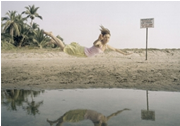
It's a Live Art Thing
The Premises Gallery at The Johannesburg Civic Theatre presents Kazoo - it's a live art thing; Performance/ Live Art: Play, Action, Intervention in Public and Private Spheres :: Launch Event: 2nd of December 2006, doors open at 6pm, performances begin at 7pm; Performances in Public Places: 3rd of December 2006.
The launch of Kazoo, at Premises Gallery on Saturday December 2nd is the first ever international annual event of its kind in Johannesburg. At the opening there will be maps available for performances/ actions and interventions that will be held in Johannesburg in Public Spaces on Sunday, December 3rd.
In South Africa there is a trend in art towards issues that are socio-political and have a limited audience. We recognize the relevance of these issues; however we are aiming to look at things through a different lens. Our intention is to be unpredictable, accessible and more democratic. We believe that the more playful side of art needs to be given attention. It is our goal through Kazoo to promote performance art which focuses on play, action and intervention. We hope to give local and international, emerging and established artists working within the Live Art / Performance Art arena an opportunity to engage with the people and space within the city of Johannesburg.
In turn we will try and reach a diverse audience that will create an exchange between artist and community. The artists we have chosen are working in ways that are playful in nature, engaging, which break the typical ideas of performance and deal with issues of space and accessibility. We want the people of Johannesburg to be excited about art.
Participating Artists: Juliana Smith (USA), and Anthea Moys (SA) are pleased to present the following artists, Penny Siopis (SA), Benedikt Partenheimer (Germany), Lerato Shadi (SA), Alison Kearney (SA), Ella Ziegler (Germany), Barend de Wet (SA), Simon Gush (SA), Donna Kukama (SA), Karin Lustenberger (Switzerland), Sarah Burger (Switzerland), Maja Marx, Edda Holl (Germany), Jemma Kahn (SA), Nhlanhla Thulane (SA), Nina Barnett (SA) and Robin Nesbitt (SA), Timo Mueller (SA) and Jonas Etter (Switzerland).
Kazoo is proud to have the support of the American Embassy, Goethe-Institut, Wits School of Arts, Absolute Vodka and Red Bull.
Event Enquires: Anthea Moys 084-822-6577 / Juliana Smith 076-612-8290 ; azoo.liveart[at]gmail.com
The Premises at the Johannesburg Civic Theatre :: Loveday Street, Braamfontein, Johannesburg, South Africa :: www.onair.co.za/thepremises
thepremises[at]onair.co.za :: Gallery Hours - Tuesday - Saturday 10h00 - 17h00
the trinity session
office[at]onair.co.za
Directors -
Stephen Hobbs
+27 (0) 11 403 8358
sh[at]onair.co.za
Marcus Neustetter
+27 (0) 11 339 2785
mn[at]onair.co.za
Posted by jo at 01:24 PM | Comments (0)
Subtle Technologies: in situ, art | body | medicine

CALL FOR SUBMISSIONS
May 24th – May 27th 2007 :: University of Toronto, Toronto Canada :: Submission Deadline January 3, 2007 :: Subtle Technologies is a four-day multidisciplinary Festival exploring complex and subtle relationships between art and science. The annual international event combines symposia, exhibitions, workshops and performances that juxtapose cutting-edge artistic projects and scientific exploration.
For the 10th Annual Festival, Subtle Technologies invites practitioners of arts, sciences and medicines, and those who study their context, historians, ethicists, and other critical thinkers to contemplate how these disciplines can work together and reshape perspectives on the body.
As scientific and technological breakthroughs prominently occupy our culture, we ask where the boundaries are. We are interested in investigating how we relate bodies in situ: as parts, as a whole, as systems; how we identify, map, modify, protect, violate, and heal.
We invite a wide interpretation of bodies including the molecular, physical, cultural, economic, legal, political, energetic, electrical and spiritual.
A range of approaches are welcome, including interdisciplinary work, specialized presentation proposals that focus on a single topic in depth, and general discussions that draw upon multiple topics. We welcome a diversity of presentation formats, including those practitioners who may not emphasize the use of science and technology.
Proposals for the following will be considered: workshops, performances, poster sessions, and symposium presentations.
How to Apply:
Details are available on the online submissions form
Examples of possible topics include:
Racial and Personalized Medicine
Tele-Medicine
Pharmaceuticalized Body
Organ Trafficking
Inter- Species Communications
History of Medicine
Reproductive Technologies
Addictions and Obsessions
Sexual / Gendered Body
Body Machine Interfaces and Sensors
Violated Body
Embryoid Bodies and Stem Cells
Infectious Agents and Diseases
Local or Traditional Healing Practices
New Therapeutic Paradigms
Population Dynamics and the Environment
Spiritual Body
Extropian and Post Human Investigations
Body and Performance, Body and Rituals
Bioethics
Trangenic Bodies and Tissue Engineering
Genomics Proteomics Metablomics and other -omics
For Questions, contact us at:
(email) programs [at] subtletechnologies [dot] com
(phone) 416.532.5018
Subtle Technologies is hosted by the University of Toronto, and supported by Canada Council for the Arts, Ontario Arts Council. Toronto Arts Council, Canadian Heritage
Posted by jo at 08:54 AM | Comments (0)
NOW - Meetings in the present continuous

NEURóTICA
NEURóTICA: - CCCB - Barcelona, Spain :: Friday 24th November, 2006 at 7.00 pm:
[Contemporary man] is blind to the fact that, with all his rationality and efficiency, he is possessed by "powers" that are beyond his control. His gods and demons have not disappeared at all; they have merely got new names. They keep him on the run with restlessness, vague apprehensions, psychological complications, an insatiable need for pills, alcohol, tobacco, food – and, above all, a large array of neuroses. (Jung, 1964:82).
Neurotica is a research project that examines the anxieties of contemporary society, generated by the rapid advances made in science and technology, and looks at the way individuals and the community is coping with these innovations and their offshoots. The project has been designed and initiated by Capsula, an investigation group based in Barcelona, Spain, launched by Mónica Bello Bugallo and Ulla Taipale that generates cultural products exploring the interrelations between arts, science and nature.
The first phase of Neurótica is exploring society’s perception of biotechnology and the hopes and fears associated with it. The project will be launched by a conference presented at CCCB, Center of Contemporanean Culture of Barcelona on 24th November 2006. During the event Californian based artist and inventor Natalie Jeremijenko will present her views on these issues, followed by the interventions and comments of Dr. Alfonso Valencia, a biologist and head of The Spanish National Center of Biotechnology and Dr. Fabio Tropea, sociologist and language analyst.
The conference is part of “NOW - Meetings in the present continuous” –a project that reflects on the present on the basis of the scientific, technological, artistic, social and spiritual transformations taking place at the start of the 21st century. It aims to bring together local and international agents promoting a change of paradigm in current society.
For information: info[at]capsula.org.es
Posted by jo at 08:38 AM | Comments (0)
A THOUSAND TINY SEXES
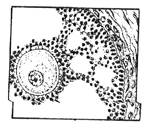
CALL FOR WORK
A THOUSAND TINY SEXES: A publication edited by Jaimes Mayhew and kanarinka
CALL FOR WORK: To imagine that there are only two sexes - M & F - is an absurdity. There are at least 1000 sexes. The daily lived reality of transgender and intersexual people (and gay, lesbian, queer and all other people, for that matter) proves this over and over again, yet many people continue to operate as if 'M' and 'F' are the only sexes, the only options, the only expressions, the only goals, the only way ("the way it is").
Help us imagine 1000 more sexes. Describe them, imagine them, invent them, publish them, use them, realize them, perform them.
A Thousand Tiny Sexes is an art-book-research-action project to collect and publish 1000 proposals for TINY SEXES which are not Male or Female. We are setting out to collect a thousand more sexes - imaginary ones, as-yet-unrealized ones, or real ones- in the hopes that these one thousand might make for one thousand more after that. In so doing, we hope to contribute to a collective reimagining of sex as a legal, biological, political, economic, cultural, and political category.
ABOUT THE PUBLICATION
The collection of A Thousand Tiny Sexes will be published as a book with an introductory essay by the editors, Jaimes Mayhew and kanarinka. We are seeking publishers. The publication will be available for sale once published. Submissions must meet the criteria below and the editors reserve the right to reject any submission.
GUIDELINES FOR SUBMISSION
* Deadline: No deadline, we will keep collecting until we have 1000 good ones.
* You may not propose a sex such as Male or Female that has been legally codified and naturalized as "the way things are".
* You may propose "in-between" sexes which are combinations of Male-Female, but we will favor sexes that seek to entirely reimagine sex as a biological, cultural, political, and social category.
* Multiple submissions OK.
* We prefer visual submissions to text, though both are ok. Diagrams and drawings with fine lines are especially encouraged.
* Original artwork will not be returned.
HOW TO SUBMIT
* Download and Complete the submission form on the website
* Attach your Drawing, Image or Text. 1.5 inches x 1.5 inches (3.8 cm x 3.8 cm) or less in dimensions. B&W, no Color.
* Email 300dpi electronic submissions to 1000tinysexes@[at]mail.com or mail them to: Jaimes Mayhew, 102 Longwood Ave #3, Brookline, MA, 02446.
QUESTIONS?
* Email us at 1000tinysexes[at]gmail.com
* Visit the site at www.1000tinysexes.com
IN CASE YOU WERE WONDERING ABOUT THE TITLE
"If we consider the great binary aggregates, such as the sexes or classes, it is evident that they also cross over into molecular assemblages of a different nature, and that there is a double reciprocal dependency between them. For the two sexes imply a multiplicity of molecular combinations bringing into play not only the man in the woman and the woman in the man, but the relation of each to the animal, the plant, etc.: a thousand tiny sexes." (Deleuze and Guattari, A Thousand Plateaus).
"There is nothing about a binary gender system that is given." (Judith Butler, Undoing Gender)
Posted by jo at 08:30 AM | Comments (0)
November 18, 2006
Franck Ancel
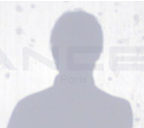
Tuut: Utopia of Theater
"Studying the terrain, the litterateurs believe they have established the existence of a major psycho-geographic crossroads — with Ledoux's Rotonde de la Villette at the centre – which can be described as a unity…" - the journal Les Lèvres nues, November 1956, Paris.
Mobile_Wireless_Digitale, for the bicentenary of the death of the utopian architect Claude Nicolas Ledoux in Paris, faced with the extension of the Cité des Sciences et de la Musique. I am no longer drafting a utopian performance which could have involved an immersive projection (cf. estimate drawn up with the UTRAM company) within Ledoux's Rotonde, and have been made possible by means of an inflatable dome (cf. study by another company), as conceived by me since 2001.
In contrast with some of the anticipated utilitarian hijackings aimed at establishing a modicum of social aesthetics on the square that is dedicated to the battle of Stalingrad in Paris, my idea involved a light and sound projection at the entrance to this capital: issues not only of physical fluidity but also fluidity of data. Thus, this space that traces the old boundaries closing in on the city, would be transformed by opening up the city, at a time when a dark globalisation is being prepared for us by some of the uses to which technology is being put.
I therefore propose an open-access 3gp stream broadcast from GPS co-ordinates N 48°53.365' E 002°22.555' to video receivers at this address: rtsp://217.71.210.164/ancel/19 , to other portables and on the Internet, on 19 November 2006 between 19:00 and 20:00 (Paris GMT). The 3D animation of this presentation has been created in association with Bryan Bey. It transfigures my Black Time epoch, for this action is primarily the echo of a manifesto for a Pari(s) lancé dans un lyrisme électronique (‘Paris (bet) cast in an electronic lyricism'), between active memory and the virtual future. - Franck Ancel
Posted by jo at 11:49 AM | Comments (0)
Resistant Maps:

Artistic Actions in the Interconnected Urban Territory
The Leonardi V-Idea Association presents the exhibition-conference: Resistant Maps: Artistic actions in the interconnected urban territory by Alessandro Ludovico, Gianfranco Pangrazio, Tommaso Tozzi, Marco Villani :: November 25-26, 2006 :: Contemporary Art Museum of Villa Croce: Via Jacopo Ruffini 3, Genoa.
The representation of the territory holds a historical role in the privileges of power. The geographical data has always been in its hands. The regaining of this representation goes through the description and sharing (often in personal perspectives too). This is made possible thanks to the collaborative tools and consequent changing of the value of the maps. These maps are not granted anymore by structures of power, but built by individuals who, drawing on the ideas of the psychogeographical movements, repaint the urban space according to fresh new coordinates.
WORKS BY: 01.org Vopos :: Cartografia Resistente Triangolazione :: Les Flottants Lasciare libero il passo :: Giuseppe Chiari Musica verità, Suonare la città, Che cos’è un happening :: Vincenzo Agnetti Spazio perduto e spazio costruito :: Guy Debord In girum imus nocte et consumimur igni :: Ernesto Fialdini, Matteo Dentoni Debordare.
CONFERENCE
SATURDAY 25 NOVEMBER 2006
Nicola Bucci 16.00-16.30
Sandro Ricaldone 16.30-17.00
Tommaso Tozzi 17.00-17.30
Decoder (Raffaele Scelsi) 17.30-18.00
Discussion 18.00-19.00
SUNDAY 26 NOVEMBER 2006
Alessandro Ludovico 10.00-10.30
Wikiartpedia (Tommaso Tozzi) 10.30-11.00
Cartografia Resistente (Lorenzo Tripodi) 11.00-11.30
Guerrigliamarketing (Andrea Natella) 11.30-12.00
Discussion 12.00-13.00
Lunch break
Vittore Baroni 15.30-16.00
Arturo Di Corinto 16.00-16.30
Franco Berardi “Bifo” 16.30-17.00
Brian Holmes 17.00-17.30
Discussion 17.30-19.00
(Giuseppe Chiari, Gianni Emilio Simonetti and Mirella Bandini have also contributed to the catalogue with their articles).
This exhibition has been organised with the support of the City of Genoa Council, the Head of Culture of the City of Genoa Council, the Contemporary Art Museum of Villa Croce, Association “Amici dei Musei”.
Catalogue printed by: neos.edizioni.
For further information contact Marco Villani (tel. 0039 340.3160660)
Posted by jo at 11:38 AM | Comments (0)
November 17, 2006
Priceless
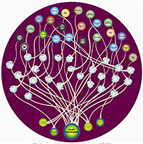
Underground Station Social Network Art
"We have created priceless, a multi-layered artwork in which the voices of individuals and institutions merge in surprising and unexpected ways. Objects of great value have been chosen by each institution to inspire an imaginative journey. People's unique stories and memories are showcased through audiovisual portraits, mobile exhibitions, installations and large-scale projections."
At London’s Huntington Station, a series of portraits and maps along the floor and walls reveal the Underground’s staff networks. The project is called Priceless. A sample of the images by motiroti is shown above.
London Underground staff have worked at the station for 138 years at the hub of a unique community of traders, museum workers, loiterers and licensed buskers who create the background atmosphere of this rich and complex environment.
motiroti has worked with LU staff to explore their personal connections and social networks. The participants were recorded in sound, video and writing by motiroti artists, who translated this information into an extraordinary series of graphic portraits and maps.
Along the length of the tunnel, 17 wall graphics and 26 individual floor constellations reveal the staff’s “hidden maps” of connections, and their personal worlds. Staff at South Kensington are connected with 66 national cities, 41 international cities, and with their friends speaking a total of 33 languages. Via Information Aesthetics [blogged by Judy Breck on Smart Mobs]
Posted by jo at 05:09 PM | Comments (0)
BlueStates:
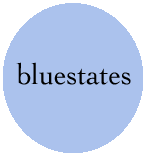
Exploring Relational Space
Cities are not merely collections of buildings; they are the living, breathing, teeming product of the human bodies who inhabit them. A city razed to the ground may recover, but a city emptied of people is dead. Yet emphasis is always given to the locative nature of a city - the neighborhood you live in, the street, the floor, the unit - an assertion of a Cartesian primacy which ignores the more profound natural relationships of the city: the coming together and parting of human beings living social lives. Cities are their people; souls are the bricks from which a city is constructed.
BlueStates: Exploring Relational Space--by Mark Pesce and John Tonkin--is an attempt to reverse the figure and ground of the city, ignoring its visible nature as a locative, Cartesian space, creating, instead, a view of the city purely as a social space. In this work, the trope of absolute location is abandoned in favor of the idea of relational proximity. BlueStates does not show you where you have been, but rather, it shows you who you have been with - a more perfect metric for the inner life of the city.

The inspiration for BlueStates is drawn from the recognition that most of us, most of the time, carry that most common of 21st century appliances, the mobile phone. Most of these mobile phones are equipped with a wireless technology known as Bluetooth. A Bluetooth mobile phone user creates a radius of electronic awareness - what we call a "bluesphere" - extending as much as ten meters from their body. When two Bluetooth devices pass in proximity to one another, each senses the other. Data is exchanged - and promptly ignored. BlueStates: Exploring Relational Space uses its own, custom software sensors - which run on mobile phones, PDAs and computers - to listen intently to the bluesphere. These sensors contribute to a database record of proximal encounters, and this data is then used to build views into the social life of the city's residents.
BlueStates is by its nature a highly participatory work. Anyone will be able to visit the website and create their own views into relational space. Residents of cities around the world will be encouraged to add their own sensors to the global network of sensors, expanding the database to incorporate the inner social life of their own cities. Beyond this, the work's creators have committed to releasing all software developed for the project as as free and open source software (under the GNU General Public License), believing this will encourage others to create their own projects in relational space. Finally, artists will be provided with tools to that will allow them to permute the data gathered by BlueStates: Exploring Relational Space in new and unique ways.
The two artists behind BlueStates have spent their careers exploring the intersection between art and technology. Mark Pesce is best known as the inventor of VRML, the standard for 3D on the World Wide Web, and has pioneered new interactive techniques for a quarter of a century. John Tonkin has consistently produced a stream of artworks that twist technology (and, occasionally, his body) into new and unexpected forms. Currently based at the University of Sydney, he has been involved in a broad range of projects including a collaboration at the Banff Centre for New Media Arts and a fellowship funded by the Australia Council. [from ISEA 06, via pasta and vinegar]
Posted by jo at 04:32 PM | Comments (0)
IF Comp 2006 Winners

Emily Short’s Floatpoint
The results are in, and Emily Short’s Floatpoint takes top honors at the 2006 Interactive Fiction Competition. The Primrose Path by Nolan Bonvouloir and The Elysium Enigma by Eric Eve placed second and third. Congratulations to these authors and to the others who finished games, entered them, and placed in the Comp. Another person who deserves thanks and congratulations is Stephen Granade, who has been running the Comp since 1999. All the games are still available for download, of course.
Reviews of games will be flowing freely soon, and I’ll try to add links to these in comments below. I certainly encourage you, if you are posting reviews yourself and are reading this, to add a comment with a link. [blogged by Nick on Grand Text Auto]
Posted by jo at 02:51 PM | Comments (0)
XpositionREVERSE
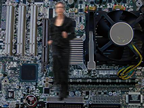
A Modern Gesamtkunstwerk
XpositionREVERSE :: Aarhus/Denmark – Gothenburg/Sweden :: Real-time streaming: web :: November 29 -December 2; 8 p.m.
XpositionREVERSE is a live digital chamber performance about position and identity on and with the Internet. Presented simultaneously in Aarhus and Gothenburg, and streamed on the Internet, XpositionREVERSE s a surrealistic and humorous montage of new text, dance, video, electro acoustic music and streamed bits. A modern Gesamtkunstwerk, placing itself somewhere between installation and the intimate chamber play. Inspired by cabaret, sitcoms and cosy evenings in the sofa.
XpositionREVERSE is a complex creation about being outside and excluded contra to be inside and included. About being in the centre of the events contra being in the periphery. The performance is about the modern man’s need to be "on" and wish for "15 minutes of fame". But do we only exist if we are seen, filmed and are placed in the focus point of the media lens? What defines centre and where is it placed? And what will happen, if focus is moved and periphery and centre is swapping place?
To be another place. Another position. Xposition.
To expose oneself. Exposure. Exposition.
PARTICIPANTS IN AARHUS
Staging, choreography and performer: Annika B. Lewis
Dramatist and performer: Gritt Uldall-Jessen
Interactive media and set design: Signe Klejs
Composer and live music: Anders Krøyer
Video technique and live music: Jens Mønsted
Internet architect and streaming: Jonas Smedegaard
For more information about live location in Aarhus and ticket reservations contact EntréScenen: phone: +45 86 190079 (10 – 16)
Produced by Kassandra Production in collaboration with Atalante in Gothenburg and EntréScenen in Aarhus, with others. Subsidized by The Municipality of Aarhus’ Kulturudviklingspulje, Koda, Dansk Skuespillerforbund and Tuborgfondet, with others.
Posted by jo at 12:34 PM | Comments (0)
MAAP-Multimedia Art Asia Pacific
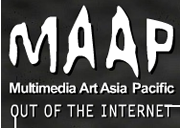
OUT OF THE INTERNET
MAAP-Multimedia Art Asia Pacific :: OUT OF THE INTERNET :: features: *CANDY FACTORY PROJECTS (Fukuoka), Feng Mengbo (Beijing), LIM + PHUA (Singapore), Iain Mott (Melbourne) , YOUNG-HAE CHANG HEAVY INDUSTRIES (Seoul) :: Opening: 6:00pm Thursday 30 November :: Exhibition: 1 December – 25 January 2007 :: State Library Queensland, Stanley Place, South Bank.
OUT OF THE INTERNET as the theme for this years festival considers artists that are working in or connected through internet art practice. The festival explores locations and contexts that host the artists’ work to concretely realize the medium in a tiered series of situations. Without a whimsical word to say about cyberspace (the space in-between the physical location of a computer server and retrieval monitor) the task was set to realize presence in a range of locations from elite museums, galleries, library networks and into a cascade of urban spaces. The central exhibition is mounted in the newly rebuilt State Library of Queensland in Brisbane while the Institute of Modern Art host Singapore artists LIM + PHUA. In Shanghai, The Zendai Museum of Modern Art hosts Iain Mott.
In New York the Museum of Modern Art host a presentation in their MediaScope series by *CANDY FACTORY PROJECTS in conjunction with 'out of the internet'. And 'out of the internet' coincides YOUNG-HAE CHANG HEAVY INDUSTRIES online commission by Tate, London.
OUT OF THE INTERNET as a global exhibition takes a further step into the exploration of how we might consider and engage with artworks that ‘breath the air’ of the information age. It draws back to a dialogue with Seth Siegelaub’s ground breaking exhibition ‘July, August, September 1969’ where he arranged 11 artists to show in 11 different locations around the world and included artists such as Lawrence Wiener, Jan Dibbets, Joseph Kosuth and Sol LeWitt. A seminal figure of the conceptual art movement, Siegelaub was absorbed with the speed of communication and the transference of ideas rather than objects. In transcripts from an original interview by Patricia Norvell, Siegelaub describes the redundant nature of the museum space and challenges the New York centric nature of the art world. In some respects, the exhibition is putting to test working in reverse from Siegelaub’s position. The artists are circulating in the world through the internet already and it is not a simple mono cultural field in which these artists operate. The artists’ activities are apprehended through a span of online audiences, literature sites, university teaching programs, online gaming sites, information porn sites, nightclub entertainment, community workshops and galleries. The artwork is in fact apprehended by audiences in multiple fields simultaneously and puts challenge to Pierre Bourdieu’s pure sense of a singular view to the way art is perceived in its cultural field. The exhibition shepherds the work back into taking a material or contextual form in the museum to achieve an authority integrating different fields in which the artists operate and joining an official art history canon. Making a representation of all the works in the State Library of Queensland adds another dimension or escape route out of the closed museum context. ‘out of the internet’ then grafts onto the established library networks via links on library home pages all over the world, filtered through museum authority.
OUT OF THE INTERNET International Symposium:
Time: 1pm – 6pm Date: Sunday 3 December Place: slq Auditorium 2,
State Library of Queensland
This symposium examines the position of online artwork and the implications of the internet in fine art culture and community cross overs in Australia, Asia and internationallyA free event, essential to register: info[at]maap.org.au
MOVE ON ASIA - DVD Programme: The curators of twelve art spaces from six countries in Asia, presents 22 emerging artists.
OUT OF THE INTERNET (and into the world): Community workshops developed by Fatima Lasay focusing on open source software for artists working in the Philippines.
Artists’ Talk OUT OF THE INTERNET
Date: Friday 1 December Time: 1:00pm - 4:00pm
Place: slq 2 auditorium State Library Queensland: A chance to hear international and national internet artists speak about their practice
Manhua Wonderlands
Date: 1 December – 25 January 2007.
A major media arts exhibition and education initiative involving established and emerging artist working directly with Asian communities and site-specific venues which include karaoke clubs and purikura sticker booths. Manhua Wonderlands has developed an extensive network of public presentations, screening and links over 330 libraries, schools, museums, and urban sites in a common viewing experience. Manhua Wonderlands hosts major presentations by artists; Jemima Wyman, Van Sowerwine, Alice Lang, Luke Ilett, Jean Poole: curated by Thea Baumann
Further information info[at]maap.org.au
Posted by jo at 10:51 AM | Comments (0)
Trampoline 23rd November
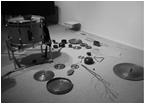
Gaming, New Media Art and our Urban Environment
Trampoline – Platform for new media art :: Thursday 23rd November 6pm til late :: Broadway Cinema, Broad Street, Nottingham, UK :: £5.50/£4.20 concessions.
Playing with urban structures - the city becomes alive at the touch of a button. Trampoline will be investigating the relationship between gaming, new media art and our urban environment.
The structures of the city are increasingly pervaded by new media with screens, cctv, electronic networks, mobile devices, implements often designed to control our movement through urban space and even to remove us from our surroundings. We wish to investigate how new media can form an even tighter relationship with our immediate environment – challenge and subvert its conventional structures – hacking the city.
The evening of events brings together performance, video, installation and artists’ presentations.
Blast Theory, renowned internationally as one of the most adventurous artists' groups using interactive media, will be giving a presentation about their most recent work ‘Day of the Figurines’, premiered at Trampoline’s event First Play Berlin, held in October of this year.
Le Quan Ninh will be bringing his unique form of percussion improvisation to Nottingham in a highly anticipated performance.
Electronic musicians Vastik Root and Little Boy Blue will be meddling with their gameboys and various computer consoles resulting in a climax of energetic noise.
Frank Abbott will be presenting his epic performance ‘From Here to the End of my Garden’ a series of four presentations throughout the evening, merging spaces together with his mobile projector, recreating his garden within Broadway Cinema.
Other works on show include:
An ‘urban carpet’ will be set somewhere in the streets of Nottingham and pedestrians may find the ground beneath their feet suddenly responding to their movements.
An interactive virtual pool by Giles Askham, creates visual and sonic response in the form of ripples as the viewer investigates ‘Aquaplayne’.
A new audio tour by Jon Aveyard will be available for you to experience the city in a very different way.
And Martin Callanan’s ‘Sonification of You’ will make tangible the mass of mobile phone signals, wifi networks and general electronic radiation which surrounds us by detecting these transmissions and making them audible.
Timetable for the evening:
6pm Film Screening
7pm Le Quan Ninh
7.30pm Vastik Root
8pm Patrick Farmer and James Smith – please bring a tuneable radio for a special performance
9pm Blast Theory
10pm Little Boy Blue
10.30pm Leif Gifford
8pm, 9pm, 10pm and 10.30pm Frank Abbott – From Here to the End of my Garden; Live Performance with a mobile projector.
Other participating artists include: Giles Askham, Jaygo Bloom, Thomas Laureyssens, Jon Aveyard, Martin Callanan, Carolina Briones, Andy Gubb, Joe Duffy, Kentaro Taki, Regina Kelaita and many more
Trampoline is supported by the Arts Council England, Broadway Media Centre and Future Factory.
Those interested in these events may also be interested in Futuresonic’s activities: Futuresonic launched Urban Play as the art and technology strand of the Futuresonic festival at the end of 2005, reflecting Futuresonic's focus since 2004 on artworks in urban space. Futuresonic 2007 will be announced soon, visit www.futuresonic.com or www.urban-play.org for details.
Posted by jo at 10:01 AM | Comments (0)
November 16, 2006
Second Life
COPYING A CONTROVERSY
"...The hack suggested a way of finally introducing AIs and non-player characters into the world, creating endless possibilities for game development, simulation, and more, but that wasn’t even the coolest part. Because not only had they figured out a way of introducing artificial avatars, they’d also hacked up a way of cloning existing avatars, clothes included. Not just one or two clones, but over a dozen, dropping out of the sky like godspawn.
Edited in double-time, this video demonstration features me, Talila Liu, and Gwyneth Llewelyn and our several dozen doppelgangers..." From COPYING A CONTROVERSY (Updated) [blogged by W. James Au on New World Notes]
Posted by jo at 07:31 PM | Comments (0)
Light Bead Curtain
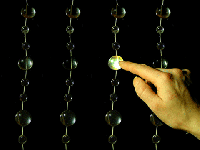
Woven Sounds
Light Bead Curtain is an interactive sound installation consisting of a curtain made of interactive beads. Each of the beads light up and emit a unique sound when touched by a user, enabling passers-by to play with the curtain by weaving their hands through it. The simple and direct interaction with the curtain makes users understand how to play. Although the primary goal of the curtain is to engage its users in play, the curtain can also function as an interactive display, as each bead can be controlled and programmed via a computer.
Light Bead Curtain is created by Ami Wolf and Jin-Yo Mok. The latter also created the SoniColumn. Via Interactive Architecture dot Org. [blogged by Lene Mailund on Digital Experience]
Posted by jo at 07:21 PM | Comments (0)
Garrett Lynch's review of
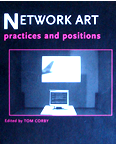
Networked Art: Practices and Positions
Finally managed to get hold of a copy of Network Art (perhaps the world’s most difficult to get net.art book) edited by Tom Corby (of Corby and Bailey and teaches Media Art at the University of Westminster) and gradually worked my way through it when I had a spare moment between classes.
The book, an outcome of research funded by the Arts & Humanities Research Board, takes a similar approach to Tilman Baumgärtel’s net.art 2.0 (and there is a text by Baumgärtel entitled The ludic hack: artistic explorations of computer games) in that it gives an overview of the practice of a selection of artists working with networks (principally the internet), their art, themes and method of working. It shouldn’t be compared with net.art 2.0 however as it does this differently. It takes a less historic overview of net.art, is more concerned with current practice than origins or development of the genre and this is executed in a number of ways, interviews, writings about art work, ideas and themes (net.art 2.0 is entirely interviews with the artists conducted by Baumgärtel).
The book is broken down into two sections, Contexts and Practices. Contexts, the first section, prepares the reader for some of the art discussed in Practices and contains writings by some of the most important theorists currently writing, curating and teaching about net.art and new media theory. Charlie Gere, Reader in New Media Research and Director of Research at Lancaster University, author of Digital Culture and Art, Time and Technology introduces the reader to The history of networked art, Sarah Cook who works at the University of Sunderland and has jointly set up Crumb, a new media curatorial reseource (also funded by the AHRB), with Beryl Graham writes about Context-specific curating on the web while Baumgärtel has a chapter which is already mentioned above.
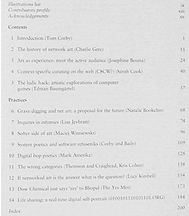
While the book is certainly a valid and welcome contribution to the area of net.art I do have a few issues with it. Due to the availability and price of this book, Routledge have put this out of the range of any curious readers / artists (at £75, sharp intake of breath, certainly any students) and refused to publish the paperback version (there was an ISBN released for this as it was initially listed on Amazon - send them an email requesting it), this is a publication which will only be bought by those who know the area well and are most likely practicing net.artists or researchers. The necessity of a chapter covering the history of net.art becomes a little redundant. This is certainly not an oversight of the author (Charlie Gere) or the Editor (Tom Corby) but of the publisher. Practices is a little less successful in my opinion than Contexts again this is related to who the book is targeted at. The contributors to Practices The Yes Men, Thompson and Craighead and 0100101110101101.org amongst others while contributing good texts are very much the standard fare of artists and we know these artists and their works very well. They are what have become the net.arts who have made the transition to the contemporary art world and exhibit widely. From a personal perspective it is a shame the book does not start to move away from net.art and discuss the now rapidly developing field of networked art (see Baumgärtel distinction) as it seems to suggest it will which we are seeing on weblogs such as here, Networked Performance and occasionally We Make Money Not Art.
All in all, a good publication which unfortunately simply will not get a significant audience. I can’t find any reference to contents of this book anywhere on the web although there is a list of contributors on the University of Westminster’s website. So above is a photo of the contents page. [posted by Garrett on Network Research]
Posted by jo at 07:05 PM | Comments (0)
Second Life
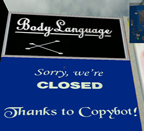
Businesses Close Due to Cloning
Copybot is a program designed to clone other people’s SL possessions. When someone sells an item in SL, they naturally have the option to limit what the purchaser does with it. People creating unique designs as a business enterprise don’t always want you to be able to issue infinite copies for free, after all.
The night before last, I was looking around a no-fire combat sandbox, where people design and test weapons and vehicles, when an argument broke out; a thing going by the name Nimrod Yaffle was cloning things out of other people’s inventories, and claiming he could freely do it because he’d been playing with Copybot with employees of SL creator/operators Linden Lab. All hell broke loose, in the sort of drama you can only find on the internet. Linden Lab’s first official response? If you feel your IP has been compromised by Copybot, we’ll sort of help you lodge a DMCA complaint in the US. Businesses started shutting down moments later. [posted by Warren Ellis on This Is The Warren Ellis Dot Com]
"Second Life needs features to provide more information about assets and the results of copying them. Unfortunately, these are not yet in place. Until they are, the use of CopyBot or any other external application to make unauthorized duplicates within Second Life will be treated as a violation of Section 4.2 of the Second Life Terms of Service and may result in your account(s) being banned from Second Life. If you feel that someone has used CopyBot to make an infringing copy of your content, please file an abuse report. Note that this is completely separate from any copyright infringement claim you may wish to pursue via the DMCA.
Like the World Wide Web, it will never be possible to prevent data that is drawn on your screen from being copied. While Linden Lab could get into an arms race with residents in an attempt to stop this copying, those attempts would surely fail and could harm legitimate projects within Second Life." Continue reading Use of CopyBot and Similar Tools a ToS Violation.
[posted by marc garrett on netbehaviour]
Copybot Protest:
Second Life, Economic Evolution and the CopyBot
"...If the ability to make copies continues to exist, these vendors argue, the basis of the SL economy will be destroyed. And since there's a direct conversion between in-game money and real-world money, anything that weakens the SL economy threatens the real-world economic livelihoods of many SL residents. They're right -- but is the Second Life economy worth saving?
What Linden Lab has tried to do is replicate the atom-world scarcity rules in a bit-world environment. Nobody should be surprised in any way that this doesn't work for long. It is the nature of bits to be easily copied. Even if Linden manages to shut down CopyBot, it will arise again in another form, and probably as something much harder to squelch. The death of Napster becomes the explosion of Gnutella and Bit Torrent; the death of CopyBot will mean the emergence of something more powerful and less easily eliminated. It's delightfully Darwinian..." From Second Life, Economic Evolution and the CopyBot, Open the Future]
Posted by jo at 06:39 PM | Comments (0)
November 15, 2006
WGBH’s Lab Sandbox

Open Content Initiative
WGBH’s online Lab, a virtual space designed to explore new content creation opportunities, with a focus on new media, launches its new video Lab Sandbox feature. This addition to the Lab’s current features, including the 6:55 Shorts: Open Call and the Filmmakers-in-Residence program, invites users to experiment with archived WGBH content. The WGBH Lab aims to support the innovative work of independent filmmakers and open the doors of WGBH to new voices and ideas.
The Lab Sandbox is an open content initiative modeled along the lines of the “Find it, rip it, mix it, share it” BBC Creative Archive. Lab Sandbox is an online space within the WGBH Lab where the users can gain access to use rights-cleared, WGBH-owned content to use for their own (non-commercial) purposes. The public is invited, but not required, to share the results of their work by posting a link to the site. Users will be able to post comments on each other’s work.
“As with all programs in the WGBH Lab, the Lab Sandbox is meant to push open the doors of WGBH and to invite in new, diverse and innovative voices,” said Boston Media Productions Executive-in-Charge Denise DiIanni.
The Lab Sandbox features different selected video clips, including some with themes of science, nature and history. WGBH aims to build on the selection currently offered by getting feedback from users about their need for open content, and by clearing the rights for additional content.
About WGBH: WGBH informs, inspires, and entertains millions of people throughout New England. Boston’s last remaining independent TV station, WGBH is the leading producer of PBS prime-time programs and online content, a major producer for public radio, and a pioneer in educational multimedia and services that make media accessible for people with disabilities.
Posted by jo at 03:33 PM | Comments (0)
Opening at Ars Virtua Tonight
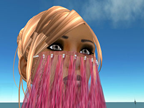
13 Most Beautiful Avatars
13 Most Beautiful Avatars by Eva and Franco Mattes (a.k.a. 0100101110101101.ORG) :: Curated by Marisa Olson :: Nov. 15 - Dec. 29, 2006 at Second Life's Ars Virtua gallery. Nov. 30 - Dec. 19, 2006 at The Italian Academy, Columbia University (NYC).
"13 Most Beautiful Avatars" is the newest installment of Time Shares, a series of online exhibitions co-presented by the New Museum of Contemporary Art and Rhizome.org, in conjunction with Rhizome's "Tenth Anniversary Festival of Art & Technology". The exhibition, in Second Life's increasingly popular Ars Virtua gallery — a virtual nonprofit arts organization — will mirror the art gallery in which the newest work by Italian artists Eva and Franco Mattes (a.k.a. 0100101110101101.ORG) is being exhibited.
The Matteses have been living in the virtual world, Second Life, for over a year, exploring its terrain and interacting with its peculiar inhabitants. The result of their "video-game flanerie" is a series of portraits, entitled "13 Most Beautiful Avatars". Not unlike Warhol's entourage of stars, captured in the "13 Most Beautiful Boys" and "13 Most Beautiful Women" portrait series emerging from his famous Screen Tests, the Matteses' "13 Most Beautiful Avatars" captures the most visually dynamic and celebrated "stars" of Second Life.
The portraits reflect Second Life aesthetics, featuring the bright colors, "artificial" light, broad flat areas, 3D shapes, and surreal perspectives that are typical of this virtual world. Overall, the series draws on the technological developments which allow the creation of alternate identities within simulated worlds, and questions the impact such technologies have on art and society. Despite the relative newness of using video game-derived source materials, the avatars' icons recall questions common to earlier eras of portraiture, including the cultural and psychological context of the images, and the relationships between high art and subculture, between contemporary art and "traditional" art forms, and between art and life itself.
Eva and Franco Mattes are known for their controversial artworks, including staging high-profile hoaxes and defeating the Nike Corporation in a legal battle for a fake advertisement campaign. They are the recipients of the 2006 "Premio New York" grant, sponsored by the Italian Ministry of Foreign Affairs and the Italian Cultural Institute, New York. Their real-world exhibit takes place at the Italian Academy at New York's Columbia University, and a 3D replica of this physical exhibition space has been recreated for presentation of an exhibition identical to the "real" one, at Ars Virtua.
The Second Life / Ars Virtua show is open November 15 - December 29, and the Italian Academy show is open November 30 - December 19. The Ars Virtua exhibit will be launched with an in-world opening reception on November 15, from 6-8pm SLT/9-11pm EST, here: http://slurl.com/secondlife/dowden/42/59/52/?title=Ars%20Virtua
Info:
http://rhizome.org/events/timeshares
http://www.0100101110101101.org
Downloadable images: http://www.0100101110101101.org/home/portraits/thirteen.html
Posted by jo at 10:55 AM | Comments (0)
M/C - Media and Culture
![]()
Call for Contributors
M/C - Media and Culture is calling for contributors to the 'mobile' issue of M/C Journal. M/C Journal is looking for new contributors. M/C is a crossover journal between the popular and the academic, and a blind- and peer-reviewed journal. In 2007, M/C Journal celebrates its tenth year in publication. To find out how and in what format to contribute your work, visit >>.
Call for Papers: 'mobile' :: Edited by Larissa Hjorth & Olivia Khoo: Convergence has become part of burgeoning mobile media. The mobile phone has come of age. As an integral component of visual media cultures, camera phone practices are arguably both extending and creating emerging ways of seeing and representing. In media footage of late, camera phones have been heralded as providing everyday users with the possibility of self- expression and voice in the once unidirectional model of mass media. In addition, the "exchange" and gift-giving economy underpinning mobile phone practices (Taylor and Harper 2003) is further enunciated by the camera phone's ability to "share" moments between intimates (and strangers) through various contextual frameworks and archives from MMS, blogs, virtual community sites to actual face-to-face digital storytelling.
This is particularly the case in the Asia-Pacific region, where mobile practices in locations such as Tokyo and Seoul have brought about new forms of media use; for example, mobile phones are increasing being deployed to connect to, among other things, Web 2.0's burgeoning landscape of social software. In much of the rhetoric of current media criticism, users are being interpellated as prosumers (producers plus consumers), but what is the reality behind this so-called agency? Do users really feel empowered by the structures of immediacy connected to user-generated content (UGC)? Are they 'liberated' by the multi-media functions of the mobile phone or is the increasing convergence of mobile media causing more complications than pleasures?
This issue of M/C Journal seeks papers exploring the role of convergent mobile technologies in the Asia-Pacific region. The issue aims to explore the socio-cultural particularities of various adaptations of mobile media, from case studies on mobile communication in the Asia Pacific, to cross- cultural analyses of the transborder flows of mobile media production, representation and consumption. Topics may include:
- Convergent mobile technologies
- The use of mobile technologies in the construction, regulation and upkeep
of social software and virtual communities
- Pervasive mobile gaming
- Mobile communication case studies in the region
- The role of co-presence and maintenance of intimacy and community through
mobile communication
- The "future" of mobile media
- Creativity and mobile media; the aesthetics of mobile media
- Critiques of prosumer rhetoric in mass media
- Emerging forms of techno-nationalism and governmental policies around
'mobility' and digital convergent cultures
- The changing role of temporality and spatiality in contemporary case
studies of mobile telephony
Submit your essays of 3000 words in length to the editors at mobile[at]journal.media-culture.org.au.
Article deadline: 17 January 2007
Issue release date: 14 March 2007
M/C Journal was founded (as "M/C - A Journal of Media and Culture") in 1998 as a place of public intellectualism analysing and critiquing the meeting of media and culture. Contributors are directed to past issues of M/C Journal for examples of style and content, and to the submissions page for comprehensive article submission guidelines. M/C Journal articles are blind peer-reviewed.
Further M/C Journal issues scheduled for 2007:
'adapt': article deadline 9 March 2007, release date 2 May 2007
'complex': article deadline 4 May 2007, release date 27 June 2007
'home': article deadline 29 June 2007, release date 22 August 2007
'error': article deadline 24 August 2007, release date 17 October 2007
'vote': article deadline 19 October 2007, release date 12 December 2007
M/C Journal is online. All past issues of M/C Journal on various topics are available here.
Posted by jo at 10:43 AM | Comments (0)
Make Art

Call for projects
Make Art is an international festival dedicated to the integration of free/libre and open source software in electronic arts. The second edition of Make Art will take place in Poitiers, France, from the 2nd to the 8th of April 2007.
Make Art offers performances, exhibitions, lectures and workshops,
focused on the blurred line between art and software programming. The event is dedicated to artists who create their own tools, and apply the same rules to art as to free software development.
Make Art is currently seeking new, innovative FLOSS based works and projects: performances, lectures, software presentations, installations... The focus is on works that involve innovative tools for artists, artificial intelligence/life, open hardware myths and realities and human machine interaction.
Please copy/paste the application form (http://makeart.goto10.org) in your favorite email client, fill it and send it with attached documents at:
makeart2007 -at- goto10 -dot- org
DEADLINE : Saturday 9th of December 2006
Posted by luis at 09:48 AM | Comments (0)
Upgrade! Lisbon in November
![]()
Blindspot by Herwig Turk
Lisboa 20 Arte Contemporânea welcomes next Thursday, November 16th @19:00, Upgrade! Lisbon’s monthly gathering featuring Austrian media artist Herwig Turk. Entrance is free and drinks will be served.
Blindspot is an interdisciplinary research project about perception, developed by Herwig Turk, Dr. Paulo Pereira and Gunter Stoger in cooperation with Beatriz Cantinho, Brbel Buck, Patrcia Almeida, and Dr. Miguel Castelo Branco. The project aims at investigating perception in a broader context as well as its circumstances, its determinants and its contingencies. The proceedings in the research laboratories in vision sciences are translated into different settings, thereby creating a meta-language that crosses traditional boundaries between science and art. At the same time, a new heterotopic space for experimentation is created where objects, gestures and language separated from their supporting context gain new dimensions. The approach used by the authors adopts the formal structure of a research project, starting with the hypothesis that Science represents an imperfect means whereby perception is used as a privileged means of assessing reality (an improved means to an unimproved end, Thoreau).
The overall approach of Blindspot is based on a long-term interchange of knowledge methods and proceedings of sciences and arts. Perception is the process whereby sensory stimulation is translated into organized experience, Encyclopaedia Britannica). Vision sciences tend to focus on the process of sensory stimulation: from the eye to the brain or from the photon to the image. The anatomical, physiological, neurological and biochemical research can convey the means to gather a great amount of information that agglomerates in large volumes and treaties. However precise, a vast amount of information is neglected or is actively translocated to a place outside of the laboratory by the application of the scientific methods and procedures. What remains, are contaminations from the outside world and are largely the subject-matter of this interdisciplinary project. Within the project perception is defined as a proposition that includes the organized experience within and among various human and non-human elements. These elements connect and communicate through incidents and create a reality that can only be understood in a very limited timeframe.
The method used by the research team relies on a strong interaction and interference between the organic elements and the instances that contextualize the received information. One cannot say where the Organ ends and the processing starts! (Oswald Wiener).
These interactions are highly variable and strongly depend on individual dispositions and environmental factors . Thus, a real world exists just as a helpful construction to interpret ephemeral individual perceptions.
Individual perception cannot be observed or interpreted as isolated, but rather as something that is distributed within group structures (persons, objects, environments). Each individual perceives himself and his daily environment through the reflections and reactions of others. Every single person is connected to a floating system of information and a clear line cannot be draw to separate individuals from others nor from their own surroundings.
Science aims at a universal language supported by inertia referential. The scientific language is highly coded and the associations between words, concepts and the corresponding entities in the real world are often blurred by the complex system of references used. The scientific systems of references include necessarily established conventions comparable to GMT (Greenwich mean time) or the null meridian, in an attempt to identify standards that make measurements possible and universal.
A main goal in this project is to identify calibration standards and reference points that are critical in influencing individual perception. Once such points of reference are identified they can be easily manipulated by deconstructing its own fundaments and by displacing them into a different context/setting. This approach questions the fallibility of the scientific conventions and highlights the importance and contribution of social and individual constructions (constellations) to what is perceived as a scientific through or a scientific fact. More importantly, the founding elements and corner stones of the scientific method are man-made and became less abstract as the project emphasizes and brings to center-stage those structural elements that are both invisible and thought of as - infallible in daily scientific routines.
This goal can be accomplished by a variety of procedures, including the dislocation of both observer and object of observation to different scenarios where common references are no longer obvious and where the elements that support perception are often absent. Experimentally, this approach creates the field where different categories of knowledge meet and reveals the interdisciplinary nature of the project.
Posted by luis at 09:32 AM | Comments (0)
November 14, 2006
Art Interactive presents
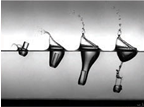
COLLISIONten (CX)
COLLISIONten (CX) (art by engineers/engineering by artists) :: Art Interactive :: Nov 17 - Dec 3, 2006, weekends 12-6pm :: Opening Thu Nov 16 6-9pm.
Curated by Jonathan Bachrach and Dan Paluska, Collision Collective artwork incorporates new technologies, concepts, and installation experiments. Featuring both MIT and regional artists, Collision X is full of innovative and provocative artworks presented in a wide range of media.
Featuring: Jonathan Bachrach, Leonardo Bonanni, Benjamin Bray, Nell Breyer, Michael Epstein, Chris Fitch, Rob Gonsalves, Vanessa Harden, Guy Hoffman, Jeevan Kalanithi, Dustin Ledbetter, Jeff Lieberman, Kevin McCormick, Roy Pardi, Hayes Raffle, John Slepian, Fran Trainor, & Bayard Wenzel.
Posted by jo at 03:41 PM | Comments (0)
Auriea Harvey & Michaël Samyn's
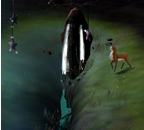
Realtime Art Manifesto
Abstract: Auriea Harvey and Michaël Samyn are new media artists who have embraced realtime 3D game technology as their artistic medium of choice. Realtime 3D is the most remarkable new creative technology since oil on canvas. It is much too important to be wasted on computer games alone. This manifesto is a call-to-arms for creative people (including, but not limited to, video game designers and fine artists) to embrace this new medium and start realizing its enormous potential. As well as a set of guidelines that express our own ideas and ideals about using the technology:
1. Realtime 3D is a medium for artistic expression 2. Be an author 3. Create a total experience 4. Embed the user in the environment 5. Reject dehumanisation: tell stories 6. Interactivity wants to be free 7. Don’t make modern art 8. Reject conceptualism 9. Embrace technology 10. Develop a punk economy.
Keywords: realtime 3d, computer games, interactive storytelling, game design, artistry, non-linearity. Realtime Art Manifesto by Auriea Harvey & Michaël Samyn. [via]
Posted by jo at 12:34 PM | Comments (0)
Otaku

Japanese Kids colonize the Realm of Information and Media
The rise of the Otaku generation is one of the most striking phenomena of contemporary Japan. In Mediamatic Volume 5, issue 3, Gabin Itoh, editor of the Japanese magazine Log In already mentioned the game Otaku, children lost to everyday life by their fanatical enthusiasm for all manner of different computer games in which they immerse themselves totally...
The few common denominators are that otaku are teens or twens, mostly boys who usually wear jeans, T-shirt and sneakers, which might not sound very characteristic but in fashion-crazy Japan it is. They despise physical contact and love media, technical communication and the realm of reproduction and simulation in general. They are enthusiastic collectors and manipulators of useless artifacts and information. They are an underground but they are not opposed to the system. They change, manipulate and subvert ready-made products but at the same time they are the apotheosis of consumerism and an ideal workforce for contemporary Japanese capitalism. They are the children of the media..." From Otaku: Japanese Kids colonize the Realm of Information and Media by Volker Grassmuck, Mediamatic.
Posted by jo at 11:59 AM | Comments (0)
Joao Ribas
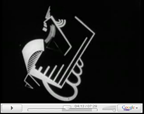
Expanded Cinema
"I've received quite a few emails asking why I haven't curated something online, particularly in terms of culling film and media, and things that are hard to incorporate into more 'conventional' exhibition formats. I've taken the suggestion seriously and decided to launch this online platform for just that, Expanded Cinema. I'll be posting some material here every few days, along with guest curators, as part of a series focused mainly on experimental film, early video, and sound-based, durational work. All of the material is being pulled from available media online elsewhere, as part of emphasizing an overlooked facet of the archival function of new media." -- Joao Ribas
Posted by jo at 11:45 AM | Comments (0)
Collecting New Media Art

Open Systems
"...Open Systems: One of the constant refrains about the promise of new media art is that it allows the viewer to become a participant and even, for many works, a producer. The artist is creating the context, the platform, the set of rules by which the "viewer" participates and produces. With a work such as Apartment (2001) by Marek Walczak and Martin Wattenberg, for example, users enter a string of words in order to create the floorplan of an associated apartment. The truth is, some users are better than others at generating results that are of interest to other viewers. How are we to judge works where the input is the user's?
For Kynaston McShine's acclaimed Information exhibition (1970), Dennis Oppenheim created a system for visitors to write a secret on a notecard and put it in a slot. In return, they received someone else's secret. After the exhibition all 2000+ of the secrets were published, without editing. One would be hard-pressed, however, to argue that the quality of this essentially conceptual work was dependent on what people wrote.
Many new media artworks are inherently performative. It is important to judge them on the basis of the performance that is possible, not on every person's rendition of Moonlight Piano Sonata (1801), so to speak..." From Collecting New Media Art: Just Like Anything Else, Only Different by Steve Dietz, NeMe.
Posted by jo at 11:00 AM | Comments (0)
NOTHING TO SEE
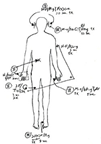
for the sense of touch
NewYorkRioTokyo e.V. :: NOTHING TO SEE: Piece touchee, No 1: a performance exclusively for the sense of touch. Being the interface: Touch is the most strictly codified sense in our society. This performance is an attempt at designing work to be perceived only through the sense of touch, beyond its usual connotations .
The piece will be performed on your body. (Duration 15 to 20 minutes). You will not be asked to be active. Please make an appointment either by email or by
phone in order to avoid waiting times: 0163-235-1869, piece.touchee[at]web.de
Performances possible every day, from 11.00 to 22.00 from Thursday November 16 to Sunday november 19, 2006.
Concept: Kenji Ouellet
Performance: Katharina Weinhuber, Kenji Ouellet
Kontrapunktus I, II: contrapuntal soundscapes (pieces for headphones)
Composition: Kenji Ouellet
Opening talk/discussion (and drinks) Thursday November 16, 19.00 (but performances possible before the discussion all day thursday).
NewYorkRioTokyo e.V.
Eberswalderstrasse 4, 10437 Berlin
www.nyrt.net
Posted by jo at 10:34 AM | Comments (0)
ARTIST in RESIDENCE [AiR] 2007
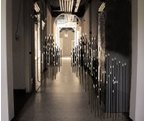
CALL FOR SUBMISSIONS
ARTIST in RESIDENCE [AiR] 2007 :: OPEN CALL FOR SUBMISSIONS :: DEADLINE: 2 JANUARY 2007 :: IN BRIEF: residency period 3 months; dates from March 2007; location Amsterdam, Netherlands.
The Netherlands Media Art Institute is pleased to announce an open call for the Spring 2007 round of its Artist in Residence (AiR) program. The AiR programme at the Netherlands Media Art Institute aims to support the exploration and development of new work in digital / interactive / network media and technology based arts practice. The residency provides time and resources to artists in a supportive environment to facilitate the creation of new work that is produced from an open source perspective. We encourage a cross disciplinary and experimental approach. This is a practice based residency designed to enable the development and completion of a new work.
Our focus for this open call is on open source interactive installation art, in which the following occurs: - interaction between tools and/or software - interaction between tools and artwork - interaction between audience and artwork.
The Netherlands Media Art Institute offers an open environment with technical assistance and an active advisory board which will give feedback and support in technical, conceptual and presentation issues. There is access to studio and exhibition equipment, technical support from the Institute’s staff and production help from interns. The technical staff is specialized and has good contacts with programmers of the following software, a.o.: PD/PDP, Blender, Dynebolic, Linux. We expect the artist to have knowledge and insight in the technical realization of the concept.
It is integral to the mission of the AiR program that artists participate in presenting their work in a public form appropriate to their project. This can include gallery installations, demonstrations of research in progress, panel discussions, on-line projects, or multimedia performances, in addition to open studio events and workshops. For this reason we ask that artists include in their proposal possible examples of how they might like to present their work publicly.
At this moment the Netherlands Media Art Institute provides in travel costs. It doesn’t provide accommodation for artists living outside of Amsterdam. However, we are willing to help the search but cannot guarantee a place for living.
Application using the application form can be send to: Netherlands Media Art Institute Artist in Residence, c/o Annet Dekker, Keizersgracht 264, 1016 EV Amsterdam, The Netherlands.
For more information about past residents and their projects, see our website at Research www.montevideo.nl
Application Form can be found on our website www.montevideo.nl // Research /// AiR
Netherlands Media Art Institute
Montevideo / Time Based Arts
Keizersgracht 264
1016 EV Amsterdam
The Netherlands
www.montevideo.nl
T +31 (0)20 6237101
F +31 (0)20 6244423
Posted by jo at 10:25 AM | Comments (0)
Regine Debatty's

Interview with Lalya Gaye
I've been writing about Lalya Gaye's work over and over again ever since i started to blog. She's one of those few people who seem to swim effortlessly in both the artistic and the purely scientific waters.
She's an engineer and PhD graduate working in multidisciplinary projects that search to explore new territories of personal expression and creativity enabled by ubiquitous computing. Her research focuses on mobile media for urban space and on computational repurposing of everyday objects. In 2002, she started working on various research projects at Future Applications Lab, Viktoria Institute in Göteborg, Sweden. But she still manages to find some time to develop smaller new media projects with friends and to get involved in the mobile music and New Interfaces for Musical Expression (NIME) communities... More >>
Posted by jo at 09:19 AM | Comments (0)
Volume Over Lumen
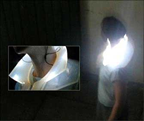
Rhythm Communicator
Volume Over Lumen is a rhythm communicator for several people. Each participant wears a silicone collar which sends a rhythmically arranged sound. A particular sound is generated for each participant according to an analysis of their voice. LEDs in the collar create a halo of pulsating light that radiates around the wearer. If another partecipant comes within the range of the collar, he or she can hear the sound generated by the collar worn by the first person. But if he or she comes within the range of several collars, then it’s a mix of the various sound compositions that will be heard.
By their own movement in the area participants can modulate their own sound experience, as well as the acoustic experience of the other collar wearers. Electronics are visibly cast in the collar: resistances, transistors, diodes, conductive strips and other elements have a functional as well as an aesthetic role. A work by Martin Bellardi and Anne-Christin Delakowitz. [blogged by Regine on TWENTY1F]
Posted by jo at 09:13 AM | Comments (0)
November 13, 2006
Discussing the Hymn of Insanity across the ocean with YouTube
Had a conversation with Marcus van Soest, a Dutch Artist, about how modern artists can collaborate, online and in real time to effect social change... [blogged by Marshall Sponder on Smart Mobs]
Posted by jo at 06:04 PM | Comments (0)
MediaCommons
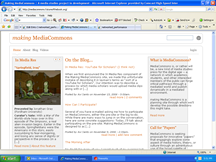
Social Networking Site
This week Ben Vershbow from the Institute for the Future of the Book passed along some news about the MediaCommons project. MediaCommons is a project in development for the past couple of years by Kathleen Fitzpatrick and others to start a born-digital scholarly press focused on media studies. At its core, MediaCommons will be a social networking site where academics, students, and other interested members of the public can write and critically converse about a mediated world, in a mediated environment. The site is intended to connect scholars, producers, lobbyists, activists, critics, fans, and consumers in a wide-ranging, critically engaged conversation that is highly visible to the public. At the same time, MediaCommons will be a full-fledged electronic press dedicated to the development of born-digital scholarship: multimedia “papers,” journals, Gamer Theory-style monographs, and many other forms yet to be invented.
The MediaCommons site launched this week has three parts:
1) A weblog where founding editors Avi Santo (Old Dominion U.) and Kathleen Fitzpatrick (Pomona College) will think out loud and work with the emerging community to develop the full MediaCommons vision.
2) A call for “papers” — scholarly projects that engagingly explore some aspect of media history, theory, or culture through an adventurous use of the broad palette of technologies provided by the digital network, to be the first projects published by the MediaCommons network.
3) “In Media Res” — an experimental feature where each week a different scholar will present a short contemporary media clip accompanied by a 100-150 word commentary, alongside which a community discussion can take place, a sort of a “YouTube” for scholars and a critically engaged public. The first guest critic is Henry Jenkins, analyzing a clip from the popular “Heroes” TV series.
Like the Electronic Literature Collection, Media Commons is an exciting and well-developed scholarly project that will make compelling new ideas available to the public in ways that they can be easily shared in the global network environment. The project is supported by the MacArthur Foundation and the Annenberg Center for Communication at USC. [blogged by Scott on Grand Text Auto]
Posted by jo at 05:51 PM | Comments (0)
Char Davies
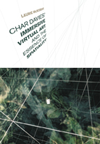
Immersive Virtual Art and the Essence of Spatiality
Char Davies' Immersive Virtual Art and the Essence of Spatiality by Laurie McRobert :: In this first book-length study of the internationally renowned Canadian artist Char Davies, Laurie McRobert examines the digital installations Osmose and Ephémère in the context of Davies’ artistic and conceptual inspirations. Davies, originally a painter, turned to technology in an effort to create the effect of osmosis between self and world. By donning a head-mounted display unit and a body vest to monitor breathing and balance, participants are immersed in 3D-virtual space where they interact with abstract images of nature while manoeuvring in an artificial spatial environment.
Char Davies’ Immersive Virtual Art and the Essence of Spatiality explores spatiality through a broad scope of disciplines, including philosophy, mythology, biology, and visual studies, in order to familiarize the reader with virtual reality art – how it differs from traditional artistic media and why immersive virtual art promises to expand our imaginative horizons. This original study provides us with an important exposition of two of Char Davies’ acclaimed projects and an exploration of the future impact of digital virtual art on our worldviews.
Laurie McRobert is an independent scholar and a former lecturer in the Department of Philosophy at McGill University and the Thomas More Institute for Adult Education.
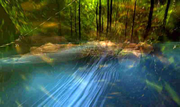
Virtual Space
"What I am trying to translate to you is more mysterious; it is entwined in the very roots of being, in the impalpable source of sensations." - J. Gasquet, Cezanne, quoted by Merleau-Ponty, 'Eye and Mind'.
I have been working in "virtual space" for nearly 10 years, and during that time have produced two major works, the virtual environments Osmose (1995) and Ephémère (1998) [1]. Integrating full body immersion, interactive 3-D digital imagery and sound, and navigation via a breathing interface, these works embody a radically alternative approach to immersive virtual space, or what is commonly known as "virtual reality" or "VR". Rather than approaching the medium as a means of escape into some disembodied techno-utopian fantasy, I see it as a means of return, i.e. of facilitating a temporary release from our habitual perceptions and culturally-biased assumptions about being in the world, to enable us, however momentarily, to perceive ourselves and the world around us freshly.
[1] Osmose (1995) and Ephémère (1998) were constructed with the dedicated participation of the following individuals: John Harrison, custom programming; Georges Mauro, graphics; Dorota Blaszczak, 3-D sonic architecture; and Rick Bidlack, sound composition.
It should be noted that when I say virtual space, I am referring to immersive virtual space, i.e. a computer-generated artificial environment that one can seemingly, with the aid of various devices, go inside. I think of virtual space as a spatiotemporal "arena" wherein mental models or abstract constructs of the world can be given virtual embodiment (visual and aural) in three dimensions and be animated through time. Most significantly, these can then be kinesthetically explored by others through full body immersion and real-time interaction, even while such constructs retain their immateriality. Immersive virtual space is thus a philosophical and a participatory medium, a unique convergence in which the immaterial is confused with the bodily-felt, and the imaginary with the strangely real. This paradox is its most singular power. The firsthand experience of being bodily immersed in its all-encompassing spatiality is key: when combined with its capacity for abstraction, temporality, and interaction, and when approached through an embodying interface, immersive virtual space becomes a very potent medium indeed.
Between 1995 and 2001, more than 20,000 people have been individually immersed in the virtual environments Osmose and Ephémère. A common response to the experience is one of astonishment: many "immersants" have described their experience in euphoric terms while others have inexplicably wept. As one participant wrote six months afterwards: '[This experience] heightened an awareness of my body as a site of consciousness and of the experience and sensation of consciousness occupying space. It's the most evocative exploration of the perception of consciousness that I have experienced since I can’t remember when.'
Such responses suggest that immersive virtual space, when approached in an unconventional way, can indeed provide a means of perceiving freshly. The medium’s paradoxical qualities may effectively be usedto redirect attention from our usual distractions and assumptions to the sensations of our own condition as briefly embodied sentient beings immersed in the flow of life through space and time." Continue reading Virtual Space by Char Davies. Published in SPACE in Science, Art and Society. François Penz, Gregory Radick and Robert Howell, eds.; Cambridge, England: Cambridge Universty Press (2004), pp. 69-104, illus.
Posted by jo at 05:33 PM | Comments (0)
Pong amb la ma
Posted by jo at 04:11 PM | Comments (0)
Saskia Sassen
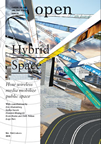
Essay and Lecture
Open 11 :: Hybrid Space: The influence of digital technologies on the use of the public domain :: Thanks to new wireless technologies (WIFI, GPS, RFID) and mobile media, public space is subject to drastic changes. It is being traversed by electronic infrastructures and networks, and alternative cultural and social domains are evolving, though often invisible from a conventional viewpoint. The traditional physical and social conditions of the public domain are being supplanted by zones, places and subcultures that transcend the local and interlink with translocal and global processes. The question is whether there are also new opportunities for the individual and for groups to act, participate and intervene publicly in this hybrid, seemingly flexible space. How do people appropriate the new public spaces? Where does the 'public' take place in this day and age? Who shapes and moulds it by devising spatial, cultural and political strategies?
With contributions by Drew Hemment, Howard Rheingold, Saskia Sassen, Frans Vogelaar/Elizabeth Sikiardi, Noortje Marres, Koen Brams/Dirk Pultau, Marion Hamm, Kristina Andersen, Ari Altena, Daniel van der Velden, Klaas Kuitenbrouwer, Esther Polak, De Geuzen and Max Bruinsma. Guest editor: Eric Kluitenberg, Jorinde Seijdel and Liesbeth Melis (eds.)
Public Interventions: The Shifting Meaning of the Urban Condition by Saskia Sassen :: De Balie, Amsterdam :: Saturday, November 18, 2006 :: Start: 20.30 hrs (CET) :: Live-stream webcast.
This year’s SKOR lecture (Fourndation for Art and Public Space) is delivered by Saskia Sassen, who will talk about the ‘making’ of public space by means of architectural and artistic interventions. The evening includes the presentation of Open 11, which takes hybrid space as its theme and includes an essay contributed by Sassen.
Human experience is threatened by the massive architecture of world cities and the density of infrastructures – digital and otherwise – that exist to serve international capital and the global economy. Sassen argues that there is a need for the production of subversive narratives as a counterbalance to this, to make the local and what has been silenced manifest and to generate new forms of ‘modest public spaces’.
Saskia Sassen is Ralph Lewis Professor of Sociology at the University of Chicago and Professor at the London School of Economics. She has gained worldwide acclaim for studies such as The Global City and Cities in a World Economy. Her most recent publication is Territory, Authority, Rights: From Medieval to Global Assemblages (Princeton University Press, 2006).
Panelists: Arnold Reijndorp, urban sociologist; Willem van Weelden, artist and theorist; Moderator: Bahram Sadeghi
Language: English
Organised by: SKOR / Open / De Balie
SKOR is the Netherlands Foundation for Art and Public Space.
Open, a cahier about art and the public domain, is published twice a year by NAi Publishers in association with skor.
ADDRESS: De Balie, Kleine Gartmanplantsoen 10, Amsterdam.
RESERVATIONS: De Balie t 020-5535100, or via >>
Admission: 12,50 (students: 7,50)
Posted by jo at 02:24 PM | Comments (0)
String Beings
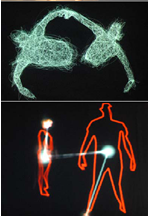
Manipulating and Manipulated
String Beings is the result of an exciting collaboration between Snappy Dance Theater, Jonathan Bachrach, Lucia Lin and Berlin composer Michael Rodach exploring the subject of manipulation through the interaction of multiple media. “String Beings” explores the relationship between manipulating and being manipulated, using a variety of metaphors ranging from the literal (individuals playing string instruments, individuals being pulled by strings) to the complex (dancers manipulating musicians, dancers manipulating images created through their interaction with technology, technology manipulating the audience by transforming reality into a “new” and projected reality). Snappy's physical style and artistic approach of using irony as an essential tool of expression even for complex or sometimes serious topics blends well with Jonathan Bachrach's ability to turn a profoundly human dance expression into a paralles univers of doubt, deception and surprise.
“String Beings” will be a compilation of several sections that alternate interactions between musicians and dancers, dancers and technology, and all three elements. The musicians will be part of the choreography to such an extent that at one point, Lucia Lin will be integrated into the acrobatic movement while playing the violin. Berlin composer Michael Rodach created the 60-minute sound score for The Temperamental Wobble in 2004 and will compose “String Beings” to be a mix of electronic music with live strings.
At the Cambridge Multicultural Arts Center :: November 17th & 18th at 8:00 pm :: 41 Second Street, Cambridge, MA :: Tickets.
Approximate Length: 40 minutes (one half program)
6 dancers, 3 musicians (2 recruited locally), 1 computer artist
Choreography: Martha Mason/Snappy Dance Theater
New Media Artist: Jonathan Bachrach
Violin: Lucia Lin
Set Design: Chris Fitch
Lighting Design: Joseph Levendusky
Music: Michael Rodach
Founded in 1997, Snappy Dance Theater is led by Co-Founder and Artistic Director Martha Mason. "Snappy" has grown to become the most active contemporary dance company in Massachusetts, and has the 12th largest audience of all performing arts organization in the Boston area. Snappy has been presented in 18 U.S. states and 4 international countries; has received critical acclaim in major publications (The New York Times and Dance Magazine); and has received major commissions including Bank of America CelebritySeries commission of The Temperamental Wobble in 2004,
presented at the Cutler Majestic Theater. Snappy's mission is inspire audiences and to make dance and theater more accessible to people of all ages and backgrounds.
Jonathan Bachrach, Ph.D. is an artist and research scientist at the MIT Computer Science and Artificial Intelligence Lab. He researches robotics, sensor networks, programming languages, and new art making platforms. Bachrach's artwork has been shown at the MIT Media Lab, Dance Theatre Workshop (NY), Eyebeam Gallery (NY), at several Boston galleries, and at Festival du Nouvelle Cinema in Montreal. In collaboration with Dan Paluska and Brian Knep, Bachrach leads the Collision Collective and curates exhibitions of art technology with MIT and Boston-based artists.
Lucia Lin has been a prizewinner of numerous competitions, including the 1990 International Tchaikovsky Competition in Moscow. She has performed in solo recitals throughout the U.S., making her New York debut at Weill Recital Hall in 1991, and has appeared with the Boston Symphony Orchestra, Boston Pops Orchestra, St. Louis Symphony Orchestra, Oklahoma Symphony, Cincinnati Chamber Orchestra and Festivalorchester in Graz, Austria. Lin is a member of the Muir String Quartet, and a founding member of the Boston Trio and the chamber group, Innuendo.
Posted by jo at 02:03 PM | Comments (0)
WIS
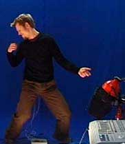
The Wearable Instrument Shirt
Scientists at the CSIRO's Textile and Fibre Technology division in Australia have woven electronic sensors into a T-shirt (the WIS - the Wearable Instrument Shirt) so that it can be played liked a real guitar. Movements by the wearer's arms are mapped and beamed by radio to a computer which interprets them and turns them into musical notes.
"The left arm chooses a note and the right arm plays it," said Richard Helmer, at CSIRO. The arrangement can be reversed for left-handed musicians. "You can play with yours hands above your head," added Dr Helmer. "You can turn around and jump. Whatever you like."
Video of the shirt + tambourine and guiro versions of the shirt. Via SMH. Similar but with added orange gloves: The Virtual Air Guitar. Also Facial Control for Electric Guitar; GuitarBot, a self-playing guitar; Bangarama to play guitar just by banging your head up and down. [blogged by Regine on we-make-money-not-art]
Posted by jo at 10:11 AM | Comments (0)
November 10, 2006
Celebrate our 10th Anniversary
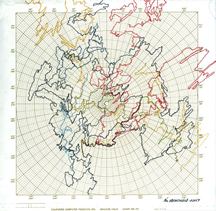
Support Turbulence
It’s not too early to start your holiday shopping! And you can support Turbulence’s networked_performance blog at the same time! WE CANNOT CONTINUE TO PROVIDE THIS SERVICE WITHOUT YOUR HELP. Please go to our website and make a donation today. Choose from artists’ books, drawings, DVDs, CDs, archival prints, T-Shirts and more by Annie Abrahams, Kate Armstrong, Diane Bertolo, Andy Deck, Onomé Ekeh, Jason Freeman, Tal Halpern, Peter Horvath, David Jhave Johnston, kanarinka, Brooke A. Knight, Steven Lam, Patrick Lichty, Michael Takeo Magruder, Michael Mandiberg, microRevolt, Mouchette, MTAA, Andrea Polli, Preemptive Media, Gustavo Romano, Yoshi Sodeoka, Nathaniel Stern, Helen Thorington, and Jody Zellen. Or simply make a donation.
Turbulence is celebrating its first DECADE, the only program to consistently commission net art for ten consecutive years. Despite the expansion of our projects, the acceleration of our support for artists, and the valuable resources we provide in our networked_performance blog and New American Radio archive, we have seen a decline in our operating support. Please help us to continue to support emerging artists and technologies, and preserve our valuable archives. THANK YOU.
Posted by jo at 06:38 PM | Comments (0)
Interface and Society
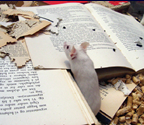
AbA Logic + Superconsumer
AbA Logic by Art by Accident (Kalle Grude, Jan Løchstøer) :: Six Muses of Randomness: Six white mice reside among books on logic subjects inside a laboratory cabinet. What are they doing there? Well, obviously they are nibbling on the books. Apparently they are nesting, as in quiet moments they cuddle up in a ball beneath snippets of logic. As they wander among the books they trigger a databank of words connected to electronic boards. The boards make up two sentences of three words each (so-called AbA-logic statements). Each time a mouse triggers a sensor, a new statement appears. The words (adjectives, adverbs and nouns) are common in logic terminology. The statements that appear are less common. This is why they are of interest to us.
In order to materialize this constant stream of statements, they are printed as they appear. On AbA’s desk piles of sketches and notes from the process accumulates. In addition to participate in a digital process, the mice -through their nibbling- are creating sculptural rephrasing of the books, and produce new combinations of the texts and illustrations from the pages of the books.
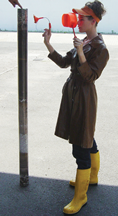
Superconsumer by Franz Alken and Karl Rueskaefer :: What happens when a computer programme starts buying and selling stuff on Internet auctions like ebay autonomously? That is the key question of superconsumers. The stuff the Bot has bought is exhibited for a short time. Thus digital values are translated into tangible goods. And vice versa, since the Bot sells them again after a while to buy new ones. In this way, commonplace products are temporarily translated into works of art.
The basic principle of superconsumers, is to make an amount of money available to a software (a so called “bot”). The software uses this money to buy goods autonomously at the online-auction-platform ebay, transfers these goods to an art-space, exhibits them and sells them again via ebay. The exhibition-module consists of a computer-interface displaying the softwares actions at ebay, 7 pedestals that show the current goods and a watchmann who executes the software’s instructions and arranges the goods on the pedestals. There are mainly 4 points that form a fascintation for this project: The relationship between humans and machines - the bot replaces exemplarily the role of humans in the ebay environment.
The ready-made principle: While transferring ordinary objects from the mass-market to an art space, the bot enhances the objects to pieces of art. This enhancement is temporarily, the bot takes away the “art aura” by selling these pieces again via ebay.
The installation gives a constantly updated overview on the mass-market. The programming of the process makes the items the bot will buy unpredictable - a search on the topic “football” can respond items like fan-articles, computer games, books or sportswear. Interaction is an important point on art-projects dealing with the internet. The interaction at superconsumers is quite hidden: Everyone dealing with the bot at ebay is arranging the exhibition without knowing it.
More about Interface and Society [PDF]
Posted by jo at 04:57 PM | Comments (0)
Toriton Plus:
Water Surface as Music Controller II
A slightly more complex version of using a water surface as a music controller featuring five lasers instead of just the one. Please note that this is a prototype version, and as such does not represent the variety of output for the finished thing.
Posted by jo at 04:38 PM | Comments (0)
Henry Jenkins

Taking the You Out of YouTube?
"We have all seen major media companies telling us that file-sharing is bad because it takes other people's intellectual property without just compensation. So, why are these same companies now taking their audience's intellectual property for free?" --Henry Jenkins
YouTube, along with Second Life, Flickr, Wikipedia, and MySpace, has emerged as one of the key reference points in contemporary digital culture -- emblematic of the move towards what people are calling web 2.0. As Newsweek aptly put it last year, web 2.0 is "putting the we into the web."
Elsewhere, I have argued that web 2.0 is fan culture writ large, fan culture without the stigma. Nobody is telling these guys to move out of their parent's basement -- though some of them have started multimillion dollar companies out of their parent's basements. What separates these companies from the dotcoms which fueled web 1.0 is the emphasis upon participation, social networking, collective intelligence, call it what you want. What distinguishes them is that their content arises bottom up from the community of users.
One by one, these insurgent companies are being absorbed into the surviving digital giants (as has happened through Yahoo's purchase of Flickr or more recently, Google's purchase of YouTube) or by old media companies (as in Rupert Murdock's takeover of MySpace). With each new buyout, there is renewed speculation about what happens to the "we" --what becomes of the communities that made these activities and services so attractive in the first place.
Today, I wanted to share two really interesting responses to the buyout of YouTube and what they might mean for the future of participatory culture. Continue reading Taking the You Out of YouTube? by Henry Jenkins.
Posted by jo at 04:30 PM | Comments (0)
RootsCampSL
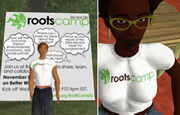
LAYING DOWN ROOTS
[image: Frobozz and Glitter] Netroots move into the metaverse. Inspired by BarCamp, the ad-hoc open conference system, RootsCamp merges that format with Net-driven political activism with a left-of-center bent. Perfectly timed to launch in the wake of the mid-term elections, the group will hold regular events in Second Life every day for the next week, starting tomorrow at 1pm SLT. Unsurprisingly, they'll start with a de-brief on the elections which just brought the Democrats back in control of Congress.
It's another example of metaverse-based political activism, following a path laid by Governor Mark Warner, and others before him. "RootsCampSL is an effort to allow people that can't make it to a physical offline RootsCamp," co-host Drew Frobozz explains, "to still be able to participate in one, and also to get the progressive Netroots up to speed with Second Life-- which we believe will be an important political organizing platform for the 2008 election." I've previously speculated on Second Life's potential to become a virtual meet-up platform, but given the real life activist background of Drew Frobozz (here) and his co-organizer Ruby Glitter (here), I'm inclined to take that statement far more seriously, coming from them.
RootsCampSL main page is here, Thursday's 1pm event listing is here. [blogged by W. James Au on New World Notes]
Posted by jo at 04:20 PM | Comments (0)
BrainWaves

Musical Performance by Cortical Cells
BrainWaves is a musical performance by cultured cortical cells interfacing with multielectrode arrays. Eight electrodes recorded neural patterns that were filtered to eight speakers after being sonified by robotic and human interpretation. Sound patterns followed neural spikes and waveforms, and also extended to video, with live visualizations of the music and neural patterns in front of a mesmerized audience. See a two minute video here (still image below). Teams from two research labs designed and engineered the project; read more from collaborator Gil Weinberg.

The Potter Group of the Laboratory for Neuro-Engineering at the Georgia Institute of Technology conducts research with cultured neuro-electrical interfaces, using recording and stimulation techniques. BrainWaves is one creative expression of this work, another is the MEART Animat, or hybrot, that creates paintings with robotic arms. The Animat used rat neurons; mouse neurons for BrainWaves, and simple fish neurons in Fish and Chips (a predecessor of BrainWaves). Organic and digital meshed.
BrainWaves invokes aesthetics of sound patterns with neural patterns. MEART "the semi-living artist" is abstract in its output. What do these expressions mean? Their beauty lies in science, in the synchronized creative outlets in live, improvised performances with digital and audience interfaces generating compositions in reaction to neural activity. Then putting them online. Two, including BrainWaves, were documented in Interactive Sonification of Neural Activity, Weinberg & Thatcher, from Proceedings of the 2006 International Conference on New Interfaces for Musical Expression. (PDF)
Potter recently published on plasticity in neuronal cultures, and earlier in the year co-authored An extremely rich repertoire of bursting patterns during the development of cortical cultures. Wagenaar, Pine, Potter; BMC Neurosci. 2006 Feb 7;7:11 (free full text).
The paper includes an open invitation. "Indeed, the range of behaviors of these cultures is so rich that this paper can only begin to describe the diverse activity patterns present in these recordings. Therefore, we invite others to join us in the study of activity patterns of networks of cortical cells in vitro. To this end, we have made the entire dataset used for this paper available on the web [email Potter for access]. Researchers may download our recordings of spike waveforms."
Imagine what sci-art expressions could develop in the research and infoviz from that. [posted by Sandra on Neurofuture] [via]
Posted by jo at 04:09 PM | Comments (0)
OKNO PUBLIC02:
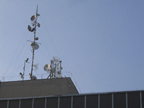
A CONTEMPORARY LOOK AT RADIO ART
OKNO PUBLIC02: A CONTEMPORARY LOOK AT RADIO ART :: 13-18 NOVEMBER 2006 :: OKNO invites you to Public02. In a process of workshops, 2-way radioworks, collaborative and networked sound installations, live broadcasts of radio-art programs, lectures and performances, OKNO offers the broad public a chance to take part in the debate. All events can be attended onsite and online. Check okno's homepage for updated stream-information.
Theoretical and hands-on workshop 'mini FM transmitters' (Tetsuo Kogawa, Jp) :: 13/11 - 1pm: Tetsuo Kogawa covers following topics in an online lecture: - a short history of Mini FM - Mini FM and radio art - the still unknown meaning of micro transmission and why it is relevant today. Following the lecture, Tetsuo Kogawa will give a hands-on introduction on how to build a mini FM transmitter.
Workshop @ okno: monday 13/11 - thursday 16/11 :: Online lecture: monday 13/11, streaming starts at 1pm :: More info: http://www.okno.be/index.php?id=972 :: Stream on http://qt.okno.be:8000/FMtransmitters.sdp or on okno's homepage.
Transversal Transmission -- Tetsuo Kogawa (Jp) and Jacques Foschia (B) :: 15/11 - 7.30pm: A streaming and networked feedback performance between Jacques Foschia (onsite in Brussels) and Tetsuo Kogawa (remote in Tokyo), an hommage to the micropolitics of Felix Guattari.
wednesday 15/11 - 7.30pm
more info: http://www.okno.be/index.php?id=979
stream on http://qt.okno.be:8000/TransversalTransmission.sdp or on okno's homepage.
public live broadcast -- Martiens go home! (B) :: 16/11 -- 8.30 pm: A public live broadcast from the duo of the notorious radio show on Radio Campus (Bxl). With the live sequencing of found sounds and various samples, MartiensGoHome develops its own approach to electronic music. Far from any rigid and binary compositions, their sound is organic and complex.
thursday 16/11 - 8.30pm
more info: http://www.okno.be/index.php?id=978
stream on http://qt.okno.be:8000/MartiensGoHome.sdp or on okno's homepage.
Stockhausen's use and interpretation of shortwave broadcasting - lecture + documentary :: 7/11 - 8pm:In the sixties (during what probably was the most metaphysical phase in his career) Stockhausen used shortwave radio as a source of musical information. The lecture on Stockhausens' interpretation of these broadcasts, given by Guy de Bivre (B/ composer, musician, and theoretic on sound art) will be followed by a projection of the documentary "Kurzwellen", a registration by the ORTF/Luc Ferrari of Stockhausen's performance in the Lebanese Caves of Jeita, November 1969.
friday 17/11 - 8pm
more info: http://www.okno.be/index.php?id=984
stream on http://qt.okno.be:8000/Stockhausen.sdp or on okno's homepage.
Shift coordinate points -- Esther Venrooy (B/Nl) :: 17/11 -- 9.30 pm: The UK label Indrial-Discs invited Dutch composer Esther Venrooy to rework the material of The Conet Project, a collection of spyradio registrations. The result is a live radio art / poetry performance, a mix of electronically generated noise, deconstructed speech patterns and coded shortwave broadcasts recordings.
friday 17/11 - 9.30pm
more info: http://www.okno.be/index.php?id=980
stream on http://qt.okno.be:8000/ShiftPoints.sdp or on okno's homepage.
Transgressing the boundaries of everyday-life: considering radio as an apparatus of distribution - lecture performance by Ligna Collective (D) :: 18/11 -- 8.30 pm :: Nowadays radio seems to be an old-fashioned modern medium and the hope Brecht had is now projected - again often enough merely in a technical sense - on the internet and open source approaches. LIGNA proposes with its work a different perspective: We have to get rid of the technical reading of Brecht and recognise that his critique was meant in a social and political way. Only as an apparatus of distribution, radio could organise it's listeners and thus intervene in everyday-life situations - and thus could provide means to overcome a society that is based on the exchange of commodities. The lecture will discuss this thesis and it's aesthetical implications with a lot of examples and images of Ligna's work.
saturday 18/11 - 8.30pm
more info: http://www.okno.be/index.php?id=977
stream on http://qt.okno.be:8000/Ligna.sdp or on okno's homepage.
[RT- 32] Acoustic Space Lab - a project by RIXC media lab (Lv) screenings on wednesday, thursday and saturday after the live performances: The RT-32: Acoustic Space Lab is a multi media exploration of the VIRAC radio telescope, a 32 m dish antenna in Irbene, Latvia. From the history of this top-secret Soviet era military object, including precise technical data and its conversion to scientific and civilian use, to the international Acoustic Space Lab-symposium on sound art using radio and satellite technology, with the participation of thirty artists, radio amateurs and community radio activists from all over the world.
wednesday/thursday/saturday - 10pm onwards
more info: http://www.rixc.lv and http://www.rixc.lv/solar/
location: OKNO -- Koolmijnenkaai 30/34 -- 1080 Brussels -- Belgium
entrance: free
dates: monday 13/11 -> saturday 18/11
public transport: metro Graaf van Vlaanderen/Comte de Flandre -- Tram18
With the kind support of the Flemisch authorities and the VGC (Vlaamse Gemeenschapscommissie). A collaboration with the RITS radio-department.
Posted by jo at 03:25 PM | Comments (0)
Onliness v1.0.1
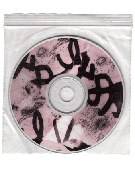
Open Source Music
When one speaks of 'open source culture,' they are typically referring to the social conditions created in an atmosphere of sharing. Open source software is not only freely available, its source code is also revealed to encourage collective authorship, improvement, and personalization. The increasing popularity of such publishing contexts has led to a broader movement of activists, coders, lawyers, artists, and others questioning contemporary copyright law, and challenging the 'code' that prohibits collaboration. American sound artist Demon Doctor carries these concerns over into his work, equating music with language and sounds with letters, ultimately asking 'who owns the alphabet.' For his new album, 'Onliness v1.0.1,' the artist sampled public archives of ethnographic recordings, found phonography, and film scores, and reprocessed them using analog and digital synthesizers to create twenty-one new brick-hop and trancehall tracks. 'Onliness' premieres at Boston's Samson Projects on Saturday, November 11th, where Demon Doctor will collaborate with DJ Spase1, in a series of live interpretive mashups, carrying the open source ideal into a performative realm. Needless to say, the entire album is freely downloadable, so readers can remix the tracks for themselves. - Marisa Olson, Rhizome News.
Posted by jo at 10:51 AM | Comments (0)
Steal This Film:
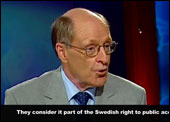
BitTorrent Culture Sharing Documentary
According to Armin Medosch, in an interconnected environment, individuality or expression are neither important. What's important are the new forms of sharing, spreading and planning the digital work. With collective actions this cultural domain progresses in its entirety, because sharing and collaborating mean learning from each other. This is the spirit that inspired Steal This Film, a documentary series that depict and promote the movement against the intellectual property activities. The authors, The League of Noble Peers, define themselves as a group of friends that wanted to make a film about the file sharing movement highlighting activists and artists ideas about the future of creativity.
The first part of Steal This Film, the only one yet completed and available for downloading, tells the story of The Pirate Bay, one of the biggest BitTorrent trackers server, and of the Swedish organization Pyratbyræn, chronicling with protagonists' interviews what happened when the Swedish police seized the servers in May 2006. In some countries distributing torrents tracking unlicensed copies of copyrighted material is illegal.
In Sweden, a nation with a strong democratic tradition (allemannsretten), downloading material for personal use wasn't considered illegal until July 2005 when the government, according to many forced by USA, outlawed the copying, distribution, uploading and downloading of copyright material. However, even if the police raid, justified by law, was aimed to inhibit the pirates' activities, the result was the opposite: the accesses to The Pirate Bay doubled and the number of downloadings increased, thanks to the sudden media exposure. Furthermore a political party, The Pirate Party, was founded, with the general consent of young electors, who don't want to lose such a content source. Steal This Film it's a DIY video that tells this story in half an hour, certainly including some naivety such as subliminal messages like 'Resist Share Copy' or 'Sharing is not Stealing', or the apologetic attitude towards the guerrilla. However the artwork 'metadata' nature, a BitTorrent file that encodes data about sharing, as well as the effort of documenting facts and opinions on the copyright debate are worth the download." -- Valentina Culatti, Neural.
Posted by jo at 10:42 AM | Comments (0)
In the Chair
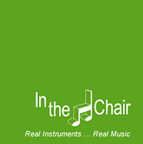
Web 2.0 Replaces Music Teachers
"SAN FRANCISCO -- In the cacophony of mashups, widgets and collaboration tools demoed at the third annual Web 2.0 Summit here, one rang out as the biggest crowd pleaser: a musical instrument instruction web app with a golden ear and infinite patience.
Called In the Chair, the application encourages music students and budding guitar heroes to play along with real musicians by syncing scrolling sheet music with a prerecorded video of a band playing the song. The app monitors your playing through your computer's microphone, and gives you instant feedback on whether you played the right note with the right timing.
In the Chair CEO David Evans observed correctly that the application turns music practice into something closer to a video game. He also announced a new web component that lets composers and teachers alter, remix or collaborate on each other's uploaded sheet music..." Continue reading Web 2.0 Replaces Music Teachers by Michael Calore, Wired.
Posted by jo at 09:06 AM | Comments (0)
November 09, 2006
Ricardo Miranda Zúñiga
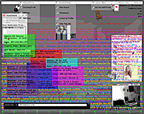
net.art as on-line activism
"Introduction: Over the last ten years, the Internet has embedded itself in the daily lives of a vast number of people. As a new telecommunication technology, it allows the common individual to engage in a cybernetic system that is globally networked. Today, however, a race goes on to establish the social dynamics of the Internet as a public arena. Will cyberspace become a highly monitored and regionalized control space or will the Internet retain its radical potential for independent endeavors and ideological exchange? The political implications of the Internet as a social network present rich issues for creative and critical cultural production.
The nature of the Internet as a network of connected computers to exchange information engenders a sense of liberty and freedom in the individual. Early in its development, mainframe teams established host-to-host protocols such as Telnet and File Transfer Protocol (FTP) that decentralized computer networking between independent users from the main frame.1 As the network grew it evolved into a new, democratic public sphere of communication via a globally expansive routing system and a vast array of on-line applications, amongst them electronic mail, and the world wide web.2 The individual was able to interface with an enlarged public, and a new dialogical space emerged.
Given the numerous forms of exchange possible via the Internet, on-line activity parallels Nancy Faser’s re-articulation of Jürgen Habermas’s public sphere as put forth in his 1962 book, The Structural Transformation of the Public Sphere. Habermas presents the public sphere as a bourgeois arena for exchange where citizens may discuss common affairs, a model based in the old town hall. In the essay, “Rethinking the Public Sphere” (1993), Nancy Fraser updates and expands the Habermasian public sphere beyond institutionalized public forums to include the market place and the domestic space (specifically in relation to domestic violence). Whereas, Habermas places market relations and domestic issues within the private sector, Fraser argues that, in doing so, these arenas of human interaction are restricted from “legitimate public contestation.”3 Fraser’s re-articulation expands the public sphere beyond the bourgeois domain to a space that is “open and accessible to all.” As the Internet becomes increasingly commonplace and interweaves itself into general daily life in such forms as list serves, chat rooms, gaming communities, a host of multi-user domains it springs to life a multiplicity of publics by Fraser’s definition.
Each public sphere is part of a civil domain that is governed by a set of laws and policies. Therefore, just as any civil, public space, the Internet must have its own set of policies that mirror those of our physical space. Amongst the on-line policies and regulations currently being established are decisions pertaining to appropriate policing and monitoring of cyber space, and determining the boundaries of privacy in a networked society.
The very nature of the Internet presents a highly efficient means of surveillance, as a networked electronic system that interfaces logical indexing machines, the computer. The ability to digitize nearly all types of records in conjunction with the computer’s indexing and networking efficiency has established the database as the most advanced archival utility.
Use of such emergent technologies has been a long time goal by policing authorities. In the essay “The Body and the Archive,” Allan Sekula traces in detail the use of photography to document, categorize and archive the human body by early criminology. As the body became a subject of the archive through photography, the fundamental problem of volume became apparent: “The early promise of photography had faded in the face of a massive and chaotic archive of images.” The electronic database’s vast storage capabilities solves the problem of volume. Hence, the photograph once used to document the body and help establish identity is replaced by data. And as various types of data such as our home address, our shopping patterns, our level of institutionalized education, our employment and income, for example, are monitored and stored data becomes a basis of identity. The electronic network used to transfer data becomes a tool of investigation due to its potential for surveillance. The questions then arises: how far will police, federal and even corporate monitoring of the electronic sphere extend? How will we ever know its parameters? Is it a matter of trust or open systems or regulatory institutions? Where and how will the lines of personal and civil rights be drawn in a networked society?
The questions surrounding on-line privacy are complex and encompass a wide number of issues such as ownership, which in itself introduces a chain of other questions. It is impossible to present an answer to these involved questions as they will continue to arise. However, I do contend that unless non-governing independent groups protect the Internet as a space for independent production, dissemination and open discourse, the radical potential of the Internet will be consumed, largely through its very nature. Therefore, if there exists today an artist avant-garde, looking to merge art with daily social life, it is the growing number of socially active artist engaged in cyber resistance as a critical practice in which the network and the database represent tools for engagement.
I will present two primary forms of resistance as executed through two artist projects. First, TO INFORM: Brooke Singer exposes her own electronic data to enlighten a general public of one’s freely available data. Second, TO SUBVERT: iSEE, a collaborative project between the Institute for Applied Autonomy and the Surveillance Camera Players makes use of the database structure to subvert the monitoring of the public sphere." Continue reading The Work of Artists in a Databased Society: net.art as on-line activism by Ricardo Miranda Zúñiga, NeMe.
Posted by jo at 04:00 PM | Comments (0)
Walter Ruttmann
Lichtspiel Opus I
With a background as a painter, and cellist/violinist, Walter Ruttmann found his way to making experimental abstract animations in the 1920s, and later, feature length documentary films.
Ruttmann was in a milieu of painters, poets and musicians who saw in the new media a possibility to expand the limits of the fine arts. They described their abstract films as visual music, seeking to achieve a similar experience in the visual as in music. The overall idea of their works was also linked to the concept of the absolute film; the idea of a universal language of abstract images.
Ruttmann's most well-known film is Berlin-Symphony of a Great City, which utilized the Kino-Eye or Cinematic-Eye technique of Dziga Vertov. This is documentary filmmaking at its most poetic and expressive. His later World Melodies expanded on the synthesis of the visual and the musical with scenes taken from all over the world.
During the late 1930s Ruttmann delved deeper into documentary filmmaking, which likely led to his work on various propaganda films. As Germany moved towards World War II, Ruttmann worked with Leni Riefenstahl in the writing of the famous Nazi propaganda film Triumph of the Will(1934), and later the editing of Olympia (1938). Whether or not Ruttmann would have suffered the same lapse in reputation that Riefenstahl did after the war will never be known, as he was killed on the war front making a newsreel just three short years later.
Weekend (1930) 11'10": Weekend is a pioneering work from the early days of radio, commissioned in 1928 by Berlin Radio Hour. In a collage of words, music fragments and sounds, the film-maker and media artist Walter Ruttmann presented on 13 June 1930 a radically innovative radio piece: an acoustic picture of a Berlin weekend urban landscape.
Posted by jo at 03:42 PM | Comments (0)
Mediamatic Salon
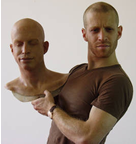
Nir Nadler and Chris O'Shea
Mediamatic Salon :: Monday, November 13 at 20.30 hrs :: Presentations by Nir Nadler and Chris O'Shea, and the results of the Machinima Contest 2006 :: Location: Bar-Restaurant 11, Post CS Gebouw, Oosterdokskade 5, Amsterdam.
Chris O'Shea (London) constructs models of interaction that borrow from TOY design and video GAMES, to create play situations within virtual environments and in tangible devices. He will present a series of projects that begin to explore synaesthesia, the fusion of sound and visuals, through gaming devices, open source processes and interactive soundscapes.
Klaas Kuitenbrouwer shows the QUIRKIEST results of the Machinima Competition that mediamatic organised with VIRMA and the Holland Animation Film Festival. Contestants had to make a machinima about a recent news event in one week only. In his presentation Klaas explores what it is that makes machinima interesting.
Nir Nadler and Chaja Hertog portray prototypes of cultural identities and ICONIC figures through variable mediums. Some of these identities are applied onto a self-published newspaper: The Monograph, where the personality Norbert Nadler plays a central role. It is a man without character that uses all means to approach everyone. Norbert travels through the imaginary world like a CHAMELEON taking on every identity he desires, he exists only because of the media and coincided with it.
Posted by jo at 02:18 PM | Comments (0)
Center for Advanced Visual Studies
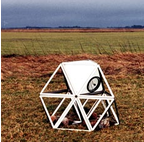
N55
The Center for Advanced Visual Studies presents N55 :: Monday November 13th, 7:00 pm :: MIT’s School of Architecture and Planning,
265 Massachusetts Ave, 3rd Floor, Cambridge, MA 02139 :: 617 253 4415
N55 is a Danish artists' group which designs and builds humorous but functional tools meant for a utopian way of life. Their vision of a democratically organized collaborating body of self-reliant individuals is described in their writing and embodied in their designs. Most of their writing takes the form of manuals: From their website you can learn how to build a "MICRODWELLING" or "SMALL FISH FARM," or how to create situations and relationships with "ROOM," "WORK," and "KOMMUNE." With their simply titled works, N55 engage a number of fields: "LAND" deals with land ownership by providing an alternative scheme of publicly held sites while "SHOP" provides an alternative to money by proposing a system of bartering "shops" that anybody can set up anywhere.
N55 do not claim that their manuals and designs solve pressing social and economic problems. But they believe that the very act of setting to work can empower a person and help change the way he or she sees the world.
N55 was invited to the Center by the Interrogative Design Group (head: Krzysztof Wodiczko).
N55 is based both in Copenhagen, and in LAND. The group grew out of an initial collaboration in 1996, when a number of persons started living together in an apartment located in the center of Copenhagen, trying to “rebuild the city from within” and use their everyday life situation as a platform for public events and collaborations. While their work exists primarily in the sphere of the public and everyday, the group has exhibited widely internationally in venues including the Venice Biennale; the Castello di Rivoli, Turin; Tramway Arts Centre, Glasgow; the New Museum, New York; MassMOCA, North Adams, MA; the Camden Arts Centre, London; the Royal College of Art, London; and more.
LAND is constructed from pieces of land in different places in the world. The various parts are added to LAND by persons who guarantee that anybody can stay in LAND and use it. Any person can initiate expansions of LAND. The geographical positions of LAND are updated continuously and can be found online.
The Center for Advanced Visual Studies is a fellowship program that commissions and produces new artworks within the context of MIT. The Center facilitates exchange between internationally known and emerging contemporary artists and MIT's faculty, students, and staff through public programs, support for long-term art projects, and residencies for MIT students.
Posted by jo at 02:09 PM | Comments (0)
Upgrade! Lisbon
![]()
BLINDSPOT
Upgrade! Lisbon :: November 16, 2006, 19:00 :: Blindspot by Herwig Turk, Paulo Pereira and Günter Stöger :: 19:00 @ Lisboa20 Arte Contemporânea Rua Tenente Ferreira Durão 18B (Campo de Ourique).
Blindspot is an interdisciplinary research project about perception, developed by Herwig Turk, Dr. Paulo Pereira and Günter Stöger in cooperation with Beatriz Cantinho, Bärbel Buck, Patrícia Almeida, and Dr. Miguel Castelo Branco. The project aims at investigating perception in a broader context as well as its circumstances, its determinants and its contingencies. The proceedings in the research laboratories in vision sciences are translated into different settings, thereby creating a meta-language that crosses traditional boundaries between science and art. At the same time, a new heterotopic space for experimentation is created where objects, gestures and language separated from their supporting context gain new dimensions. The approach used by the authors adopts the formal structure of a research project, starting with the hypothesis that Science represents an imperfect means whereby perception is used as a privileged means o assess reality (“an improved means to an unimproved end”, Thoreau).
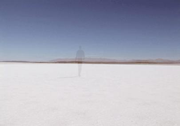
The overall approach of Blindspot is based on a long-term interchange of knowledge methods and proceedings of sciences and arts. “Perception is the process whereby sensory stimulation is translated into organized experience”, Encyclopaedia Britannica). Vision sciences tend to focus on the process of sensory stimulation: from the eye to the brain or from the photon to the image. The anatomical, physiological, neurological and biochemical research can convey the means to gather a great amount of information that agglomerates in large volumes and treaties. However precise, a vast amount of information is neglected or is actively translocated to a place outside of the laboratory by the application of the scientific methods and procedures. What remains, are contaminations from the “outside world” and are largely the subject-matter of this interdisciplinary project. Within the project perception is defined as a proposition that includes the “organized experience” within and among various human and non-human elements. These elements connect and communicate through incidents and create a reality that can only be understood in a very limited timeframe.
The method used by the research team relies on a strong interaction and interference between the organic elements and the instances that contextualize the received information. One cannot say where the Organ ends and the processing starts! (Oswald Wiener).
These interactions are highly variable and strongly depend on individual dispositions and environmental factors . Thus, a “real world” exists just as a helpful construction to interpret ephemeral individual perceptions.
Individual perception cannot be observed or interpreted as isolated, but rather as something that is distributed within group structures (persons, objects, environments). Each individual perceives himself and his daily environment through the reflections and reactions of others. Every single person is connected to a floating system of information and a clear line cannot be draw to separate individuals from others nor from their own surroundings.
Science aims at a universal language supported by inertia referential. The scientific language is highly coded and the associations between words, concepts and the corresponding entities in the “real world” are often blurred by the complex system of references used. The scientific systems of references include necessarily established conventions comparable to GMT (Greenwich mean time) or the null meridian, in an attempt to identify standards that make measurements possible and universal.
A main goal in this project is to identify calibration standards and reference points that are critical in influencing individual perception. Once such points of reference are identified they can be easily manipulated by deconstructing its own fundaments and by displacing them into a different context/setting. This approach questions the fallibility of the scientific conventions and highlights the importance and contribution of social and individual constructions (constellations) to what is perceived as a scientific through or a scientific fact. More importantly, the founding elements and corner stones of the scientific method are man-made and became less abstract as the project emphasizes and brings to center-stage those structural elements that are both invisible and – thought of as - infallible in daily scientific routines.
This goal can be accomplished by a variety of procedures, including the dislocation of both observer and object of observation to different scenarios where common references are no longer obvious and where the elements that support perception are often absent. Experimentally, this approach creates the field where different categories of knowledge meet and reveals the interdisciplinary nature of the project.
Posted by jo at 01:37 PM | Comments (0)
November 08, 2006
GypsyMIDI
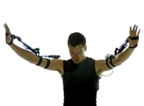
Body as Musical Instrument
The Gypsy MIDI controller turns the human body into a musical instrument, gizmag, January 26, 2006.
Dance and music go together. Intuitively, we know they have common elements, and while we cannot even begin to understand what they are or how they so perfectly complement one another, it is clear that they are both are an expression of something deep and fundamental within all human beings. Both express things that words cannot – beyond intellect, they are perhaps two of the fundamental building blocks of human expression, common to the souls of all people. Which is why when we saw this machine which links the two, we knew there was something special brewing. The GypsyMIDI is a unique instrument for motion-capture midi control – a machine that enables a human being to become a musical instrument - well, a musical instrument controller to be exact, or a bunch of other things depending on your imagination.
Most importantly, the entire package is commercially available with extensive customisation features so that you can decide what each movement triggers – a colour, a sound, or perhaps something else again – anything that can be controlled by a digital interface. The set-up and operation is simple, intuitive and quick and the possibilities for performance art and musical applications are … landmark. One arm costs UKP480 (US$855), the whole MIDI suit costs UKP940 (US$1675), and the whole shebang (MIDI Suit, Wireless Interface, Tripod Stand, interface software, Manuals & Videos CD) goes for UKP1240 (US$2210) … that’s the total price for beginning work in new dimension. Like we said … landmark
The suit is modeled on the human skeletal form using rotational sensors at the joints. The GypsyMIDI simply plugs into a MIDI interface and arm movements are converted into a real-time stream of MIDI data. The mapping interface eXo-software allows the user to define how the movements are translated into MIDI control, including the ability to trigger notes, generate continuous control commands or even play scales.
Software included with the suit lets the user control any MIDI-enabled program including Cubase, Live, Logic Audio, ProTools, MotionBuilder, Reason, Traktor DJ Studio and any VST instrument or effect. Real-time control of sliders, cross-faders, and buttons allows many parameters such as volume, filter cut-off & resonance to be manipulated instantly.
The concept for the Midi suit started to evolve in San Francisco late ‘90s dance scene. Seeing how the body expressed music through dance lead us to experiment with the existing Gypsy Mocap system designed for 3D animation. The company wanted to explore the possibility of orchestrating and composing music for real time performance through body movements and dance. This was the beginning of the discovery of a diverse multimedia instrument that promises to add new dimensions to live performance for visual artists, DJs and musicians for years to come.
Now artists can have the advantage of a body instrument that allows music authoring in real time performance. This Mocap Midi controller suit translates body movements into sounds, loops, lights and visuals, completely merging performers and their art and enabling a wide range of musical and visual applications. [via new media : ryan peter andre tobin]
Posted by jo at 12:18 PM | Comments (0)
The Kitchen presents
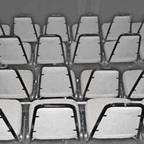
Claude Wampler's PERFORMANCE
Claude Wampler :: PERFORMANCE (career ender) :: The Kitchen, 512 West 19th Street between 10th and 11th Avenues :: November 16-18 (Thursday-Saturday) 7pm & 9:30PM :: Tickets $12 :: Curated by Sarah Michelson.
1906 die brucke 1909 futurism IT 1910 metaphysical painting ecole de paris 1911 blaue reiter camden town group 1913 vorticism rayonism suprematism constructivism 1914 group of seven 1916 dada 1917 de stijl neo-plasticism 1918 novembergruppe valori plastici de ploeg 1919 unovis bauhaus 1924 surrealism 1925 neue sachlichkeit 1940 organic abstraction 1942 lettrism 1943 magic realism 1945 art brut HAS 1946 action painting 1947 tachisme 1948 homme temoin CoBrA 1949 art informel 1950 existential art op art 1952 beat 1954 kitchen sink gutai 1956 pop 1957 situationism international 1958 zero 1959 funk hard edge COME 1960 body GRAV nouveau realisme 1961 conceptual assemblage 1962 fluxus aktionism 1963 post painterly expression 1964 kinetic minimalism 1965 site specific environmental 1967 arte povera lowbrow support-surface TO 1968 photorealism land art 1970 postmodernism feminist 1974 digital graffiti 1976 neo expressionism 1977 mulheimer freiheit appropriation 1978 nuovi nuovi new image painting 1979 transavantgarde figuration libre 1980 demoscene 1981 neo-geo 1986 multiculturalism 1988 britart 1989 slacker patheticism THIS 1990 net art 1992 massurrealism identity art 1994 new beauty 1998 relational aesthetics 1999 festivalism 2002 invisibility 2006 PERFORMANCE
Posted by jo at 11:36 AM | Comments (0)
Carlos Katastrofsky
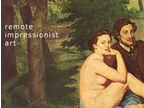
Two New Works
REMOTE IMPRESSIONIST ART: Remote Impressionist Art consists of a webpage with coloured squares in the center. Like a framed picture these colourfields are intended to transfer one principle of impressionism into the digital age: the emphasis on light in its changing qualities. Connected to different webcams in remote parts of the world the colours of the fields are determined by them. The automatic reload every 10 seconds lets you see always newly generated impressionist artworks. This is another free piece, accessible for everyone connected to the net.
CUMPUTER: Where is the art in the process of generating artificial images? Is it the programming of the algorithm generating the picture? Is it the algorithm "at work"? Or is it the result of this work? Is art in this context defined by the artist's choice for one or more of the results or by the interaction between the artist and the machine? All those conditions are possibilites to define the art in generated pictures. Are they art? [from netbehaviour]
Posted by jo at 11:26 AM | Comments (0)
Rosalind - Upstart Media Art lexicon

Needs to be Fed
Rosalind - Upstart Media Art lexicon :: Feed Rosalind with your own words and definitions to express and declare what you are, what you do and the worlds you create, on your own terms. Influence and mutate her, help her to maturity. Your words may: - describe something very particular to your life / experience / work - be invented in a moment of desperation - arise in conversation with others - already be in circulation. Examples:
mociology :: The study of the effect of mobile technology and ubiquitous networks on our social interactions. A combination of mobile and sociology. An important term in the rising world-network that we're all blips in the midst of. Reference : rockngo.org/archives/2006/01/mociology.html :: Added by Jon Beardsley.
Mail listlessness :: Anxiety and ennui due to overwhelming list mail in inbox as a consequence of phobic sense of missing something which is not there :: Added by Patrick Simons.
Glass Roots :: An unacknowledged discriminatory barrier that prevents those minorities privileged by class or financial resources from accessing the source of distributed power or responsibility, as exists within a local community :: Added by ruth catlow.
Alpha Revisionism :: Promoting or 'selling' an audience on a concept/product in nascent (possibly premature) stages in order to create popular sentiment & hype about A given idea, product, or action :: Added by Patrick Lichty.
Telememetics :: Study of how memes transmit over networks, what effect the existence and use of networks has on the spread and uptake of memetic infection I invented the word, it is itself a meme. Reference : www.telememetics.com :: Added by ivan007.
Anna Karenin Function :: A function which returns zero on success and a variety of error codes otherwise source:Zack Booth; Inspired by the first line of Tolstoy's Anna Karenin ("Happy families are all alike; every unhappy family is unhappy in its own way.") i.e. all happy function calls are alike, every unhappy function call is unhappy in its own way :: Added by maya.
D.I.W.O (Diwo's, or Diwo groups) :: Expanded from the original term known as D.I.Y. (Do It Yourself). D.I.W.I.O 'Do It With Others'. Is more representive of contemporary, collaborative - art practice which explores through the creative process of using networks, in a collective manner :: Added by Marc Garrett.
Netropy :: Propriety that implies that through time, the Internet is forced to always become more and more chaotic :: Added by Clemos.
Catechstrophy - a disastrous technology problem or breakdown, particularly used in the context of live art, performance or installation which involves computers :: Added by Neil Jenkins.
Parasitic Media :: "The parasite is the mystical computer glitch. The parasite is the bandwidth thief. The parasite is the invisible usurper. The shift that takes place in the host, if any, is one so gradual the parasite will be able to feed and thrive without detection. The invisibility of the parasite is only through the eyes of its host organism." Reference : www.carbondefense.org/writing_7.html - :: Added by Ryan griffis.
gxxgle - verb- (to gxxgle) :: To search for a search engine that fights censorship in the face of shareholder greed or state pressure. That doesn't contribute to the development of technology used to implement state firewalls see Reporters Without Borders :: Reference: furtherfield.org/boycott.html :: Added by Rosalind. [from netbehavior]
Posted by jo at 11:17 AM | Comments (0)
Centre for Contemporary and Digital Performance
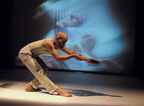
Interactive Performance Series
The Centre for Contemporary and Digital Performance :: Interactive Performance Series autumn 2006 :: School of Arts Brunel University
Wednesday, November 15: Research Performance Seminar, Gaskell Building 117 1-2pm :: Jayachandran Palazhy Director, Attakkalari Centre for Movement Arts, Bangalore, India. The Role of Technology in Choreography, Arts Documentation and Dissemination.
5 - 7:30 pm :: Movement and Media Workshop, BoilerHaus 101 :: Principles of movement from Indian physical traditions such as Kalarippayattu and Bharatanatyam and their application in Attakkalari's contemporary dance idiom.
8:oo pm :: Public Lecture and Film Screening, BitLab :: NAGARIKA :: An Integrated Information System on Indian Physical Expressions through Technology Followed by reception.
The public is invited to participate in this series of encounters, lectures, screenings, physical and new media workshops and discussions, focussed on new thinking in performance practices, interactive technologies, digital and scientific creativity, and cultural production.
Admission free
For more information contact 01895 267 343
Brunel University, Uxbridge, Middlesex, UK
Johannes Birringer
director, Center for Contemporary and Digital Performance
http://people.brunel.ac.uk/dap/condip.html
[from netbehaviour]
Posted by jo at 11:06 AM | Comments (0)
kanarinka bot's
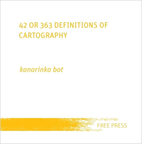
42 or 363 Definitions of Cartography
42 or 363 Definitions of Cartography is a text by kanarinka which attempts 42 or 363 definitions of the term "cartography". None of the definitions are original (i.e. all definitions are stolen). The definitions come from interesting places like cartography journals, Lewis Carroll, other artists, video game sites, cultural theory, Spanish dictionaries, and military training manuals.
Buy print copy at Lulu.com for $11.98 :: Download free book at Free Press.
Free Press by Sal Randolph: 42 or 363 Definitions of Cartography was published via Free Press, an open-access publishing house launched at Röda Sten contemporary art center in Göteborg, Sweden in Fall 2006. A project of artist Sal Randolph, Free Press accepted all kinds of writing from the public; contributions in any language could be as short as a single word or as long as an encyclopedia and could include manifestos, statements, documentations, studies, stories, recipes, poems and whatever you could imagine.
"Even in the age of the internet, book publishing is a walled garden where editors and commercial interests filter out most of what is written," says Randolph. "To publish is to 'make public,' and the published materials of the world create their own kind of public space, a city of books where readers and writers are citizens. Free Press aims to open up access to that public space. Like any city, Free Press is bound to include both ugliness and beauty, though the definitions of each will certainly differ."
All participating manuscripts were published as printed books in the Free Press series, available in the project's library and reading room at Röda Sten, where events and discussions also took place. Additional copies have been placed on shelves in local bookstores and libraries. Readers can download copies from the website and order them at cost from an internet book printer.
The Free Press exhibition took place from September 16 - October 15, 2006 at Röda Sten.
Posted by jo at 10:59 AM | Comments (0)
Medien Kunst Raum Unna
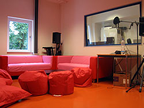
Call for Applications
The Medien Kunst Raum Unna (MKRU) issues a grant addressing the history of new media. We are looking for concepts that address the social consequences of new technologies without necessarily employing high technology. Media artists from Germany and the European Union are called for proposals for works yet to be realized, selected by a professional jury. The proposal shall stand out through the medial and artistic pervasion of the chosen subject, the possibility to be exhibited in the art context and a high level of artistic quality. Additionally to the artistic concept (2-3 pages A4), a proposal (1 page A4) for a one-day workshop with Unna-based teenagers shall be entered.
The grant is awarded with a single amount of 1500 Euros by the Medien Kunst Raum Unna/ Zentrum für Information und Bildung. Material expenses will be reimbursed up to 300 Euros and a publication will be released. The grant holder will be selected from the submitted entries by a professional jury consisting of an artist, a curator and the artistic director of Medien Kunst Raum Unna. The stipends outcome will be presented in Unna. The grant's presenta-tion is combined with a workshop addressing Unna-based teenagers, who thus will get a chance to learn more about (media-) artistic practices.
Eligible are individuals with residence in a country of the European Union. Proposals can be entered in German and English.
Deadline: December 29, 2006, Application form on http://www.mkru.org
Medien Kunst Raum Unna / ZIB
Francis Hunger
Lindenplatz 1
59423 Unna
Germany Tel: 02303-103-731 (Mo/Di)
Fax: 02303-103-799
francis.hunger[at]unna.de
http://www.mkru.org
Posted by jo at 10:47 AM | Comments (0)
November 07, 2006
Ars Virtua Artist-in-Residence (AVAIR):
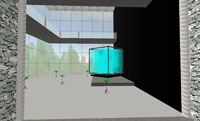
Call for Proposals
Ars Virtua Artist-in-Residence (AVAIR): Call for Proposals :: Deadline November 21, 2006 :: Ars Virtua Gallery and New Media Center in Second Life is soliciting proposals for its artist-in-residence program. The deadline for submissions is November 21, 2006. Established and emerging artists will work within the 3d rendered environment of Second Life. Each 11-week residency will culminate in an exhibition and a community-based event. Residents will also receive a $400 stipend, training and mentorship.
Ars Virtua Artist-in-Residence (AVAIR) is an extended performance that examines what it means to reside in a place that has no physical location.
Ars Virtua presents artists with a radical alternative to “real life” galleries: 1) Since it does not physically exist artists are not limited by physics, material budgets, building codes or landlords. Their only constraints are social conventions and (malleable-extensible) software. 2) The gallery is accessible 24 hours a day to a potentially infinite number of people in every part of the world simultaneously. 3) Because of the ever evolving, flexible nature of Second Life the “audience” is a far less predictable variable than one might find a Real Life gallery. Residents will be encouraged to explore, experiment with and challenge traditional conventions of art making and distribution, value and the art market, artist and audience, space and place.
Application Process: Artists are encouraged to log in to Second Life and create an avatar BEFORE applying. Download the application requirements here: http://arsvirtua.com/residence. Finalists will be contacted for an interview. Interviews will take place from November 28-30.
About Ars Virtua: Ars Virtua is a new media center and gallery located entirely in the synthetic world of Second Life. It is a new type of space that leverages the tension between 3D rendered game space and terrestrial reality, between simulated and simulation. Ars Virtua is a venue for new genres; it is also a platform for showcasing traditional artists creating still and moving images, for instance, who apply scripts to extend these into the synthetic game environment. Ars Virtua maintains a close relationship with the underlying animation engine that enables Second Life architecture and 3D rendered “sculpture.” Ars Virtua brings the art audience into “new media” rather than new media to the museum or gallery, and calls upon its audience to interact with the art and one another via their avatars within the space.
About Second Life: Second Life is a 3D online persistent space totally created and evolved by its users. Within this vast and rapidly expanding place, you can do, create or become just about anything you can imagine. Built-in content creation tools let you make almost anything you can imagine, in real time and in collaboration with others. An incredibly detailed digital body ('Avatar') allows a rich and customizable identity.
URLS:
http://arsvirtua.com/
http://arsvirtua.com/residence/
http://slurl.com/secondlife/dowden/42/59/52/?title=Ars%20Virtua
http://secondlife.com
"AVAIR" is a 2006 commission of New Radio and Performing Arts, Inc., (aka Ether-Ore) for its Turbulence web site. It was made possible with funding from the Jerome Foundation.
Posted by jo at 06:15 PM | Comments (0)
Justin Hall's
Passively Multiplayer Online Games
Passively Multiplayer Online Games is a system for turning user data into ongoing play. Using computer and mobile phone surveillance, a user and their unique history. These resulting avatars can be viewed online, and they interact with other avatars online. Examples of data: web sites visited, email addresses, chat handles, contents of email or messaging, contents of word processed documents, digital images, digital video, video game moves. Examples of avatars: virtual pets, animals, virtual humans, virtual fantasy characters, secret agents, athletes, movie stars, famous people, gangsters, soldiers. Documentation (Quicktime). [via]
Posted by jo at 05:48 PM | Comments (0)
The Play of Imagination:
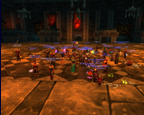
Extending the Literary Mind
"In the past decade, beginning with Ultima Online, a new genre of interactive play has emerged in the form of massively multiplayer online games (MMOGs). These games combine the power of traditional forms of roleplaying games with a rich, textured graphical framework. The result has been the emergence of game spaces which provide players with new and unusual opportunities for learning. As these games become increasingly popular and as they begin to approximate large scale social systems in size and nature, they have also become spaces where play and learning have merged in fundamental ways, where players have become deeply enmeshed in the practices and cultures of interactive play, collaboration, and learning. More important is the idea that the kind of learning that happens in these spaces is fundamentally different from the learning experiences associated with standard pedagogical practice. In this paper, we examine how this new world of games has captured the imagination and how the play of imagination that it engenders yield insights into the way play, innovation, and learning are connecting for the 21st century.
The power of these particular games rests with the way in which they allow players to construct vivid and meaningful “conceptual blends” by taking different worlds (such as the physical and the virtual) and combining them to create new and better ways to understand both the game world they inhabit and the physical world. Where MMOGs differ from other kinds of games is in their deeply social nature. While a traditional “game” remains at the core of MMOGs, the rich social fabric that the game produces blurs many of the boundaries that we tend to expect such as the distinction between the physical and the virtual, the difference between player and avatar, and the distinction between work and play. Further, we argue throughout the essay that the learning that happens in MMOGs is tied to practices, but those practices are not solely the practices of game play or even skills such as resource management. They are, instead, the skills of learning how to use one’s imagination to read across boundaries and be able to find points of convergence and divergence between different worlds to understand their relationships to one another. MMOGs encourage the use of imagination to bridge the gaps and boundaries between worlds to provide a more complete and a more complex understandings of both the virtual and the physical worlds the player inhabits." Continue reading The Play of Imagination: Extending the Literary Mind, Working Paper - September 16, 2006 by Douglas Thomas and John Seely Brown.
Posted by jo at 04:06 PM | Comments (0)
Jane McGonigal

This Might Be a Game
This Might Be a Game: Ubiquitous Play and Performance at the Turn of the Twenty-First Century by Jane Evelyn McGonigal :: Doctor of Philosophy in Performance Studies :: University of California, Berkeley.
This Might Be a Game examines the historical intersection of ubiquitous computing and experimental game design, circa 2001 AD. Ubiquitous computing, or ubicomp, is the emerging field of computer science that seeks to augment everyday objects and physical environments with invisible and networked computing functionality. Experimental game design is the field of interactive arts that seeks to discover new platforms and contexts for digital play. The convergence of these two fields has produced a significant body of games that challenge and expand our notions of where, when, and with whom we can play. This dissertation explores how and to what ends these playful projects reconfigure the technical, formal and social limits of games in relation to everyday life.
To mark the heterogeneity of this experimental design space at the turn of the twenty-first century, I propose three distinct categories of ubiquitous play and performance. They are: ubicomp games, research prototypes that advance the scientific agenda of ubiquitous computing through game design; pervasive games, performance-based interventions that use game imagery to disrupt the normative conventions of public spaces and private technologies; and ubiquitous games, commercial entertainment projects that replicate the interactive affordances of video and computer games in the real world.
I examine seminal games from each of these three categories, including Can You See Me Now? (Blast Theory/Mixed Reality Lab, 2001); the Big Urban Game (The Design Institute, 2003); and The Beast (Microsoft, 2001) respectively. My discussion draws on original gameplay media, design statements, and first-person player accounts. My critical framework is based on close readings of the play and performance values expressed in the founding ubicomp manifestos of Rich Gold and Mark Weiser. I argue that the persistent responsiveness developed by players to potential ludic interaction represents a new kind of critical gaming literacy. The gamers grow to read the real world as rich with ludic opportunity, carefully testing everyday media, objects, sites, and social situations for the positive and negative consequences of inscribing each within the magic circle of play. I conclude by outlining a course for the future study of these categories that is based in the pre-digital games theory of Johann Huizinga, Roger Caillois, and Brian Sutton-Smith. I argue that as the perceived opportunities for digitally networked play become increasingly ubiquitous, game designers and researchers must attend more carefully to the insights of philosophers, anthropologists and psychologists who historically have explored play as an embodied, social and highly consequential ritual, always already grounded in the practices of everyday life.
Download chapters:
1 Introduction: A Ubiquitous Computing Approach to Play and Performance
2 Three Kinds of Everywhere: The Multiple Genres of Ubiquitous Play and Performance
3 Colonizing Play: Citations Everywhere, or, The Ubicomp Games
4 Disruptive Play: Spectacle Everywhere, or, The Pervasive Games
Coming soon:
5 Activating Play: Affordances Everywhere, or, The Ubiquitous Games – Part I
6 Dangerous Mimesis: Simulation and Dissimulation in Alternate Reality Games
7 Power and Superpowers: The Ubiquitous Games – Part II
8 The Collective Play Values of Ubiquitous Games
9 Conclusions: Specifying Play
Posted by jo at 02:39 PM | Comments (0)
neuroTransmitter
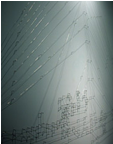
News
neuroTransmitter news: • Beyond Territory: neuroTransmitter -- Henry Art Gallery, Seattle, WA • Ground Control -- Dangerous Crossings, Ortstermine 2006, Munich, Germany • Frequency Allocations (in 3 parts) -– Contested Spaces: Artists and the Urban Environment, Pratt Institute, Brooklyn, NY.
Beyond Territory: neuroTransmitter :: November 10 – December 31, 2006 :: Henry Art Gallery, Faye G. Allen Center for the Visual Arts, University of Washington, 15th Avenue NE and NE 41st Street, Seattle, WA 98195-1410 :: Reception: Thursday, November 9, 2006, 8 – 10 PM.
The artist team neuroTransmitter (Valerie Tevere + Angel Nevarez) works specifically with radio machinations to investigate the history, technology, and current uses of this ubiquitous broadcast format. The two installations at the Henry situate our imaginations inside pirate radio stations of the past. 12 Miles Out, a wire drawing that functions as an antenna for an accompanying radio transmitter, depicts the blueprint of a ship that housed Radio Caroline, a mobile pirate station originating from the waters off the coast of Great Britain. The sound loop heard in the gallery is made up of fragments culled from archival materials originating from the mid-1960s heyday of offshore broadcasts.
Radio City 299-MW (1) refers to Radio City, a station based in abandoned military fortifications in the Thames Estuary off the British coast during this same era. The seven miniature models of the rampart-like towers contain the source of low-power transmissions relayed to the radios on the walls. The four-channel sound composition (also based on archival broadcast materials) occupies the gallery, replicating on a small-scale Radio City’s unauthorized occupation of institutional spaces – the physical architecture as well as the radio frequencies. Both pirate stations transmitted independent shows and rock music in defiance of the BBC’s government-controlled broadcasting monopoly and the heavy corporate sway over music programming.
By reflecting on the influential effects of these repurposed sites, neuroTransmitter proposes locating similar catalysts in our communities today. Their work, whether experienced in museums, over the airwaves, or in the public realm, suggests a reconfiguration of the broadcast spectrum as a space for communication and experimentation, where individual voice and locality take precedence over the homogenizing outcomes of regulation and corporatization. -Sara Krajewski, Associate Curator
Curated by Associate Curator Sara Krajewski and generously supported by the Paul G. Allen Family Foundation and ArtsFund. In-kind support provided by Hotel Max and Hogue Cellars. For more information call 206.543.2281. Contact: Betsey Brock, betsey[at]henryart.org
Ground Control: a project by neuroTransmitter is part of Dangerous Crossings, The Grammar of Tolerance, Ortstermine 2006, Munich, Germany :: 23 September – 19 November, 2006 in public places in the city of Munich/Germany.
Dangerous Crossings consists of twelve artistic interventions in public places in the city of Munich. The Dangerous Crossings projects are bundled into three thematic focal points: the first questions the eye-level at which the involved parties encounter each other, where the issue concerns tolerance. The second examines what is evaluated as a norm, how normalizing establishes and secures itself, and which means of securing are brought into play. The third focal point introduces self-techniques, with which those affected by this normalizing take control of their own situations.
Dangerous Crossings concentrates on two areas of Munich, from the city center up to the southern city boundary. It not only invites visitors to engage the artistic works, but to consider the path between projects. Each work of art offers itself as both a terminating point and intermediate stop of such a route.
A handbook is published by Silke Schreiber Publisher ISBN: 3-88960-087-5
Curated by Farida Heuck, Ralf Homann, Pia Lanzinger.
Artist interventions in public places in the city of Munich/Germany by: Beate Engl, Freie Klasse München, Alex Gerbaulet, Stefano Giuriati & Aldo Giannotti, GSA/Konrad Becker, Alexander Klosch & Oliver Thuns, Klub Zwei / Simone Bader & Jo Schmeiser, Andrea Knobloch, Folke Köbberling & Martin Kaltwasser, neuroTransmitter, raumlabor_berlin, RELAX, chiarenza & hauser & co
Organizer: Kulturreferat der Landeshauptstadt München Abteilung Kulturelle Veranstaltungen und Programme – Kunst im öffentlichen Raum
Contact: Erwin Hartel, Telefon 089/233254 53 erwin.hartel[at]muenchen.de
Frequency Allocations (in 3 parts): a project by neuroTransmitter is included in the exhibition Contested Spaces: Artists and the Urban Environment, Pratt Institute, Brooklyn, NY :: November 3–11, 2006.
The struggle for space is not a new issue among urban artists. The manner in which artists create work in spite of this struggle, however, is constantly evolving. The work, collaborations, collectives, and communities created are directly related to a common trend moving from traditional artistic methods into creative forms of cultural engagement. Some of the work actively addresses the question of what is art but we are posing the question what is the relationship of art to society. Artists in urban environments are often displaced from neighborhoods, pushed out of live/work spaces, and forced to persevere in extraneous circumstances. Many artists use their creative practices to reclaim their city and build communities. Historically there have been many reasons for artist to go to the streets, gentrification displacement being a common trigger, however, this is just one of many social concerns that artists address.
This exhibition deals with a cross section of artists currently working in New York City, but artists across the globe are finding creative ways to activate public space. This exhibition deals with individual artists and collectives whose work is related to concerns with social justice and whose efforts are typically displayed outside the traditional methods of exhibiting art. Our choice to represent here and now will show a real time view of artists reacting to many of the issues brought to the surface through the Art/Space Conference that this exhibition is presented in conjunction with Jim Costanzo & Brynna Tucker, Exhibition Co-Curators.
Participating Artists: Center for Urban Pedagogy, The Danger / Complacent Nation, El Puente, Ryan Watkins Hughes, neuroTransmitter, Not an Alternative, Michael Rakowitz, Duke Riley, Swoon, Lee Walton.
Essays by Alan W. Moore and Gregory Sholette
Curated by Jim Costanzo and Brynna Tucker
This exhibition is presented in conjunction with the conference Art in the Contested City, A Conference Exploring the Role of the Arts in Contemporary Struggles over Urban Space :: November 3, 2006 9 am to 6:30 pm.
For more information about the exhibition and conference
http://www.prattcollaboratives.org/
(1) Radio City 299-MW, commissioned by the Henry Art Gallery, is second in a series of works that examines the repurposed history, architecture, and sonic resonance of Shivering Sands, an installation of abandoned Maunsell Sea Forts initially used by the British military for fortification during World War II. Radio City was one of the pirate stations that occupied Shivering Sands during the 1960’s. For the first work in the series, entitled Offshore, neuroTransmitter consisted of Valerie Tevere, Angel Nevarez, and Lize Mogel. Offshore was produced while neuroTransmitter was in-residence at Eyebeam, New York.
neuroTransmitter
http://www.neurotransmitter.fm/
611 Broadway, Ste. 836
New York, NY 10013
Posted by jo at 02:22 PM | Comments (0)
New Musical Experiences
Reactable
Fantastic next-gen music-making interface - somewhat similar to Jeff Han's Multi-touch interface, which imploded all the interaction design mailing lists a few months back - and with some genuine possibilities for the kind of tactile, embodied instrument interfaces I suggested at the end of New Musical Experiences. [posted by Dan Hill City of Sound]
Posted by jo at 12:30 PM | Comments (0)
Pall Thayer
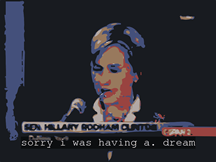
wassup, tYgEr_lil_E?
wassup, tYgEr_lil_E? :: Pall Thayer :: solo exhibition at Pace Digital Gallery :: Nov 15 - Dec 8, 2006 :: Discussion with the artist and Reception Nov 15, 2-4pm :: Pace University, 2nd floor, 163 William Street (between Beekman and Ann Streets), New York, NY.
"Wassup, tYgEr_lil_E?" is an examination of the impact of digital media on abstract art. The title references Woody Allen's film, "What's up, Tiger Lily?" (1966) from which it borrows a simple idea: dubbing a foreign movie's dialogue with completely unrelated text, in an attempt to alter the story. "Wassup, tYgEr_lil_E?" captures images from live video feeds and provides on-screen subtitles with text captured from live Internet chat sessions. Thayer made no attempt to match images to text. Computers have no conscious understanding of the subject material they are being made to appropriate. Therefore the result, being generated by automated computer processes, becomes an abstraction.
Pall Thayer (1968) is an Icelandic artist working with computers and the Internet. He graduated from the Icelandic College of Art and Crafts in Reykjavik, Iceland in 1999 with a background in mixed-media. His work has been exhibited widely at festivals and group shows such as Nordic Interactive in Copenhagen, Transmediale in Berlin, The Boston CyberArts Festival, Hipersonica/File in Sao Paulo and PixxelPoint in Slovenia. In 2004 he organized the Trans-Cultural Mapping: Iceland Inside and Out workshop in locative media for Lorna, The Icelandic Organization for Electronic Arts, of which he is an active member. He is currently pursuing his MFA at Concordia University in Montreal, Quebec.
Posted by jo at 12:05 PM | Comments (0)
DIFFUSION
![]()
eBooks Now Available
SPECIES AND SPACE SERIES: SINGLE STEP GUIDE TO SUCCESS: DAY PLANNING by Heath Bunting :: SPACES AND PLACES OF CONVERGENCE by Anne Galloway :: URBAN TIME TRAVEL: ODD-LOTS AND FLOATING ISLANDS by Lisa LeFeuvre.
ABOUT SPECIES OF SPACES: This publication is one of a series of essays commissioned by Proboscis for the series Species of Spaces – inspired by and in homage to George Perec's eponymous book. The series contemplates how we occupy space in the contemporary world of the twenty-fi rst century – the virtual and physical, emotional and social – what Perec called the ‘infra-ordinary’. Species of Spaces questions the trajectory of contemporary urban existence,intervening in current debates on how the virtual and the physical relate to each other, and how technological advances affect cultural and social structures.
LIQUID GEOGRAPHY SERIES: PATHS FOR A LISTENER: Perhaps it's in a single moment when each of us truly begins listening by Loren Chasse :: NO WORDS by David Key :: CONSTRUCTING PLACE: WHEN ARTISTS AND ARCHAEOLOGISTS MEET by John Schofield :: LANDSCAPE: RETURN • DISPERSAL • CIRCULATION by Kathryn Yusoff.
ABOUT LIQUID GEOGRAPHY: This publication is one of the third Liquid Geography series commissioned by Proboscis. This series was commissioned alongside the Topographies & Tales project in 2005 and 2006, which is about perceptions of place and geography, revealing small local stories against the larger picture of how our concept of space and environment is shaped by physical and aural experience. It involved a series of collaborations and includes a short film, an audio CD, a StoryBox of StoryCubes, two series of Diffusion eBooks and a Creative Lab. This series of books explores these issues with a particular emphasis on language, memory, and aural experience.
DIFFUSION eBooks are shareable paper books that are free to download, print and make up (in A4 and US Letter PDF formats). Designed for viral distribution at almost no cost to readers, Proboscis regularly commissions new writing and creative publications which broaden discussion and debate around themes relating to our own projects and research. Proboscis also provides online design schematics, welcoming anyone, anywhere to adopt or re-interpret the format for their own uses.
Sharing Creativity
By using the internet as the distribution mechanism, DIFFUSION eBooks are accessible to a diverse readership across parts of the world that it would not be economical, or physically possible, to distribute traditional books to. Readers are encouraged to share the eBooks electronically or as material objects. DIFFUSION aims to bridge analogue and digital media by taking the reader away from the computer screen and engaging them in the process of making with their hands. Through the physical act of making the eBook, a dynamic is created that blurs the distinctions between producers and consumers.
DIFFUSION eBooks are designed to be freely available to download and print out. Under no circumstances should any version of this publication, whether print or electronic, be sold by any third party without prior permission in writing from the publisher.
Posted by jo at 11:55 AM | Comments (0)
Transformations: Walter Benjamin and the Virtual

Call for Submissions
Transformations is seeking abstracts for the following issue: Walter Benjamin and the Virtual: Politics, Art, and Mediation in the Age of Global Culture.
What does Walter Benjamin offer for critical thinking and creative practice in an age increasingly mediated by virtual technologies? Much Benjaminian scholarship proposes a Benjamin at best ambivalent to, and at worst, in recoil from modernity. Yet, recent critical thinkers such as Giorgio Agamben and Jean-Luc Nancy provide new possibilities in approaching the analysis of contemporary culture inspired by Benjamin's insights and arguments. These suggest innovative ways of reading and incorporating Benjamin, ways that re-engage an active configuration between politics, art, and representation in response to the shift from mass to global culture.
Increasingly it seems possible to reconsider the role art can, and may be already playing, in such a configuration. This issue of Transformations seeks submissions that address these ideas. In the light of Benjamin's thought, and those who take that thought further, we want to look at what the concept of virtuality- the tendency in mediated contexts towards disembodied interactions and ways of being human -- does to Benjamin's ideas of politics, art, and media?
Call for abstracts: abstracts of 500 words due end of November 2006
Papers due: March 2007
Publication: mid 2007
Submissions should be sent to the Issue editor: John Grech, at
John.M.Grech[at]alumni.uts.edu.au
Or alternatively, to the General editor: Warwick Mules at w.mules[at]cqu.edu.au
For full details please visit the Transformations website.
Posted by jo at 11:37 AM | Comments (0)
Translocations 1:

New Media Practices in the Urban Context
Translocations 1: New media practices in the urban context :: 17th and 24th November 2006 :: Seminar Room, Sarai-CSDS :: Facilitated by Tapio Mäkelä, researcher and artist in residence at Sarai.
This workshop looks at new media practices in urban contexts. The introductory session will take place at SARAI/CSDS seminar room on Friday, November 17th 11.00-13.00/14.00-16.00. Second session on November 24th, same time. Depending on the participants’ interests, there will either be one or two further sessions, also discussing selected readings and media art projects done or developed by the participants. Questions or suggestions, please e-mail tapio[at]translocal.net. Examples include: - public media art projects - media artistic interventions - projects using mobile phones - projects using GPS.
Workshop themes: One of the arguments made in the context of new media arts or Internet related theory is that in particular networked media offers new alternative public spaces. How are these arguments grounded in practice? What constitutes a public space in a given culture, to begin with, and how would new technologies amend or replace them?
Lucy Lippard wrote about lure of the location as a warning of essentialist artist practices about location. Today one can discuss lure of location data – as many artists offer views on urban experience based on location data, which in most cases, is merely indexical about a given location with its rich layers of urban life. Through several examples I will illustrate this new genre of locative art or location based media and discuss it in the context of technological sublime and fetishization of new technologies.
Personal computers, mobile phones, networked servers act as auxiliary memory devices. Also many artistic projects work with archiving, databases, and different ways of creating private or shared memories. How media artists and theorists address memory – and how to relate with the frenzy of creating digital artifacts, digital fever?
To register, please send in a short bio and a paragraph on why you wish to attend the workshop to dak[at]sarai.net by the 12th of November 2006.
Posted by jo at 11:03 AM | Comments (0)
transmediale.07 Award
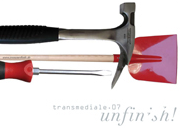
Unfinish!
Nominated for the transmediale.07 Award: Herman Asselberghs (be): Proof of Life ; Tim Shore (uk): Cabinet ; Antoins Schmitt (fr): Still Living :: Honourable Mentions: Aram Bartholl (de): Random Screen ; Richard Chartier / Taylor Deupree (us): Specification.Fifteen ; Kurt D'Haeseleer (be): Scripted Emotions ; Liu Wei (cn): A Day to Remember ; Stefan Zlamal (at): Heinrich und Mary-Jane.
transmediale.07 Award Jury: Inke Arns (Dortmund), Eva de Groote (Ghent), Miguel Leal (Porto), Ellen Pau (Hongkong) und Mike Stubbs (Melbourne).
The 20th transmediale festival for art and digital culture runs under the motto Unfinish!, and takes place from January 31 through February 4, 2007, at the Akademie der Künste in Berlin.
unfinish! demands the re-opening of processes that are deemed closed.
unfinish! questions finality and claims that any given situation is full of potential.
unfinish! investigates artistic processes that are open to change and reversal of decisions.
unfinish! is the battle cry and the curse of digital work that knows no conclusion, but only consecutive versions.
Proof of Life is a 30-minute audio-visual work by the Belgian cultural philosopher and filmmaker Herman Asselberghs. Its images show the interior of a deserted space, while the viewer's attention is directed to the sound track. Spoken words reflect on hostage-taking, and sounds of imprisoned life create a claustrophobic atmosphere, inspiring an intense reflexion about the human condition in the age of migration and global media.
Cabinet, a film by Tim Shore (UK), was shot in the US-States of Montana and Wyoming, a sparsely populated and wild natural environment in which Unabomber Theodore Kaczynski wrote his 'Manifesto' against the industrial society. The sound track uses historical material from newsreels and educational features, even Edison's recording of 'Oh Tannenbaum'. This freely associating film essay reflects on the relationship between nature, culture and power, and on the imaginary space between words and memory.
A thoroughly 'unfinished' work is Still Living, by French artist and programmer Antoine Schmitt: Animated diagrams, similar to the well known graphics used for election analysis and stock exchange rates, are in constant movement - showing autonomously and eternally fluctuating statistics and ratios. While such graphical charts usually promise exact information, in this work they are caught in a nervous game of indecision and permanent alteration.
transmediale.07 - 31 january - 4 february 2007 - festival for art and digital culture berlin.
transmediale - Klosterstr. 68 - 10179 Berlin
tel. +49 (0)30.24749-761 fax. +49 (0)30.24749-814 info[at]transmediale.de - http://www.transmediale.de
Posted by jo at 10:51 AM | Comments (0)
Daniel Langlois Foundation
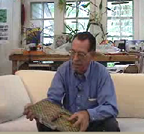
Interview with Per Biorn
Interview with Per Biorn :: During 9 Evenings: Theatre and Engineering, presented from October 13 to 23, 1966, at the 69th Regiment Armory (New York, NY, U.S.), engineer Per Biorn designed technological components to control various elements (projectors, objects, lights) used in the performance Carriage Discreteness by Yvonne Rainer. He also built a number of TEEM decoders and contributed to the development of the Ground Effect Machine, a compressed air module used in Vehicle by Lucinda Childs. Following 9 Evenings, in addition to his work with Bell Telephone Laboratories (Murray Hill, NJ, U.S.), Biorn continued to design and build technological components for numerous artists. He also restored a number of works of art.
This interview with Mr. Biorn, produced by the Daniel Langlois Foundation, was taped on August 25, 2004, in Berkeley Heights (NJ, U.S.). Present at the interview were Julie Martin, Vincent Bonin and Éric Legendre. The interview has been divided into chapters to facilitate navigation and listening
Posted by jo at 10:30 AM | Comments (0)
November 06, 2006
Shop for the Holidays
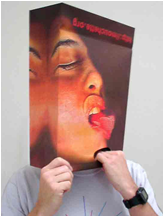
And Support Networked_Performance at the Same Time!
It’s not too early to start your holiday shopping! And you can support Turbulence’s networked_performance blog at the same time! [WE CANNOT CONTINUE TO PROVIDE THIS SERVICE WITHOUT YOUR HELP.] Please go to our website and make a donation today. Choose from artists’ books, drawings, DVDs, CDs, archival prints, T-Shirts and more by Annie Abrahams, Kate Armstrong, Diane Bertolo, Andy Deck, Onomé Ekeh, Jason Freeman, Tal Halpern, Peter Horvath, David Jhave Johnston, kanarinka, Brooke A. Knight, Steven Lam, Patrick Lichty, Michael Takeo Magruder, Michael Mandiberg, microRevolt, Mouchette, MTAA, Andrea Polli, Preemptive Media, Gustavo Romano, Yoshi Sodeoka, Nathaniel Stern, Helen Thorington, and Jody Zellen. Or simply make a donation.
Turbulence is celebrating its first DECADE, the only program to consistently commission net art for ten consecutive years. Despite the expansion of our projects, the acceleration of our support for artists, and the valuable resources we provide in our networked_performance blog and New American Radio archive, we have seen a decline in our operating support. Please help us to continue to support emerging artists and technologies, and preserve our valuable archives. THANK YOU.
Posted by jo at 07:36 PM | Comments (0)
Upgrade! New York
![]()
tobias c. van Veen + Trace Reddell
Upgrade! New York :: tobias c. van Veen + Trace Reddell :: Friday, Nov 10, 7:30 PM :: Eyebeam, 540 W. 21st Street, (bet 10th & 11th Ave).
tobias c. van Veen and Trace Reddell will perform and discuss their new audio works. tobias will be poking his head into the aether of the airwaves to perform a short interpretation of AUTOSEVOCOM TACSAT and will give a taste of the as-yet unreleased audiowork FOIL.
AUTOSEVOCOM TACSAT explores surveillance frequencies of encoded police
channels against a backdrop of low-end sound composed from fragments of real
and virtual war-torn landscapes. FOIL. A blend of urban recordings from a peaceful Western city with its modernist though unpeaceful counterpart in Beirut falls prey to explosive interventions in EA's BattleField 2 online wargame, eventually detonating itself into the debris of alterity.
Trace will be performing his new live cinema work, “somaticosmos.” In the "somaticosmos," cosmic dissonances intersect with bodily pulse and flow, situating human experience within a barometer of galactic conditions. Noisy space transmissions give way to lush and alien terrains, occasionally disrupted by streams of microscopic rhythms and staticky beats. The visual performance melds the techniques of live VJ projections and digital lumia with the cosmic cinema of Jordan Belson.
tobias c. van Veen is doctoral candidate in Philosophy & Communication Studies at McGill University and a practitioner of the technology arts. He is contributing editor at FUSE and Concept Engineer at La Société des arts technologiques (SAT), where he curates Upgrade Montréal. Since 1993 he has disseminated work in sound, radio & net-art, performing and intervening with laptop and turntables, renegade soundsystems and interventions of inscription [controltochaos.ca]. His writing has been disseminated worldwide. He also mixes a mean absynthe martini [quadrantcrossing.org/blog].
Trace Reddell is a digital media artist and theorist exploring the interactions of multimedia production, networking technologies, media theory, literary criticism, space rock and ambient music, and the history of drug cultures. Over the past two years, Trace's live cinema performances and video works have screened at over thirty international venues, and his net.art and audio projects have appeared regularly on the Web since 1999. Trace is Assistant Professor of Digital Media Studies at the University of Denver, and the graduate director of the M.A. in Digital Media Studies. He founded Denver’s first digital media festival, A:D:A:P:T, in Spring 2003 at Denver’s Museum of Contemporary Art. He edits the “music/sound/noise” content at Electronic Book Review and is the producer of Alt-X Audio.
Upgrade! is an international network of gatherings concerning art + tech + community.
About our partner: Eyebeam supports the creation, presentation and analysis of new forms of innovative cultural production. Founded in 1997, Eyebeam is dedicated to exposing broad and diverse audiences to new technologies and media arts, while simultaneously establishing and demonstrating new media as significant genre.
Posted by jo at 03:08 PM | Comments (0)
Mario's Furniture 2

Players Actualized in Real and Virtual Space
Mario's Furniture 2 is an installation and interactive game created by Hillary Mushkin and S.E. Barnet. Instead of sitting on the couch, players have to move the couch, and the whole living room too!
In this wireless environment, viewers become players, physically moving objects of conflicting human and miniature scales, while racing against the camera's ceaseless panning. The opponents' goal is to maintain the illusion of perspective and the integrity of the mise-en-scene within the gaming space. Time and space become mutable in correlation to virtual gaming apparatuses.
The body of the player is actualized in real and virtual space simultaneously. Playing Mario’s Furniture involves strenuous physicality, parodying conventional video games in which avatars are put in peril while players sit on a couch. Mario’s emphasizes how camera and screen effect the construction of social relationships. Players see themselves (and not a stand in) under the camera’s scrutiny, humorously mirroring the absurdity of living within the frame.
Video. See it at TELIC, Los Angeles, until December 2, 2006. Related: the Nintendo Amusement Park aims to build a life-sized game of Super Mario Brothers that you jump through in real space; xBlocks is a mixed-reality video game that you can play on a sculpture and Shigureden: the Nintendo-powered Museum. [blogged by Regine on we-make-money-not-art]
Posted by jo at 09:55 AM | Comments (0)
Regine Debatty's interview with
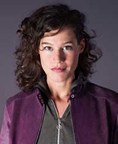
Agnes Meyer-Brandis
"...I discovered (Agnes Meyer-Brandis's) work by chance while clicking from a festival website to another. I was a bit puzzled to be honest. Elfs? Vertical Breezometer? Mobile borehole? In February things got a bit clearer when I saw one of her installations, SGM-Iceberg-Probe, which won an award at Transmediale.
Meyer-Brandis' background is both in science and art. Her work combines pure science and creativity to explore the zone between fact and fiction, fantasy and technology. Her current focus is on “fantastic” augmented reality and other participatory urban interventions.
She also holds a teaching position at the university of applied sciences Düsseldorf, is frequently lecturing at other universities and conferences and seems to tour the world to receive awards. She is the founder of the "Forschunsgfloss / Research Raft for Subterranean Reefology”, a small institute whose chief aim is to explore and confirm subterranean phenomena." More >> [blogged by Regine on we-make-money-not-art]
Posted by jo at 07:50 AM | Comments (0)
November 03, 2006
Mizuko Ito on
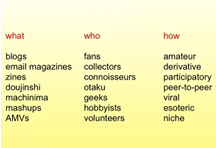
Amateur Cultural Production in the New Networked Age
Mimi Ito’s talk is entitled "Amateur Cultural Production in the New Networked Age." She is a cultural anthropologist who studies new media use, particularly among young people in Japan and the US. She is currently co-leading a multi-year project on Digital Kids and Informal Learning, with support from the MacArthur Foundation. As part of this project she is conducting case studies of anime fandoms in Japan and the English-speaking online world. She is a Senior Fellow at the Annenberg Center for Communication.
As part of last year's Networked Publics program at the Annenberg Center, Ito and her research colleagues have been examining the changing relationship between cultural production and consumption. They have looked at the ways that many-to-many distribution, peer-to-peer social organization, and the availability of low-cost digital authoring tools have lowered thresholds to cultural production "manifest in public culture as increased visibility and mobilization of those actors traditionally associated with cultural consumption." They see three domains "growing in salience with the turn toward networked public culture: 1) amateur and non-market production, 2) networked collectivities for producing and sharing culture, 3) niche and special-interest groups, and 4) aesthetics of parody, remix, and appropriation." More >> [posted by Howard Rheingold on DIY Media Weblog]
Posted by jo at 05:27 PM | Comments (0)
A Swarm of Angels
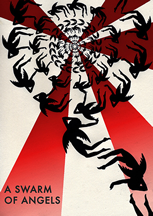
Remix Cinema
Want to Remix Cinema? You can help invent the future of film by joining the Swarm in creating a £1 million pound film and giving it away to over one million people in one year. By using the Internet as a medium to fund, help make and distribute this film A Swarm of Angels wants to remix cinema.
A Swarm of Angels is a new way to create cult film. The project is a giant new media experiment to gather 50,000 people paying £25 each to create a new type of movie. This feature film and associated original media embraces the flexible digital-age copyright of Creative Commons, because we want people to freely download, share, and remix the original media made for this project. You can remix and use the film for any non-commercial purposes. You can also use parts of it for your own commercial work, under our additional Sampling Plus clause.
"A Swarm of Angels is an attempt to bridge the top down auteur-driven world of cinema with the bottom-up networked world of open source and the Internet, creating a fully financed feature film to be released under a Creative Commons non-commercial license. But if the finished film can be distributed freely upon release - why will anyone bother paying to see the end result? Well instead, people pay to be part of the process of creation. £25 gets you membership of the Swarm, and you can start voting on scripts, posters and production, while discussing decisions and direction directly with Matt himself. It's no small task, and Hanson seeks 50,000 angels / £1m to make the project, which he will write and direct, a reality, with just under 1000 signed up to date. That said, given the high production values shooters can produce on no budget when working together, open source stylee, one cam imagine something substantial being created with a tenth that many people." From "MATT HANSON: From onedotzero to Open Source filmmaking in A Swarm of Angels" by Nicol Wistreich, Netribution.
Posted by jo at 04:56 PM | Comments (0)
The Trinity Session
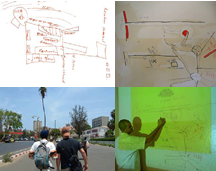
UrbaNET – Hillbrow / Dakar / Hillbrow
Inspired by encounters with francophone immigrants in Hillbrow (a neighbourhood of Johannesburg’s inner city, notorious today for its state of urban decay and influx of African immigrants) Stephen Hobbs and Marcus Neustetter (for their contribution to the Dak’Art Biennale ‘Off’ Programme) interviewed a group of Senegalese immigrants asking them to draw maps of Dakar, which Hobbs/Neustetter used to navigate the city during their two week residence in May 2006. The culminating exhibition at the Ker Thiossane residency space in Dakar presented a series of wall paintings and stills projections that reflected on the interactions and engagements resulting from navigating Dakar on foot and visiting colleagues and friends of the Senegalese immigrants.
Returning to Johannesburg, the project has been featured at the “Sightings / Site-ings of the African City” conference held at the Wits Institute of Social and Economic Research in June, and a project page has been commissioned for the September 2006 issue of Art South Africa. The project returned to the Senegalese Immigrants as an audio-visual presentation and action-reflection session (on the comparative findings between Johannesburg and Dakar) held at Chez Ntemba night-club in Hillbrow.
UrbaNET – Hillbrow / Dakar / Hillbrow will find its conclusion in a drawing, photography and video installation in Johannesburg in 2007. Download: project visuals.
Posted by jo at 03:53 PM | Comments (0)
Arts Council England, London

'The Art Of Playing Games'
The Art Of Playing Games: 14th November, 1.00pm (12.30pm lunch).
2 Pear Tree Court, Clerkenwell :: Hosted by Arts Council, London, and the LDA.
You are warmly invited to lunch at Arts Council England, London for the 'Art Of Playing Games'. This latest event is part of the Digital Culture Lunchtime talks series looking at the impact of new technologies on different artforms.
Many of you came to the fantastic Hari Kunzru talk, organised with Literature, and we continue our series with 'The Art Of Playing Games'. This time we'll consider gaming as it crosses over into theatre and visual Arts, and as a 'cultural industry' in its own right. We are extremely pleased to present a sparkling panel of gaming experts including:
Dave Green - Technology correspondent for the Phil Jupitus breakfast show on BBC 6Music and authority on web gaming :: Conrad Bodman - Our own Senior Officer who curated 'Game On' at Science Museum :: Tim Wright - digital writer and trAce contributor will present various ways of playing on the web :: Producers for Coney - facilitating a mysterious experimental theatre project.
This panel is assembled following the recent London Games Festival and Tom Campbell from the LDA will discuss the Fringe element that was supported by the LDA and Arts Council, London.
There will also be two artworks displayed in Reception from the recent Furtherfield show 'Gameplay'. 'Endless Forest' by Tale Of Tales 'Facade' by Michael Mateas and Andrew Stern.
Tuesday 14th November
12.30 lunch
1.00pm talks begin.
Rehearsal Room, 2 Pear Tree Court.
Rachel Baker
Visual Arts Officer, Media Arts and Moving Image
Arts Council England, London
Direct line 020 7608 6176
Fax 020 7608 4100
Mobile 07779 650908
Email rachel.baker[at]artscouncil.org.uk
www.artscouncil.org.uk
Posted by jo at 11:35 AM | Comments (0)
State of Emergency Election Night
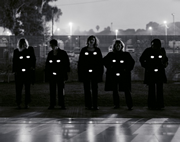
Video, Slideshows, Ripped from the Headlines
Special State of Emergency Election Night SCREENING: Tuesday November 7, 8:30PM - 11:00PM :: Video projections in the window of Alias Restaurant at the southeast corner of Clinton & Rivington (NYC).
Provocative program newly updated in the run-up (stumble-up?) to the election: against the war, against the ever-deepening devastation of democracy, against the manufactured State of Emergency in which we live. Video, slideshows, ripped-from-the-headlines images and texts skewering Congressional sleaze, the anti-immigrant hysteria, the cable news hustle, super-patriotism, nuke bomb sites, global biochemical contamination, etc. Participating artists include Mary Kelly, Alan Sekula, Yvonne Rainer, Jenny Lion, Sherry Millner & Ernest Larsen, Michael Mandiberg, Louis Hock, Gregory Sholette, and Leslie Thornton along with many local contributors...
Special Throw-The-Rascals-Out drinks and snacks available at Alias :: Contact: Ernie Larsen 212-604-0231 or elarsen3[at]aol.com. [blogged by Joy on Newsgrist]
Posted by jo at 11:01 AM | Comments (0)
Déplacements
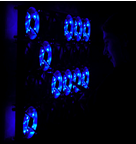
The game of life
Déplacements, by Manuel Braun, consists of 24 computer case fans forming a rectangle. Each fan is a “pixel”, its number of revolutions and the intensity of the light of its LED varies according to the level of gray corresponding to the pixel of reference. This screen of fans is controlled by a computer simulating a cellular automata entitled “The game of life” (created by John Horton Conway in 1970). It is a mathematical model where each fans is a cell. "Displacement" is a hijack of this object, a component of the computer becoming image. It is not a question of a physical “displacement” but of a movement, a flow. [via] [More >>]
Posted by jo at 10:33 AM | Comments (0)
Turbulence Commission:
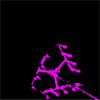
"Cell Tagging" by Brooke A. Knight
Turbulence Commission: Cell Tagging by Brooke A. Knight :: The mobile phone occupies a space that is both connecting and distancing. Seemingly ubiquitous, it has become an increasingly powerful tool, functioning as a phone, PDA, browser, and camera. With "Cell Tagging" it becomes a remote control that allows users to dial, draw, and speak. After dialing the number posted on the website, users are asked to enter a zip/city code that is significant to them. An aerial map of that place loads onto the screen. After choosing a color and brush size from the palette, users can use their cell phone keypads to draw directly onto the map. They are asked to speak into the phone and say why that place and drawing is meaningful to them. Users can save their drawings to the "Cell Tagging" database where others may view them. Cell phone users "graffiti" the sound-space around them, making every place their own. "Cell Tagging" literalizes this act of marking.
"Cell Tagging" is a 2006 commission of New Radio and Performing Arts, Inc., (aka Ether-Ore) for its Turbulence web site. It was made possible with funding from the LEF Foundation.
BIOGRAPHY
Brooke A. Knight is an artist and educator who has been working with digital media for over a dozen years. He has exhibited in over 40 international and regional venues, including Art Interactive, Photographic Resource Center, Mediaterra 2001, and Experimenta 02. His current areas of interest include webcams, the landscape, and text in all forms. Knight’s writings have been published in Art Journal and Sandbox. He is an Assistant Professor in the Department of Visual and Media Arts at Emerson College, where he teaches classes in interactive media.
Posted by jo at 10:20 AM | Comments (0)
THE WISHING TREE
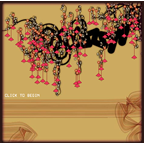
Blends the Cutting-Edge with the Ancient
THE WISHING TREE: Boredom Research, a leading artist duo from Bournemouth have constructed an innovative interpretive new forum. Visitors to the website of Lancaster digital arts organisation folly will be among the first in the world to use the new generation of online forum.
The new message-board interface is based not on text, but is an interactive digital drawing of a "Wishing Tree". The inspiration is from the Lam Tsuen Wishing Trees in Hong Kong where visitors make a wish by writing it on yellow paper which they tie to an orange. They then throw it up high into the wishing tree and try their luck at getting it to hang on one of the branches. If the wish hangs in the tree it will come true; if not the myth claims you have made your wish too greedy.
The message board Java applet f.wish faithfully reproduces the process of creating and throwing one's wish into the tree. Users are also able to virtually tug other people's messages off of the tree to read and respond to them.
"The whole interface is beautiful and creates a new kind of experience for the web" said folly's Artistic Director Kathryn Hughes. "With f.wish, we have attempted to reinterpret the notion of the message board to inspire our users to reflect more fully on their online communication."
The project is also being augmented by the distribution of Chinese fortune cookies, which hold paper messages directing people to the site.
boredomresearch are Southampton-based Vicky Isley and Paul Smith. They interrogate the creative role of computing, producing beautifully crafted software art that presents a fresh approach to our technologically fraught lives. The duo are interested in engaging communities online through contemplative and rewarding experiences.
Posted by jo at 09:04 AM | Comments (0)
Museum of Contemporary Art, Chicago
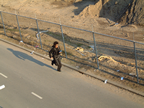
Can You See Me Now?
Blast Theory will present Can You See Me Now? at Museum of Contemporary Art, Chicago this November: Performance Dates: November 2nd, 3rd, 4th and 5th from 1 - 4 p.m. (CDT). Can You See Me Now? is a chase game played online and on the streets. Players are dropped at random locations into a virtual map of Chicago. Tracked by satellites, Blast Theory's runners appear online next to your player. The runners use handheld computers showing the positions of online players to guide them in the chase.
Use your arrow keys to flee down the virtual streets, send messages and exchange tactics with other online players. An audio stream from Blast Theory's walkie talkies lets you eavesdrop on your pursuers: getting lost and out of breath on the real streets. If a runner gets within 5 metres of you, a sighting photo is taken and your game is over.
Can You See Me Now? is a collaboration with the Mixed Reality Lab, University of Nottingham. It won the Golden Nica for Interactive Art at Prix Ars Electronica and was nominated for a BAFTA Award.
Posted by jo at 08:34 AM | Comments (0)
EFA Gallery
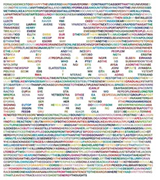
The Searchers
The Searchers :: curated by Molly Dilworth and Amoreen Armetta :: Artists: Nuno Cera, Ann Craven, AC Dickson, Joan Grossman, Lucien Samaha, Jenny Vogel; with artist publications by Bill Brown, Gabriela Forcadell and Alejandro Cesarco, LTTR, Josephine Meckseper, Aleksandra Mir, Lone Twin, Pruess Press
“For academics to be happy, the universe has to have form by contrast, to assert that the universe does not resemble anything at all and is merely formless amounts to saying that the universe is something like a spider or spit.” – Georges Bataille, from Documents
Last year, I moved into a really small apartment so I started selling my books on eBay, and going to the library instead of buying new ones. At first, when someone bought a book from me I just mailed it to them. But then I sold my Bataille collection to Robert from Traverse City, Michigan, and tucked this note inside:
Dear Robert,
I’m lucky enough to be familiar with Traverse City since my parents live right next door in Elk Rapids. It was at the Traverse City Cherry Festival that I saw a bunch of teenagers tip over a porta-potty with someone in it. I really don’t remember who it was that rolled out, I remember the crowd, though––some people laughed. But I could tell that the kids were surprised they did it. There wasn’t as much shit as you might imagine.
They didn’t get away––the cops were watching along with everyone else, and made them apologize. I think they actually were sorry.
Anyway, enjoy Traverse City and the books.
On the day I wrote to Robert, I looked at about a hundred raincoats online, searching for the kind I used to wear when I lived in Seattle. It felt like being in a musty thrift store on a weekday afternoon, way in the back corner where the junk piles up––just you, the cashier, and the absence of so many other people. Months later, I began to read about people everywhere tucking letters into books, and sending them to strangers. It was happening on eBay—proof that people longed to hold something from someone else in their hands.
I’m part of the small, stubborn group who still attempts to read the Times on the subway––I don’t even fold it up to make it more manageable, I like being inside its pages. A few days ago, I was on the train behind my newspaper, reading the latest eBay story:
Generation Net: Log on, Join in, Drop out
eBay has rapidly absorbed hundreds of experimental communities who use it as a real space friending system. These communities form an eBay subculture who interact in real space by trading mailed letters and objects, as opposed to the real time interactions that happen on the rest of the site, and on other popular sites like MySpace. eBay began as a commerce site, but these new communities quickly began to barter rather than purchase, giving rise to the multiple-instance, real space exchanges referred to as friending. According to the Pew Internet and American Life Project, eBay-based real space interactions are up 34% this year; multiple-instance exchanges, where two or more people make long-term, repeated exchanges have not yet been tracked.
The eBay real space special interest group, in a post on its eBay community homepage, has defined these terms: “In real space, a structure’s parameters are formless, molded by users’ desires, rather than the cognitive boundaries of the programmers designing it.” The utopian hopes of the real space group are too rosy for some, however. “Friending is a backlash to blogging, but there’s already a friending backlash forming.” said ‘anonymous’ in a post to the group’s feedback forum. But many experts disagree, “Backlash has ceased to be a useful term here,” noted ‘professore’ (who is contractually bound to remain anonymous while posting to a blog) in a recent thread on lifestudies.org, Harvard’s Life Studies blog, “as one friending system apes another, not as a reaction to, but a mirror of. Both [communities] spread like a virus, multiply like an infestation…
I turned down the corner of my paper, and saw this woman across from me staring. I looked away. I looked back but she was still staring, her book on her lap, the edges of her mouth arranged in a smile. Then I noticed: the muffled sounds from two people’s iPods had synched up. As we stared at each other shyly, one song became audible rather than two dissonant, fuzzy beats. It lasted for almost a minute and no one else seemed to notice.
It stopped. I snapped the wrinkles out of my paper, and put my head back inside its pages.
"An imaginary room rises up around our bodies, which think that they are well hidden when we take refuge in a corner." -- Gaston Bachelard, The Poetics of Space
That night, I navigated eBay by the illumination of a small strand of Christmas lights. The noise from the street filtered up two stories, so I put headphones on. I didn’t plug them into anything, I just stuck the jack in my pocket so I heard nothing but the blood rushing through my ears. Looking straight ahead at the screen, I saw the lights hanging in the windows to my right and left. They were bright, blurry orange spots blowing out the edges of my peripheral vision. I leaned back as far as the keyboard would allow, and absently grasped the cords below between my bare toes.
Later, I picked up a library book. Its soft, powdery pages smelled like wood, it said:
“It is all right to speed ahead into the desert leaving no trace.”
Someone had drawn an arrow from this sentence to the margin where they had written:
Things that leave no trace: absence, ghosts, energy, thoughts.
The Searchers is an exhibition, a library of artist publications, and a series of performances that will take place in the gallery multiple times during the exhibition.
Drawing on conventions established in Dario Argento’s groundbreaking Horror film, Suspiria, The Lost Soul by Nuno Cera shows a woman’s transformation from zombie to a ghost.
Ann Craven’s Moon Paintings confront the impossibility of ever reproducing an object perfectly. Craven paints the moon again and again from observation, adding into each painting something she remembers from the previous painting.
AC Dickson eBay PowerSeller is the alter ego and eBay screen name of artist Andrew Dickson, who with Susan Beal, uses PowerPoint, video, music, audience interaction, and evangelical zeal to spread the good word about how you, too, can achieve financial independence with eBay.
Joan Grossman’s lecture, Meditations on Amnesia, brings together filmmaking and critical writing to explore the intricacies of memory: loss of memory, amnesia, and accidental memory through video clips, archival footage, anecdotal and theoretical musings.
The Disposable Homosexual by Lucien Samaha is a slide show archive of his wanderings around gay male chat rooms, cruising and conversing with the men who get to know each other—or each other’s screen presences—in these virtual spaces.
Your Lips Are No Man’s Land But Mine, is the result of Jenny Vogel’s navigation thorough the twilight world of abandoned Web cams. She exposes screen shots of people and landscapes that seem to have forgotten that they are being broadcast around the Internet.
On view in the Library: dream whip by Bill Brown, LTTR No. 1: Lesbians To The Rescue, Masterbox by Gabriela Forcadell and Alejandro Cesarco, FAT magazine by Josephine Meckseper, The Church of Sharpie by Aleksandra Mir, Of Pigs and Lovers by Lone Twin, and The Lyrics of Ludacris by Pruess Press.
November 10, 2006 – January 6, 2007 :: Opening Reception, November 10, 6-8 pm :: AC Dickson: eBay PowerSeller! Dec 12 – 14 :: Lecture by Joan Grossman December :: Closed for holidays December 23 – January 2 :: EFA Gallery / EFA Studio Center, 323 West 39th Street, 2nd Floor, New York, NY 10018 bet 8th and 9th Aves, Wed. through Sat., 12-6 PM and by appointment.
The Searchers is a collaboration between artist Molly Dilworth; and Amoreen Armetta, Managing Editor of Art on Paper. The Searchers catalog and wall texts were designed by Lance Wakeling.
This exhibition is presented by The EFA Gallery, a program of the Elizabeth Foundation for the Arts. With additional support from The Milton and Sally Avery Foundation, The Helen Keeler Burke Charitable Foundation, Peter C. Gould, Materials for the Arts, and Carnegie Corporation Inc.
The EFA Gallery is a curatorial project space. Through the gallery, The Elizabeth Foundation for the Arts supports the creative work of independent scurators. Curators build the framework in which we understand artists and the art they make. At their best, they redefine how we look at culture. The Elizabeth Foundation for the Arts believes in the essential importance of art in a civil society. The value of the artist's creative spirit is not limited by age, race, nationality or acceptance by others.
For further information:
Elaine Tin Nyo, Director
T. 212-563-5855 x203, F. 212-563-1875
gallery[at]efa1.org
Posted by jo at 08:17 AM | Comments (0)
November 02, 2006
Institute for Infinitely Small Things
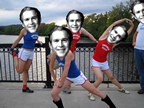
Impeach Bush Jogging Circus
The Impeach Bush Jogging Circus :: When :: Sunday, November 5th around 12 noon but probably a little later :: Where :: Around Mile 17 (1st & 66th St, Manhattan) of the NYC Marathon.
Our friends at the Impeach Bush Jogging Circus bring you a mobile carnival dedicated to acts of wonder, entertainment and astonishment all accomplished while moving approximately 7 miles per hour and doing cartwheels for a GWB-Free USA. Jugglers, Joggers, Clowns, Hula Hoopers and a 10+piece jogging kazoo band are running the NYC Marathon as a team on Nov 5th, 2006. Bring IMPEACH BUSH signs and wear red, white and blue to show your support for the legal case against George W. Bush.
Be our friend, Buy our stuff: Visit the circus' myspace page for pictures and fashionable athletic wear. Join in: Can you juggle and jog or flip and skip? Email the circus at theimpeachbushjoggingcircus[at]gmail.com.
The Institute for Infinitely Small Things is a research organization whose mission is to invent and distribute new practices of political engagement in everyday life. Current research interests include: performing corporate language in public space, creating definitions of cartography, destabilizing consumer architectures, hacking maps and lying to people about art.
iKatun's mission is to present and support contemporary art that fosters public engagement in the politics of everyday information. To realize this mission, iKatun supports art projects, organizes exhibitions and conferences, publishes critical writing, runs workshops, gives lectures and fosters community locally and internationally. iKatun is a 501(c)3 organization based in Boston, MA.
Posted by jo at 03:03 PM | Comments (0)
Extra-ordinary Experiences:

A Retrospective of British Media Art
Extra-ordinary Experiences: A Retrospective of British Media Art :: Venue: Kunsthaus Dresden, Germany :: Dates: 10-19th November 2006 :: Curated by: Tom Corby.
This unique exhibition presents an overview of British media art, covering a period from the early 1990s to the present day. Work by the selected artists - Susan Collins, Rod Dickinson, Mongrel, Scanner and Thomson and Craighead - enables German audiences to explore a representative range of sound, Internet, video and interactive works, symptomatic of British media art produced during this era.
Whilst media art in the form of video, photography and other expanded time-based practices, precedes the widespread emergence of the desktop computer and Internet, the artworks seen at this exhibition places the computer as central to their form. This fact, while brute, allows us to draw a useful line between these digital "new media" practices and the older analogue media art forms. This period is significant in British art history as it describes a radical shift in creative investigation that opened up extensive new areas of practice (in the form of the Internet and human-computer interactivity) and also produced new economies of art production and distribution.
In particular a new type of artist was emerging in the UK who was quick to confront and exploit the new ways of working and communicating described by the emerging technological landscape. Characteristically informed by an iconoclastic punk "Do-It-Yourself" attitude, these "new media" practices were informed by a desire to circumnavigate mainstream art institutional contexts and an interest in re-situating new media within wider debates concerning the social, political and aesthetic implications of such technologies. Following this theme, the exhibition selects a diverse range of practitioners, who are united by a consistency of approach in which technology becomes a pliant vehicle for creative invention which is, in turn, critically motivated, poetic, playful, and formally complex.
Posted by jo at 12:28 PM | Comments (0)
EXPERIMENTA 2007
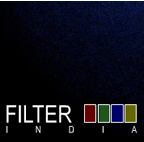
Call for Entries
EXPERIMENTA is an international film and video festival held in Bombay, India for the past 4 years; now in its 5th year, EXPERIMENTA 2007 moves to Bangalore. EXPERIMENTA seeks films from any country that challenge popular and conventional modes of cinema. Abstract to obscure compositions from any genre produced on the margins of contemporary screen-culture are welcome.
Innovative, cutting edge and non-traditional work that attempts to aesthetically extend the parameters of the mediums of film and video is encouraged. Preview copies must be submitted for selection purposes. All lengths of film are considered. Submissions are reviewed on a rolling basis until the final selection is complete. Filmmakers are encouraged to submit their entries as soon as possible.
EXPERIMENTA is a curated film festival and is a Filter India project.
To type in and print out a submission form, visit: http://www.filterindia.com/callexp07.htm.
Posted by jo at 12:23 PM | Comments (0)
club to club

International Electronic Music and Arts Festival
club to club: International Electronic Music and Arts Festival, 6th edition :: 9-10-11 November 2006 :: Turin (Italy) - Berlin (Germany) :: Different locations
Club To Club is the electronic music and arts festival that every year transforms into a big dancefloor the whole city of Turin: a circuit of clubs and different locations (Accademia Albertina delle Belle Arti, Fondazione Sandretto Re Rebaudengo, Hiroshima Mon Amour, Jam Club, Supermarket in Turin and Watergate in Berlin - for the new project Club Europa) hosts a selection of top Italian and international dj's, musicians and performers, exclusive international multimedia shows and productions, workshops and special events.
code_in_motion :: For 6th Club TO Club edition, TODO, a creative team exploring the uncharted territories of interaction, entertainment and communication, dedicates the electronic arts section of the Festival to 'code', presenting a selection of projects that share the same attitude towards performative tools, yet with a wide range of visual results. An approach that highlights the process of writing custom software as the foundation of personal and original universes of synthesis.
code_in_motion performances:
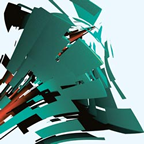
Friday, November 10
SUPERMARKET
Viale Madonna di Campagna 1, Torino
00.00 - 04.00
SANCHtv (France): French designer David Dessens has realized some of the most interesting experiments on 3D real-time motion graphics: complex organic surfaces are built tinkering with math formulas, transforming music into a pure movement of color. He now lives in Frankfurt, where he is artist in residence at Meso.net.
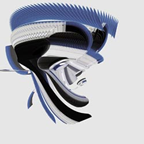
Friday, November 10
JAM CLUB
Murazzi del Po, Torino
00.00 - 04.00
ONOXO (Croatia): Onoxo is an experimental media design project realized by Croatian Vedran Kolac, vj and motion designer, member of the collective Strukt Visual Network. Since 2002 he is mainly engaged in video and graphics production, and in the research on generative visuals with tools as Flash and vvvv. His live generative visuals show an organic dimension contaminated by cold architectures in movement.

Friday, November 10
HIROSHIMA MON AMOUR
via Bossoli 83, Torino
00.00 - 04.00
TODO (Italy): At Club To Club 2006 TODO presents FACE2FACE2FACE, a live media performance that uses and abuses dancefloor's faces as its only material. The faces will be transformed and animated using a repurposed version of the Blender GameEngine, an open-source tool that is commonly used to develop 3D videogames.
Posted by jo at 12:08 PM | Comments (0)
Upstage Performance
![]()
Students' Performances
The students' performances on Friday 3 November will begin at 5.30pm
NZ time (just to give them a bit more preparation time ... ).
There'll be live links from here - and there's a link to a time converter on that page as well.
Helen Varley Jamieson: helen[at]creative-catalyst.com
http://www.creative-catalyst.com
http://www.avatarbodycollision.org
http://www.writerfind.com/hjamieson.htm
Posted by jo at 11:20 AM | Comments (0)
November 01, 2006
The Library Project:
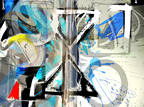
A Networked Art Experiment
As he recently reflected upon here, Alex Itin has long been working at the border zones of art forms, moving in recent years to the strange intersection of paint and pixels. His blog is one of the most wildly inventive uses of that form, combining blazing low-res images of his paintings with text, photographs, short films, animated GIFs and audio mashups. All of this is done within the constraints of the blog's scroll-like form -- a constraint which Alex embraces, even relishes. I sometimes imagine the scroll endlessly emitting from Alex's head like tape from a cash register, a continuous record of his transactions with the world.
ITIN place has been on the web for nearly two years now. In his second year, Alex began to explore new avenues out of the blog, establishing a presence on social media sites like Flickr, YouTube, Vimeo (a classier YouTube) and MySpace. Through these networked rovings, Alex has found a larger audience for his work, attracting new "readers" back to the blog where the various transmitted videos and images are reassembled in the scroll. He's also established relationships with a number of other artists making interesting use of the web, particularly on Flickr and Vimeo. Recently, Alex invited a number of folks from the Flickr community to participate in a collaborative art project -- a kind of exquisite corpse game via post. Here's Alex:
The idea is that one artist takes a hardcover from a book, tears out the pages and draws in one half (or half draws in both halves) of the binder/diptyque. In a nod to Ray Johnson, the two books are mailed (swapped) and Each of these will be finished by the other. The results are posted in a Flicker group called (what else) The Library Project. From this group, hopefully a show will be curated for New York, or Paris, or Basel, or Berlin, or wherever anyone wants to show this project. It should be deliciously portable... get working...get collaborating...get reading!
As of this writing, the Library has racked up 278 members and has 205 images in its pool. A few of these are collaborations that have already made their trek across land, sea and air, others are purely digital combinations, while still others are simply book-inspired works submitted in the spirit of the project. More >> [posted by ben vershbow on if:book]
Posted by jo at 06:48 PM | Comments (0)
Turbulence Commission:

[meme.garden]
Turbulence Commission: [meme.garden] by Mary Flanagan, Daniel Howe, Chris Egert, Junming Mei, and Kay Chang :: [meme.garden] is an Internet service that blends software art and search tool to visualize participants' interests in prevalent streams of information, encouraging browsing and interaction between users in real time, through time. Utilizing the WordNet lexical reference system from Princeton University, [meme.garden] introduces concepts of temporality, space, and empathy into a network-oriented search tool. Participants search for words which expand contextually through the use of a lexical database. English nouns, verbs, adjectives and adverbs are organized into floating synonym "seeds," each representing one underlying lexical concept. When participants "plant" their interests, each becomes a tree that "grows" over time. Each organism's leaves are linked to related streaming RSS feeds, and by interacting with their own and other participants' trees, participants create a contextual timescape in which interests can be seen growing and changing within an environment that endures.
The [meme.garden] software was created by an eclectic team of artists and scientists: Mary Flanagan, Daniel Howe, Chris Egert, Junming Mei, and Kay Chang.
[meme.garden] is a 2005 commission of New Radio and Performing Arts, Inc., (aka Ether-Ore) for its Turbulence web site. It was made possible with funding from the Warhol Foundation for the Visual Arts. Additional support from the PSC-CUNY research fund.
Posted by jo at 04:18 PM | Comments (0)
Participate in
Nothing Happens, Act 3
in which a chair falls....
Posted by jo at 09:52 AM | Comments (0)
1001 nights cast 501st Performance
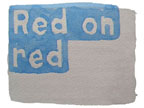
Call for Stories
1001 nights cast turns 501 this Friday 3 November. This is the half way milestone of the project. To celebrate the event I am calling upon newcomers everywhere to submit a story for that day. I will select the best to perform or I may even do a montage of several stories. So please spread the word to your writer friends.
If you want to tune in on Friday night, the live webcast will be at 7.25pm from Sydney. That is 4.25pm in Perth, Manila, Hong Kong and Singapore; 10:25am in Beirut, Jerusalem and Istanbul; 9:25am in Madrid, Paris and Berlin; 8:25am in London and Portugal; 3:25am in New York, Toronto and Bogota; 12:25am in Los Angeles.
You might like to listen to The Book Show on ABC Radio National on Thursday 2 November at 10am when I perform one of Anne Brennan's stories and she and I talk to one of the producers about the project. There will also be a piece in the arts pages of the Sydney Morning Herald on Friday 3 November (so I'm told).
Meanwhile, here are some statistics about the project to date: 133 writers have contributed since performance #0001 on June 21 2005. Together they have written about 425,000 words. At the average novel length of 80,000 that is more than 5 novels worth, all archived on the site for you to read. To this point, the site has had 23,780 visits. Currently, it is getting an average of 63 visits/day. Stories have been performed from Paris, Singapore, Sydney, Canberra, Brisbane, Melbourne, London, Madrid, Granada and a property outside of Dungog, New South Wales (thanks to a satellite dish).
On the sobering side, I have read reports every day covering contemporary events in the Middle East in order to give writers their writing prompt. To recap on some of the things that have been told to us by journalists working for western media outlets: The coalition forces in Iraq have found no weapons of mass destruction and Saddam Hussein is still on trial for genocide. Meanwhile more than 100 Iraqi civilians are killed every day - many more if the report in The Lancet is to be believed (and why should it be discounted - the investigators were shown death certificates after all). There are now wars within wars in Iraq with no clear "strategies" for resolution. Former prime minister of Lebanon, Rafic Hariri, was assassinated, his killers still at large and Syria's involvement pointed to and denied. Hamas won the January elections in Palestine and for their voting sins, the US and Israel continue to enforce an economic blockade. The new Kadima party won the Israeli elections in March without the intellectual presence of its figurehead Ariel Sharon who still lies in a coma. Before this, some of the Israeli settlements in the West Bank were evacuated and bulldozed. Mahmoud Ahmadinejad has come to power in Iran and has been denying any sinister nuclear intentions ever since, much to the frustration of Washington who still refuses to have direct talks with Tehran. Condoleeza Rice has been earning lots of frequent flyer points. And freshest in our minds is the five week Israeli/Hezbollah conflict with cluster bombs lying unexploded in the fields of southern Lebanon. In reading through all these reports, I have implemented my own kind of self-censorship. It may give you some comfort to know that I do not draw any writing prompts from straight reportage of beheadings, suicide-bombings or body counts. To quote from story #495, I would feel like a "lammergeyer in Tyre". --Barbara Campbell
Posted by jo at 09:42 AM | Comments (0)
Networked Objects & The Internet of Things
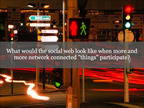
What happens when 1st & 2nd Life mash up?
Here are slides from my keynote at the Cross Media Week "Internet of Things" session. The talk itself was more extemporaneously authored from an outline and notes than written, but the slides capture the major conceptual beats.
Keynote Outline: From a Social Web to a Internet of Things: What happens when 1st Life & 2nd Life mash up?
Main Points: a. the digital communications network known as the Internet is an instrument of social engagement & exchange, and its instrumentalities (devices, databases, routers, web servers) are part of that social engagement & exchange. When other kinds of objects are "hooked-into" that network, they are caught up in the messy imbroglio of the social life of the internet.
If this is the case, then we should consider these objects as not inert objects, but social actors that shape and inform the kind of discourse that happens on these networks. So, i will refer to the various and diverse social actors amongst these networks (internet, intranet, whatever) variously as "participants", social actors, social objects, and so forth. The reason is to emphasize that anything and anyone within the network has a role to play in the creation of social life of various kinds. More >> [blogged by Julian Bleecker]
Posted by jo at 09:11 AM | Comments (0)
Colour by Numbers
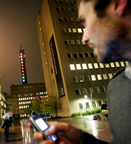
Control the Light with your Phone
Colour by numbers is a 72 meters high light installation at Telefonplan in Stockholm. "A tower stands at Telefonplan. Austere, slim and dark; rising towards the sky like an exclamation mark. A tower is an archetypical creator of place: it breaks in and becomes an event in a continuous landscape. This characteristic is emphasized by the illuminated windows of this particular tower - but the patterns and colours also vary constantly. The tower speaks in a sign language composed of light. But what is the tower at Telefonplan saying, and who gives the architectonic form meaning?". On the website under live video you can see a live video image of the tower and also read instructions for how to control the light installation over the phone.
Until November 5 the video image is also projected on the façade of the Culture House in Stockholm, as part of the exhibition "Stockholm bygger ".
Colour by numbers is a collaboration between the artist Erik Krikortz, the architect Milo Lavén and the interaction designer Loove Broms. [posted on Interactive Architecture]
Posted by jo at 08:08 AM | Comments (0)

